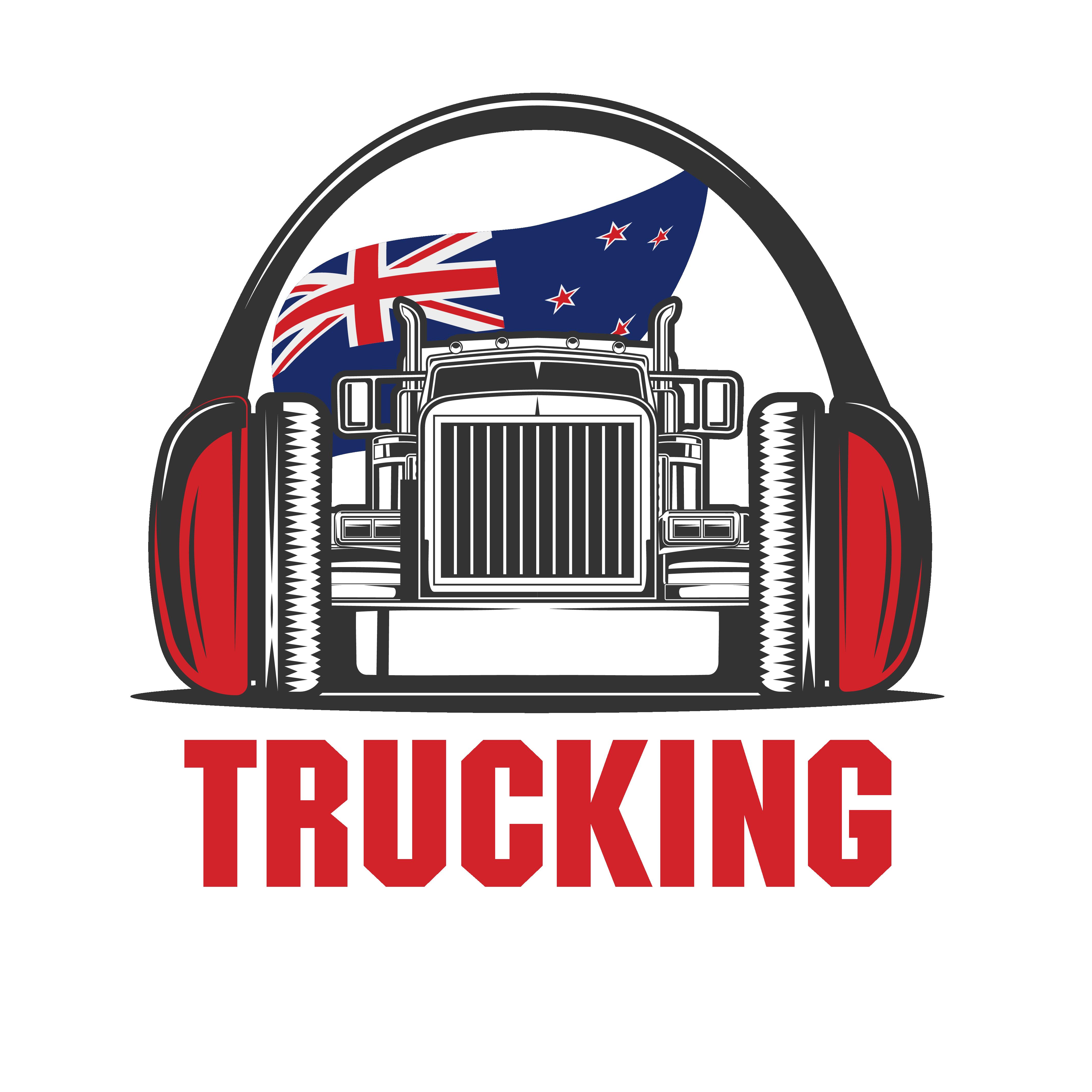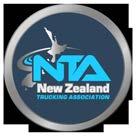

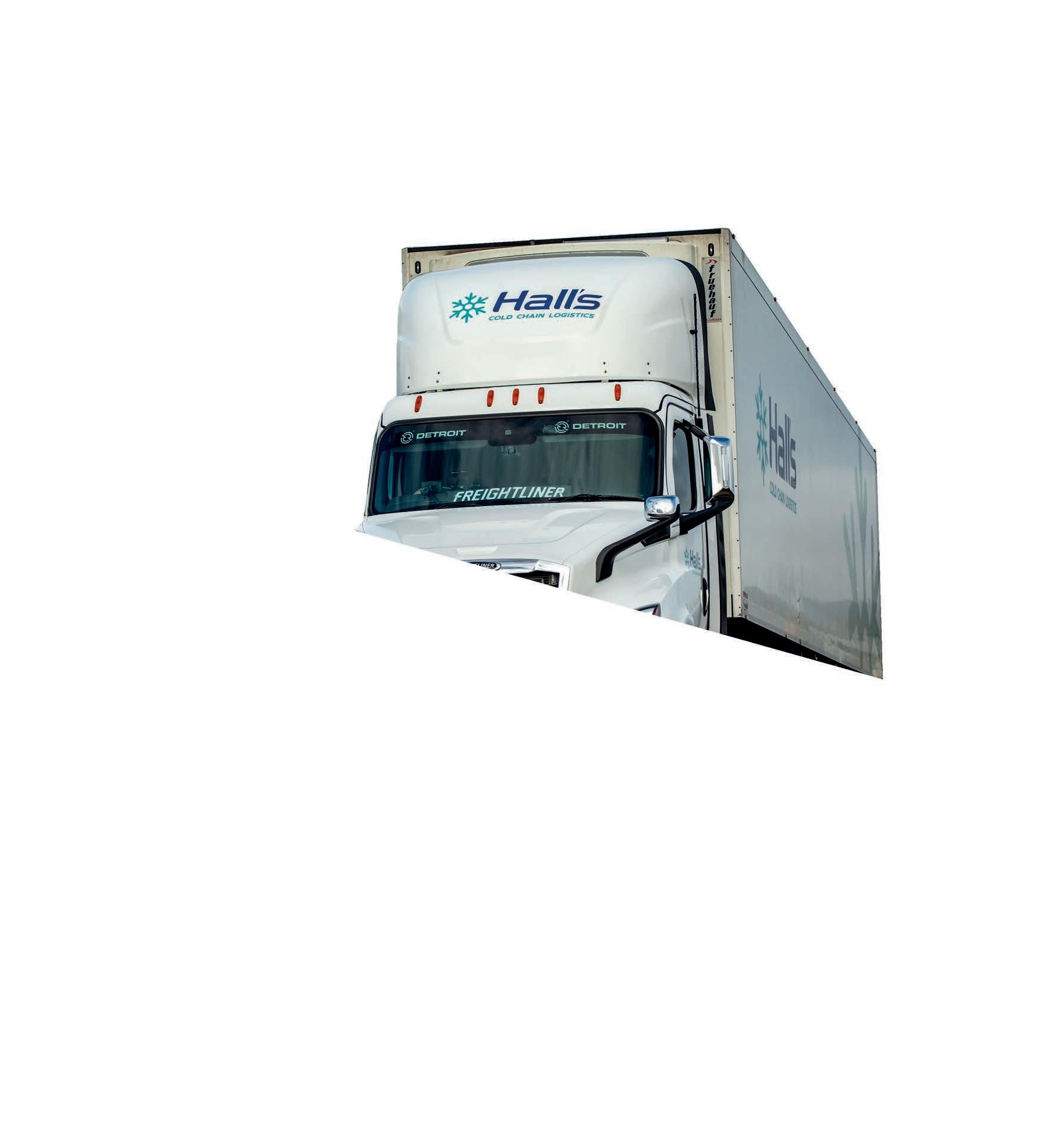

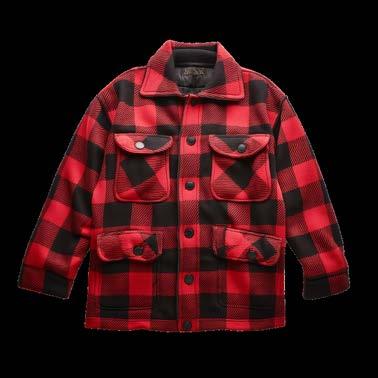












For the second year running the results are in and we couldn’t be happier. Scania has once again been voted the number one* truck brand in the country by the people whose opinion we value the most - New Zealand truckies.
We’re chuffed to have rated highest on all measures, including most preferred, comfort, safety, sustainability, performance, efficiency, service and parts. Thanks again New Zealand. It means a lot.


EDITORIAL
Dave McCoid
Ph: 027 492 5601
Email: dave@nztrucking.com
EDITOR Gavin Myers
Ph: 027 660 6608
Email: gavin@nztrucking.com
For all advertising enquiries:
ADVERTISING MANAGER
Pav Warren
Ph: 027 201 4001
Email: pav@nztrucking.co.nz
Mike Devon
Ph: 027 332 4127
Email: mike.devon@nztrucking.co.nz
Maddy McCoid
Ph: 027 336 6811
Email: maddy@nztrucking.co.nz
SUB





Further
6
One
1

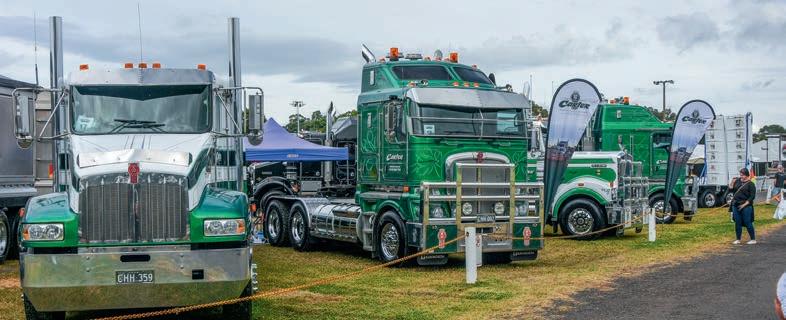









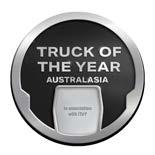



Budgets, pothole funds and speed reviews … It’s been a busy month for those interested in roads or transport.
By now, Finance Minister Nicola Willis’ Budget 2024 announcement on 30 May has been dissected to exhaustion. The industry has salivated at a full $1 billion for the accelerated delivery of the Roads of National Significance and major public transport projects, as well as a further $939.3 million to continue recovery works to roads damaged by last year’s severe weather events.
I commented on these and other notable allocations in my EDM editorial of 31 May, Bouncing around the billions. As good as the funding is for the industry and road users in general, I go back to my main concern outlined in that piece – support for Interislander remains conspicuous by its absence. I’ll save you the effort of seeking it out, because the point bears repeating … Interislander is as much a part of the country’s transport infrastructure as any of the Roads of National Significance or any KiwiRail trunk line. Clearly, though, little thought has gone into replacing the ageing barges in the time since the new government axed the

iReX project after coming into office.
Yes, other pressing commitments need their share of the pot. But it’s as much a transport issue as it is to do with infrastructure and resilience – so why not fund it in part from each of those budgets? And if needed, the argument could also be made for it being a climate-change initiative – new boats will doubtlessly be more efficient and environmentally friendly than the old clunkers that have each done about 100,000 trips across the Strait, according to Interislander.
It’s been said before, the longer this ferry-replacement debacle is kicked down the road, the greater the threat to safe and efficient passage between the islands becomes.
But what of safe and efficient passage within the islands? We’ve been told that the forthcoming 2024-2027 National Land Transport Programme (NLTP) will deliver a record $2.07 billion for state highway pothole prevention and $1.9 billion for local roads – respective increases of 91% and 50% over the 2021-2024 NLTP. This appears to be in addition to the establishment of a $500 million Pothole Prevention Fund, as promised in National’s electioneering campaign
– though, the announcements have come so thick and fast, how the funding all fits together is a little murky … I guess we’ll have to wait for the final Government Policy Statement and NLTP to reveal all.
Regardless, the key here is that this funding will be ringfenced for resealing, rehabilitation and drainage maintenance works. This is encouraging, considering Transport Minister Simeon Brown expects long-term maintenance outcomes of 2% of the state highway network renewed each year and 9% of it resealed each year … This with requirements that potholes will be fixed within 24 hours. I’m not sure how they’ll make that a reality, but this might just be the time to get into the roadworks game!
And we’ll need roads maintained to such a degree if the higher speed settings proposed in the new Land Transport Rule come to fruition. But I’ll reserve comment on that for another time.
Eagle-eyed readers will notice a small but significant change to the cover of New Zealand Trucking magazine from this issue on – the phrase, ‘Telling Road Transport’s Story Better than Anyone Else.’ Every good company needs a strong mission statement, and this is the one we have adopted to underpin all New Zealand Trucking Media brands – New Zealand Trucking magazine, Little Trucker Down Under, Trucking Radio 24/7, the Keep on Moving podcast, and Truck and Light Commercial Trader Everything we do is encompassed in that statement. Every story we tell, news item we share, or advertisement we run is in its pursuit. It guides our team internally, but to truly live it, we must make it our promise to you. And so, it’ll be as visible as we can make it.
Thanks as ever for your support of all our brands. We hope we continue to live up to the promise.
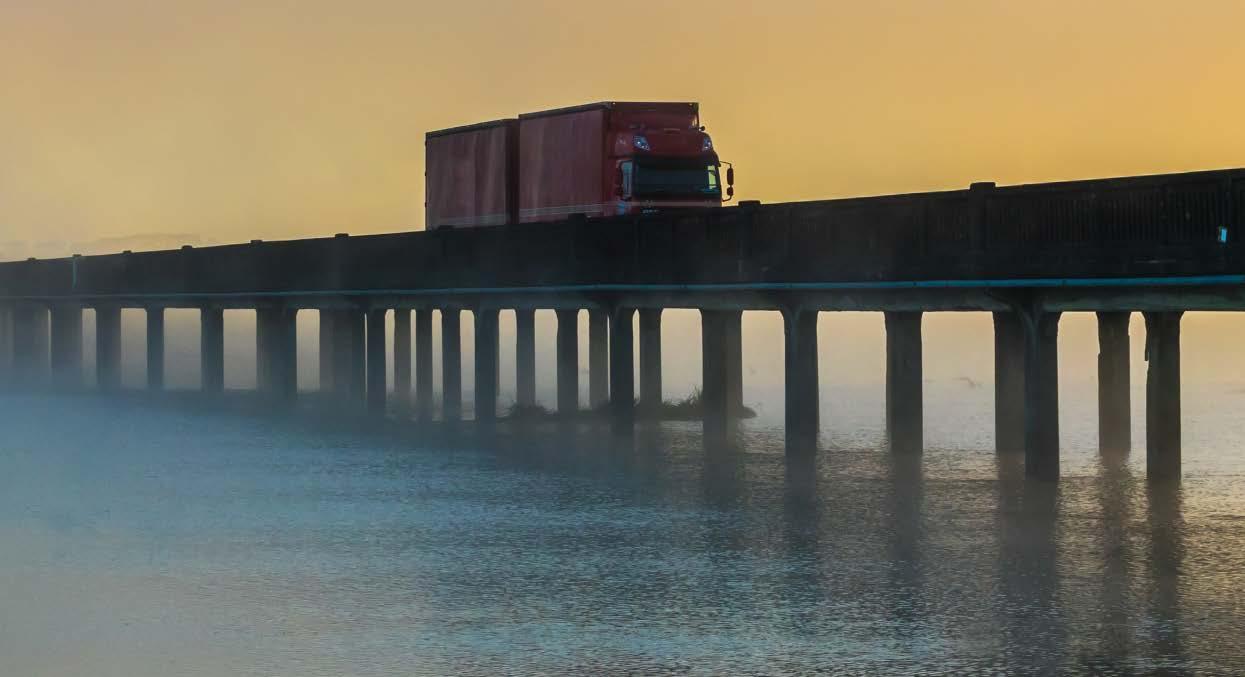


Gavin Myers Editor






The M729II Eco is the successor to the M729 and Ecopia M749 drive tyres. Its development represents another step towards Bridgestone’s evolution as a sustainable solutions company.
The M729II Eco is the successor to the M729 and Ecopia M749 drive tyres. Its development represents another step towards Bridgestone’s evolution as a sustainable solutions company.
The M729II Eco is the successor to the M729 and Ecopia M749 drive tyres. Its development represents another step towards Bridgestone’s evolution as a sustainable solutions company.
The M729II Eco is the successor to the M729 and Ecopia M749 drive tyres. Its development represents another step towards Bridgestone’s evolution as a sustainable solutions company.
Available sizes
Available sizes
Available sizes
Key Features
Key Features
Key Features
Key Features

• M729II Eco delivers the market leading wear life of the M729 with a 20 percent lower rolling resistance, while also boasting the benefits fuel saving and emissions reductions.

• M729II Eco delivers the market leading wear life of the M729 with a 20 percent lower rolling resistance, while also boasting the benefits fuel saving and emissions reductions.
• M729II Eco delivers the market leading wear life of the M729 with a 20 percent lower rolling resistance, while also boasting the benefits fuel saving and emissions reductions.
• M729II Eco delivers the market leading wear life of the M729 with a 20 percent lower rolling resistance, while also boasting the benefits fuel saving and emissions reductions.
• Delivers industry-leading wear life and durable reputation with up to 10 per cent better wear life than its predecessor.
• Delivers industry-leading wear life and durable reputation with up to 10 per cent better wear life than its predecessor.
• Delivers industry-leading wear life and durable reputation with up to 10 per cent better wear life than its predecessor.
• Delivers industry-leading wear life and durable reputation with up to 10 per cent better wear life than its predecessor.
• Contributes to a reductions in C02 emissions through reduced fuel.
• Contributes to a reductions in C02 emissions through reduced fuel.
• Contributes to a reductions in C02 emissions through reduced fuel.
• Contributes to a reductions in C02 emissions through reduced fuel.
Your Local Expert
Your Local Expert
Auckland Central, Auckland North and Northland
Auckland Central, Auckland North and Northland
Auckland Central, Auckland North and Northland
Bay of Plenty and Gisborne
Bay of Plenty and Gisborne
Bay of Plenty and Gisborne
Rodney Wallace 021 220 2466
Auckland Central, Auckland North and Northland
Rodney Wallace 021 220 2466
Rodney Wallace 021 220 2466
Rodney.Wallace@bridgestone.co.nz
Rodney Wallace 021 220 2466
Rodney.Wallace@bridgestone.co.nz
Auckland South and Waikato
Rodney.Wallace@bridgestone.co.nz
Rodney.Wallace@bridgestone.co.nz
Auckland South and Waikato
Auckland South and Waikato
Trevor Bunyan 021 718 861
Christchurch, Nelson, Marlborough and West Coast
Trevor Bunyan 021 718 861
Rodney Morkel 027 216 3734
Bay of Plenty and Gisborne
Trevor Bunyan 021 718 861
Trevor Bunyan 021 718 861
Christchurch, Nelson, Marlborough and West Coast
Christchurch, Nelson, Marlborough and West Coast
Trevor.Bunyan@bridgestone.co.nz
Trevor.Bunyan@bridgestone.co.nz
Trevor.Bunyan@bridgestone.co.nz
Trevor.Bunyan@bridgestone.co.nz
Wellington, Wairarapa, Manawatu, Hawke’s Bay and Taranaki
Wellington, Wairarapa, Manawatu, Hawke’s Bay and Taranaki
Wellington, Wairarapa, Manawatu, Hawke’s Bay and Taranaki
Christchurch, Nelson, Marlborough and West Coast
Michael Sharpe 027 582 0682
Michael Sharpe 027 582 0682
Michael Sharpe 027 582 0682
Michael Sharpe 027 582 0682
Michael.Sharpe@bridgestone.co.nz
Michael.Sharpe@bridgestone.co.nz
Michael.Sharpe@bridgestone.co.nz
Canterbury, Otago and Southland
Michael.Sharpe@bridgestone.co.nz
Evan Armstrong 021 190 4929
Rodney Morkel 027 216 3734
Auckland South and Waikato
Rodney Morkel 027 216 3734
Rodney Morkel 027 216 3734
Wellington, Wairarapa, Manawatu, Hawke’s Bay and Taranaki
Rodney.Morkel@bridgestone.co.nz
Rodney.Morkel@bridgestone.co.nz
Rodney.Morkel@bridgestone.co.nz
Rodney.Morkel@bridgestone.co.nz
bridgestone.co.nz
bridgestone.co.nz
bridgestone.co.nz
bridgestone.co.nz
Evan Armstrong 021 190 4929
Evan Armstrong 021 190 4929
Evan.Armstrong@bridgestone.co.nz
Evan Armstrong 021 190 4929
Evan.Armstrong@bridgestone.co.nz
Evan.Armstrong@bridgestone.co.nz
Evan.Armstrong@bridgestone.co.nz
Canterbury, Otago and Southland
Canterbury, Otago and Southland
Paul Robertson 027 274 3437
Paul Robertson 027 274 3437
Canterbury, Otago and Southland
Paul Robertson 027 274 3437
Paul.Robertson@bridgestone.co.nz
Paul Robertson 027 274 3437
Paul.Robertson@bridgestone.co.nz
Paul.Robertson@bridgestone.co.nz
Paul.Robertson@bridgestone.co.nz

Daimler Truck brands Mercedes-Benz Trucks and Freightliner will soon have a general distributor locally in New Zealand.
Keith Andrews Holdings, which currently has the distribution rights for FUSO vehicles and parts through its wholesale organisation FUSO New Zealand, will soon take over the distribution of fellow Daimler Truck brands Mercedes-Benz Trucks and Freightliner.
Currently, Mercedes-Benz Trucks and Freightliner vehicles are distributed in New Zealand by Daimler Truck Australia Pacific based in Mulgrave, Victoria.
Daimler Truck Australian president and CEO, Daniel Whitehead, said the distribution change would benefit New Zealand customers.
“The general distributor model will deliver the best outcome for Daimler Truck customers in New Zealand because no one knows local customers better than locals,” said Whitehead.
“The team at Keith Andrews has helped FUSO become a successful brand in New Zealand and we are confident they will enable Mercedes-Benz Trucks and Freightliner to reach their full potential.”
As a Daimler Truck Regional Center, Daimler Truck Australia Pacific will continue to provide support to New Zealand customers by delivering the best-in-class technology, products and services to Keith Andrews and its New Zealand dealer network.
Keith Andrews Holdings executive director, Kurtis Andrews, said the team was looking forward to serving all Daimler Truck customers across New Zealand as the distributor for Mercedes-Benz Trucks and Freightliner brands,
in addition to FUSO products.
“We are delighted to be given the opportunity to take on the distribution of Mercedes-Benz and Freightliner trucks in New Zealand. From our role of selling and supporting these brands over many years, we know how much value customers can extract from these class-leading products.
“We’d like to thank Daimler Truck for its faith in our hard-working team at Keith Andrews, which is excited to show the full potential of the amazing Daimler Truck products in New Zealand,” Andrews added.
Currently, Keith Andrews represents Mercedes-Benz Trucks and Freightliner retail in the North Island, and CablePrice represents the two brands in the South Island.
To deliver all New Zealand customers the full benefit of the general distributor appointment, Keith Andrews Holdings is working with CablePrice regarding the ownership and operation of selected FUSO, Mercedes-Benz Trucks and Freightliner sales and service sites in the South Island (see sidebar).
Keith Andrews Holdings aims to maintain all existing operations and personnel to determine a smooth transition and maintain the current high level of customer support.
“CablePrice has been a fantastic partner of Daimler Truck in New Zealand and we are thrilled they will continue to provide their exceptional customer support at a number of their existing locations,” Whitehead said.
The exact details of the distribution change will be finalised and communicated closer to implementation, which is expected sometime early next year.
Following the appointment of Keith Andrews Holdings as general distributor across the Daimler Truck brands in New Zealand from early 2025, discussions have now moved to the future direction of the dealer network.
Currently, Keith Andrews represents Mercedes-Benz Trucks, Freightliner and FUSO in the North Island, and CablePrice represents the three brands in the South Island.
To deliver all customers the full benefit of the general distributor appointment, Keith Andrews Holdings is now working with CablePrice on the sale and acquisition of selected South Island Daimler Truck sales and service sites.
Discussions are currently focused on CablePrice’s Christchurch, Tīmaru and Dunedin truck dealerships, with remaining dealerships maintaining their Daimler Truck service and parts (2S) status as part of CablePrice.
“The CablePrice team has achieved great success with FUSO in particular and been an integral part of market-leading truck and bus sales efforts in the past three years,” said Keith Andrews Holdings executive director, Kurtis Andrews.
“We are thrilled by the prospect that they will continue to provide fantastic customer support in the mainland, either as part of CablePrice or Keith Andrews.”
CablePrice managing director, Aidan Mahony, said: “I am extremely proud of what our team has achieved since becoming the South Island dealer for Mercedes-Benz, Freightliner and FUSO trucks, and I believe all customers will benefit from having a New Zealand-based and -focused general distributor.”
Andrews and Mahoney said their teams and customers will be kept updated as the transition progresses.
“Keith Andrews Holdings and CablePrice aim to maintain all existing operations and personnel to ensure a smooth transition and a high level of customer support.”




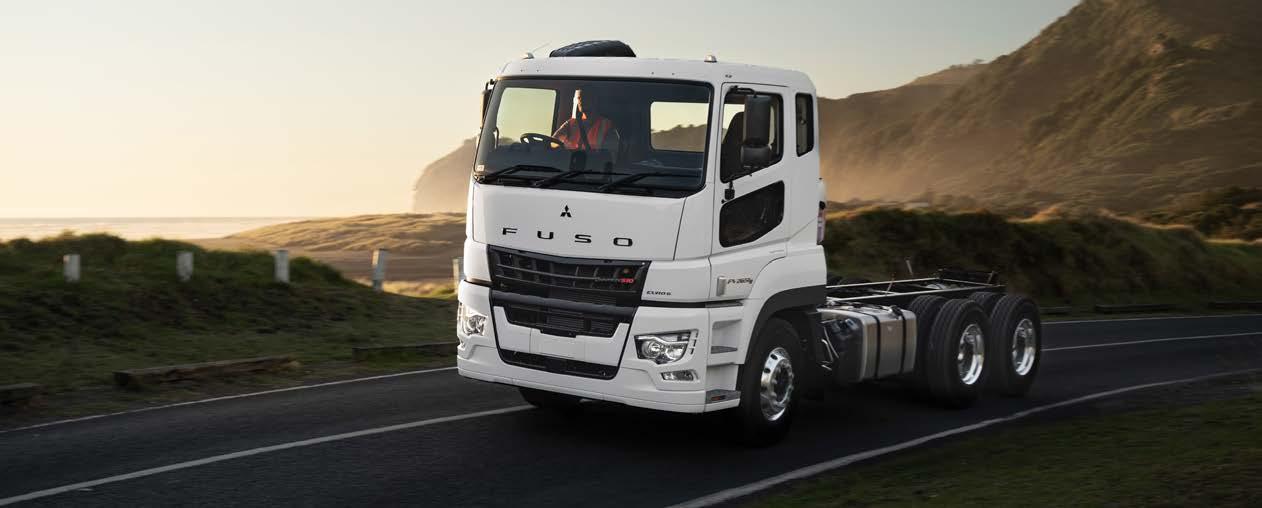



















•
•































•
•
•







Mack Trucks is launching its most powerful drivetrain yet, as the allnew Euro-6 range is revealed to New Zealand.
Available to order now, with the first vehicles expected to hit the road in early 2025, the new range of Mack drivetrains includes an all-new, range-topping 581kW (780hp) 17L MP11 engine with a stumppulling 3800Nm of torque. The engine features optimised internals and is paired with an upgraded mDRIVE transmission.
transfer that power directly to the engine crankshaft. The result is 373kW (500hp) and a hefty 2800Nm torque figure, significantly higher than the standard Mack MP8 engine.
efficiency in heavy transport applications across New Zealand is truly game-changing for Mack.
“Ultimately, the biggest winners are our customers,” he said.
“From demanding heavy haulage and house-moving to forestry operations and bulk cartage, Mack Trucks has now, more than ever, the ability to deliver a better driving experience, greater up time and lower running costs.”
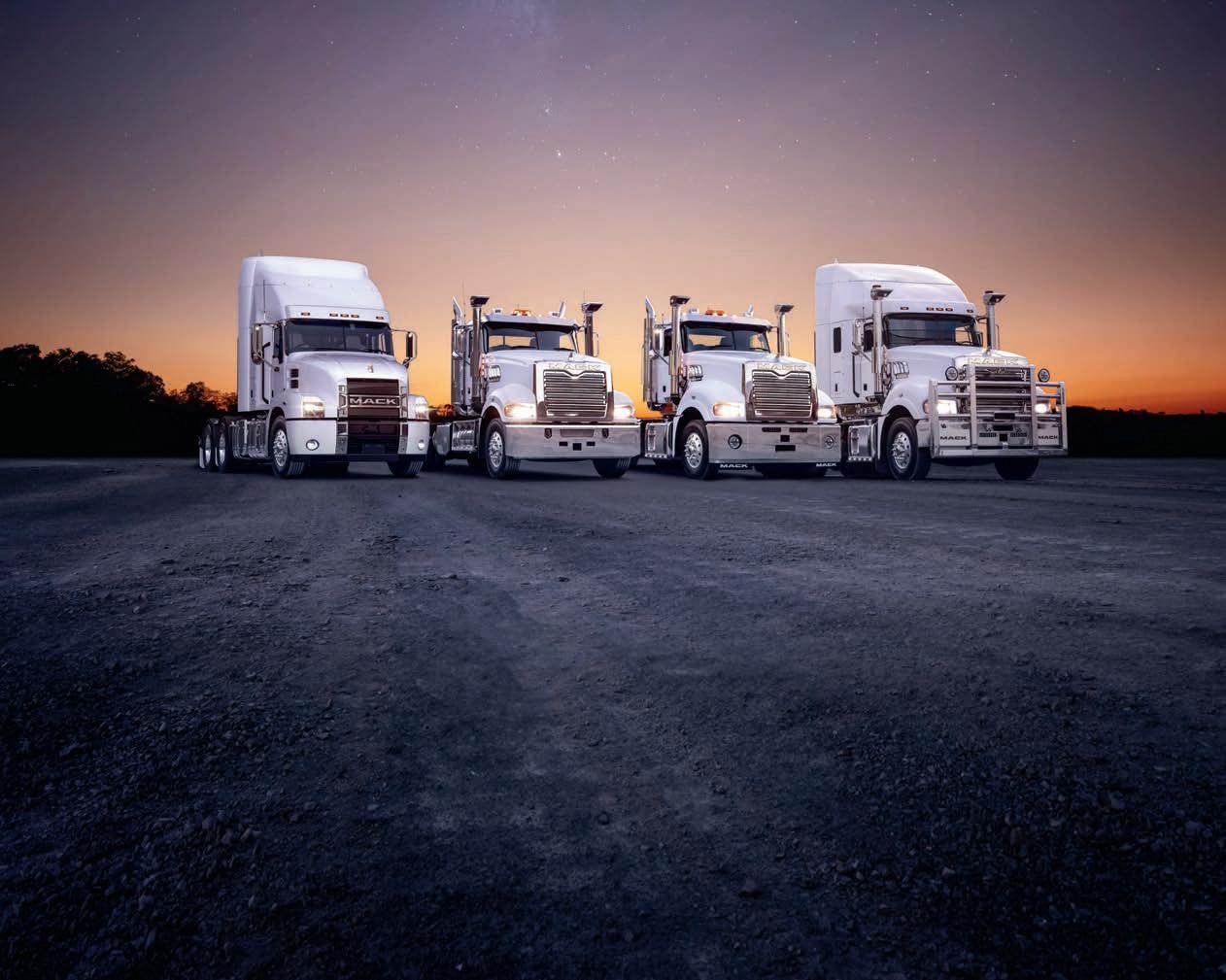
Joining the new big-block engine is a revamped 13L eSCR Euro-6 MP8 which, like the rest of the new Euro-6 range, benefits from new low-friction cylinder liners, wavetop pistons, a more efficient turbocharger, and a revised electronics system to provide more precise fuel delivery and combustion. It is available in 324kW (435hp), 373kW (500hp), 399kW (535hp) ratings.
The Mack Anthem’s efficiency has also been given a shot in the arm with the arrival of the new MP8HE (high-efficiency) engine platform. The MP8HE utilises turbocompound technology to scavenge extra energy from the engine’s exhaust flow and
The progression of safety features continues to be an important hallmark of the Mack Euro-6 offering, with Mack’s evolution of Bendix Wingman Fusion and new Mack infotainment system with Apple CarPlay, Android Auto compatibility and wireless phone charging. With a standard rear-view camera and optional additional cameras, Mack customers will benefit from an improved level of visibility and safety on the job site.
The fully integrated 70in, walk-through sleeper will also be available for order with Euro-6 Super-Liner and Titan products. They feature multiple configuration options, including single and double bunks. New cab suspension, tilt and telescoping steering column and driver seat with air suspension also improve driver comfort.
“We are excited to bring this new range of engines to the New Zealand market,” said Rob Woods, general manager, MTD. “To be able to offer this level of power and
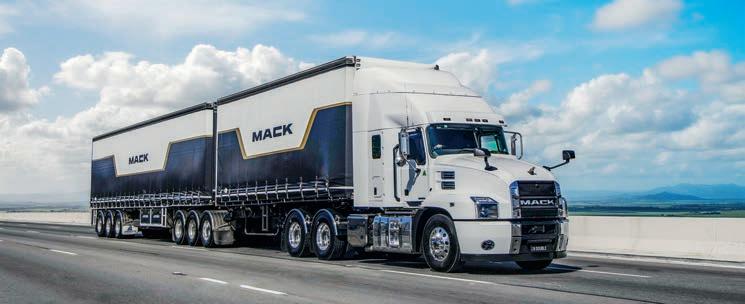


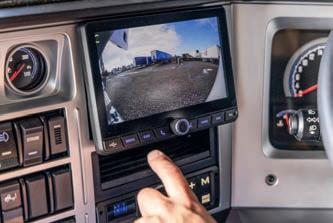












Kenworth showcased its SuperTruck 2 demonstrator vehicle at the ACT Expo in Las Vegas last month, a project developed over six years in collaboration with the US Department of Energy’s SuperTruck programme, which challenged truck makers to improve freight efficiency using a diesel engine as the primary power source.
“The goal was a 100% freight efficiency improvement over our 2009 Kenworth T660. We
surpassed the performance of that model to improve efficiency by up to 136%,” said Jim Walenczak, general manager of Kenworth and PACCAR vice president.
This was achieved by improving fuel efficiency up to 18.3L/100km and reducing weight by about 3175kg.
“SuperTruck 2 provided us with the opportunity to investigate new technologies at an early stage. We learned what worked and what didn’t. As a
result, we can commercialise new technologies much quicker than we would have otherwise.”
Joe Adams, Kenworth’s chief engineer, said that while the “unique look” of the Kenworth caught most of the attention, the powertrain and driver amenities were just as impressive.
“We started with an ideal aerodynamic shape and we asked ourselves, ‘What does the next-generation vehicle for long-haul transportation look like?’ What we produced
pushes the limits in reducing aerodynamic drag while it also incorporates a new powertrain.
But, with everything Kenworth, we wanted the SuperTruck 2 to embody ‘The Driver’s Truck’. The result was a systematic approach to developing a futuristiclooking, yet relevant vehicle with technologies that have the potential to be refined and commercialised.”
Kenworth’s SuperTruck 2 utilises a PACCAR MX-11 engine, rated at 328kW (440hp), which The Kenworth ‘aero family’.


Shockless
Shockless Ride Technology
Our Innovation Built In™ philosophy yields some of the most innovative, durable, lightweight and costeffective suspension systems and components for the global transportation industry. Hendrickson’s ZMD™ ZERO MAINTENANCE DAMPING™ eliminates conventional shock absorbers by integrating the damping function into the air springs.
Our Innovation Built In™ philosophy yields some of the most innovative, durable, lightweight and costeffective suspension systems and components for the global transportation industry. Hendrickson’s ZMD™ ZERO MAINTENANCE DAMPING™ eliminates conventional shock absorbers by integrating the damping function into the air springs. Tel: +64 9 570 4721 www.hendrickson.com.au


Kenworth SuperTruck 2 makes significant advances in efficiency with a diesel engine. Right: Central driving position very different to any other Kenworth on the road.
is driven through a PACCAR TX-12 automated transmission. In addition, the truck features a 48V electric generator. This creates a mild-hybrid system and leverages next-generation lithium-ion batteries, recharged through regenerative braking. This allows Kenworth’s SuperTruck 2 to operate electric fans, steering, and coolant and HVAC pumps.
The aerodynamic design allows for a 48% reduction in drag compared with Kenworth’s


baseline vehicle, and the layout is powertrain agnostic, supporting zero and near-zero emissions solutions like fuel cells and hydrogen tanks.
Enabling more payload was a critical element in the design for the Kenworth engineering team, which also utilised a specific trailer design. The combination came in at 11,838kg.
The SuperTruck 2 also features a “centre driver” cab and a new sleeper compartment designed to resemble a bullet train. The
driver-side door has a large opening, and the extendable bottom step supports a stairwaylike entry and exit. “We made the windshield very parabolic in ‘plan’ view and smooth to the flow. The integrated digital mirror system enables enhanced rearview monitoring, with trailer tracking capability and night vision enhancements, technology currently available in Kenworth T680 models,” said Duncan. The truck is trialling a bed that folds down over the sofa,
providing a separate sleeping and sitting area.
“Kenworth just celebrated its 100th anniversary, and SuperTruck 2 builds on Kenworth’s history of providing value to its customers,” added Walenczak.
“This project represents Kenworth’s innovation to ensure that our company’s future and our customers’ needs remain at the forefront. This truck is an important milestone for us,” he said.



The Windrose E1400 is coming to New Zealand later this year. Arjan Velthoven, editor of TTM.nl, and Dutch member of the International Truck of the Year jury, had a preview drive in Europe.
Chinese electric heavyduty truck developer
Windrose Technology is keeping its foot on the accelerator for 2024.
In April, it announced the completion of the second phase of its series B financing, raising the total funding for this round to US$110 million (about $179 million).
The proceeds of this series B financing will be used to accelerate the testing and
deployment of Windrose Technology’s electric longhaul trucks globally, to set up a new supply chain centre and production facility, and to implement a fast-charging infrastructure.
The company’s first electric long-haul truck has a range of 670km under a full load of 49 tonnes. The Windrose EV truck has an 800V high-voltage fast-charging platform and can replenish 400km of range in under 36 minutes.
Windrose intends to launch a European 4x2 specification in the fourth quarter of this year. The vehicle will be an estimated 7.4m long, with 520hp. Its weight will decrease to about 9.5 tonnes.
The company is currently looking for transport companies to partner with and

additional investors.
“We are looking for partners. We need investment to set up a distribution and aftersales network,” said Eric Gauthier, Windrose head of operations Europe and responsible for Windrose’s rollout in Europe.
“Financially, we have a solid foundation. We want to debut on the New York Stock Exchange later this year.”
The new Windrose EV has already been driving in France for Decathlon, and in Belgium, the company managed to snare Gilbert de Clerq as a pilot customer. The port of Antwerp was looked at, and Windrose became a main sponsor of the basketball team Antwerp Giants.
The truck is a long and tall vehicle, at 3.90m high and
8.10m long. On the rear axles, there are two electric motors each, which are good for a peak power output of 1043kW (1400hp) – more than any European e-truck. The battery pack consists of three stacks of two battery modules each, suitable for six modules in total and 729kWh at a voltage of 800V. The battery pack, supplied by an external supplier, is sufficient for a 670km range at a total weight of 49 tonnes. It boasts a drag coefficient of just 0.275, considerably lower than that of the similarly styled Tesla Semi (0.36).
The Windrose EV cabin is large, measuring 280cm in length, 220cm in width and 245cm in height. The bed, with a thin mattress, is 88cm wide. A second seat can be optionally fitted. Against the



rear wall, there are three large cupboards. Under the sloping windscreen, there is a reasonably wide dashboard with plenty of storage space and a minimal number of buttons.
There is an instrument display right behind the centrally located steering wheel and two large screens on either side of it. The Windrose EV only has rearview cameras, so there are screens in the cabin for that, too.
During a brief drive, we quickly got used to the
With 80 confirmed exhibitors and hundreds of registered attendees, organisers are expecting big crowds at this year’s EROAD Fleet Day, taking place on Wednesday 7 August.
Enterprise business development manager at EROAD Matt Buckle said the event was moving to Mystery Creek, Hamilton, due to its significant
confirmed as the keynote speaker. There will be two panel sessions, a networking area and interactive demonstrations, and heavy and light stages.
A highlight of the event will be a vehicle crash simulation, where two cars are dropped from a 200-tonne crane.
“We want to show what an accident looks like at 80km/h, and also 120km/h, to highlight












Accelera by Cummins, Daimler Trucks & Buses and PACCAR have completed the formation of their joint venture, now known as Amplify Cell Technologies.
The joint venture aims to localise battery-cell production and the battery-supply chain in the US and advance zeroemissions technology for electric commercial vehicles and industrial applications.
Amplify will soon begin constructing a 21gWh factory in Mississippi, with potential for further expansion. The factory is expected to create more than 2000 US manufacturing jobs and is targeting the start of its production operations in 2027.
Accelera, Daimler Truck and
PACCAR each own 30% of the business. EVE Energy serves as the technology partner, with 10% ownership, and contributes its battery-cell design and manufacturing expertise to the venture. EVE Energy is a global technology leader in manufacturing LFP battery cells for the vehicle industry.
“Cummins’ power solutions are at the heart of the economy, and we have the responsibility to decarbonise in a way that meets our customers’ varied needs as they navigate the energy transition,” said Jennifer Rumsey, chair and CEO, Cummins Inc.
“Amplify Cell Technologies will enable PACCAR to offer customers cost-effective

premium-quality battery-electric powertrains that meet their operational and sustainability needs,” said Preston Feight, PACCAR chief executive officer.
John O’Leary, president and CEO of Daimler Truck North America, said: “For Daimler Truck, a strict focus on costs and smart capital allocation are the key levers to succeed on the path toward truly sustainable transportation. This partnership enables economies of scale beyond Daimler Truck. It is a key puzzle piece of our battery industrialisation strategy, ensuring access to the right battery cell technology at the right cost and right time for our customers.”

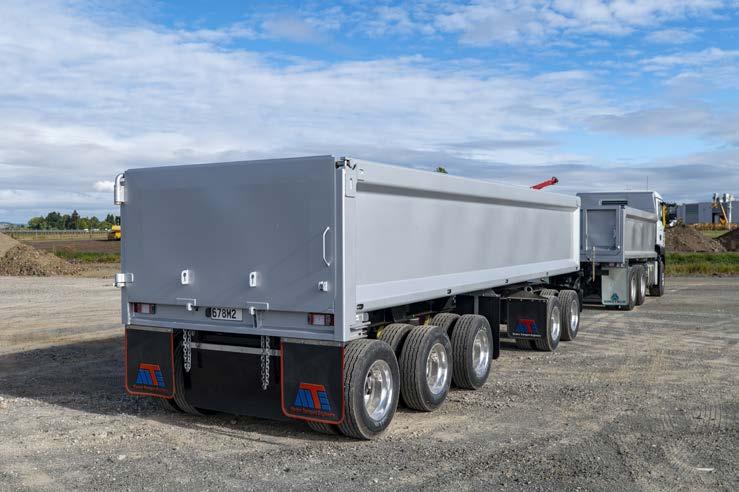


Volvo Trucks is developing trucks with combustion engines that run on hydrogen.
On-road tests with trucks using hydrogen in combustion engines will begin in 2026, and the commercial launch is planned towards the end of the decade.
Volvo said trucks running on green hydrogen were a significant step towards its net-zero goal and supported customers to reach decarbonisation targets.
“Hydrogen trucks will be especially suitable over longer distances and in regions where there is limited charging infrastructure, or time for, recharging of batteries,” the truck-maker said.
Volvo trucks with hydrogenpowered combustion engines will feature high-pressure direct injection (HPDI), a technology in which a small amount of ignition fuel is injected with high pressure to enable compression ignition before hydrogen is added. The advantages of this technology include higher energy efficiency with lower fuel consumption and increased engine power.
Volvo Group has signed an agreement with Westport Fuel Systems to establish a joint venture using HPDI technology.



ENTER NOW TO BE IN TO WIN A PAIR OF PETERSON’S SUN GLASSES


The joint venture is anticipated to become operational in the second quarter of 2024, following formal closing.
“Trucks where the traditional internal combustion engine remains but runs on hydrogen will have the same performance and reliability as our diesel trucks, but with the added benefit of potentially net zero CO2 emissions wellto-wheel,” said Jan Hjelmgren, head of product management and quality, Volvo Trucks.
The hydrogen-powered combustion engine trucks will complement Volvo’s offering of other alternatives, such as battery electric trucks, fuel-cell electric trucks and trucks that run on renewable fuels, like biogas and HVO (hydrotreated vegetable oil).
Volvo trucks with combustion engines powered by green hydrogen have the potential to deliver net zero CO2 well-to-wheel when using renewable HVO as ignition fuel and are categorised as zero-emission vehicles under the agreed-upon new EU CO2 emission standards.
“It’s clear that several kinds of technology are needed to decarbonise heavy transport, based on transport assignment, available infrastructure and green energy prices,” said Hjelmgren.
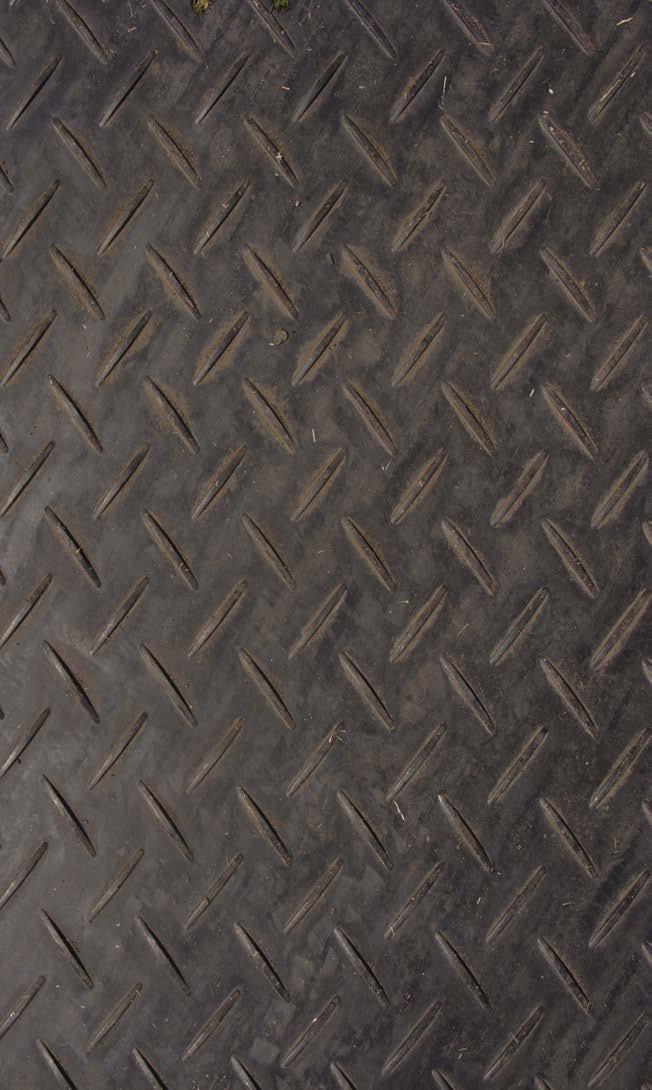

Our winner this month is Amy McCune of Nelson with the Mack Trident she drives for Mytton Transport. This moody shot worthy of a Mack Trucks advertisement was snapped by Amy while waiting at Port Nelson to be unloaded. Great shot Amy, your prize is on its way. Now get your entries in for the August competition.
Send your best night bling photo as well as contact details into nightmoves@nztrucking.co.nz to enter
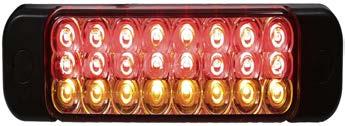

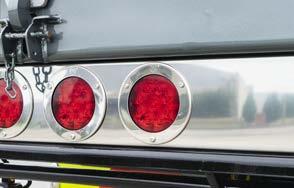


The Freightliner Cascadia has been with us now for four and a half years, and it was time to see how it’s faring Down Under. Is Cascadia living up to the promise? After a little searching, we found just the right truck, driven by just the right bloke.
Regular readers will recall the extensive coverage we gave to the Freightliner Cascadia’s build-up in this part of the world, culminating in the November 2019 Sydney launch. Our first cover truck came in the November 2021 issue, a brand new 116 bulky owned by Cromwell-based McNulty Transport.
The daily task was a short-haul aggregate supply run ex the company’s Amisfield
Quarry on the western side of Lake Dunstan, to Firth batching plants in Wānaka and Queenstown, with an occasional trip out to the East Coast chucked in for good measure.
Although a great ‘Kiwi style’ application, this time we wanted to have a look at a Cascadia 116 in a role more closely aligned to the truck’s original US intention. We also wanted one with a little use under its belt.
To embrace the full US vibe, ideally it
needed to have an aero kit, and be rolling up the road with a big semi-trailer plugged into the fifth wheel. Easy enough you might think, but our ideal truck took a little finding. Shortlisted was one of the seven Hall’s Cold Chain Logistics units that hit the road in 2021, purchased through CablePrice’s Trevor McCallum before his retirement. They fitted the brief to a T, and a quick call to Christchurch transport manager Hayden Reed had us aiming for the immaculate fleet No.7201, domiciled in Dunedin and driven by career wheel-man, Phil Taylor.
It’s an interesting and cautionary lesson in life: in a country and industry as small as ours, your reputation is only ever three marker pegs ahead of you. In the weeks leading up to the phone call to Hayden, every time we chatted to folk about what
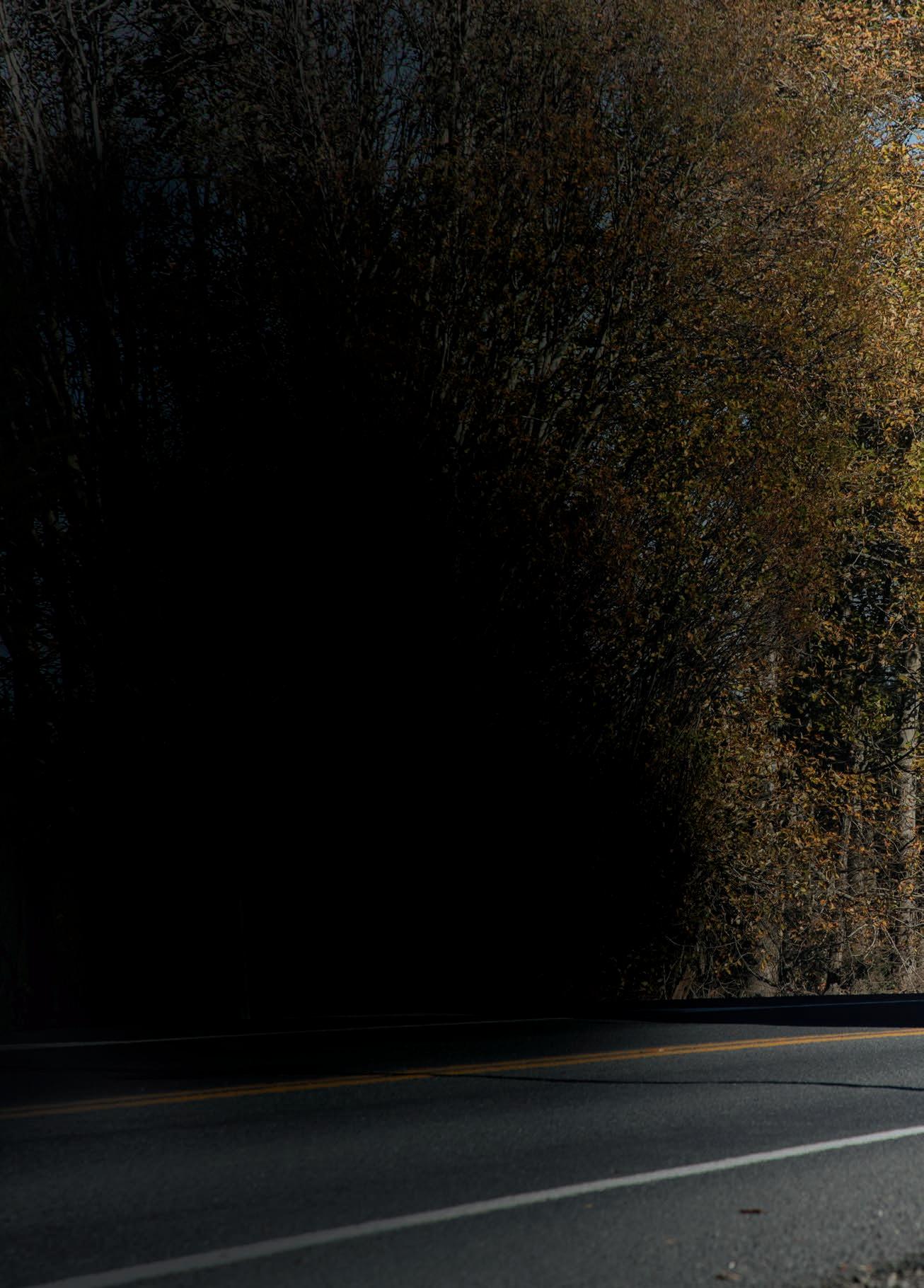
Story by Dave McCoid Photos and video by Carl Kirkbeck and Dave McCoid

it was we were looking for and mentioning one of the Hall’s units were on our radar, eight times out of 10 the reply would come back, ‘I know it’s a long way down country, but if it’s Hall’s, it’s gotta be the Dunedin truck’ – or in the case of those who know Phil, ‘It’s got to be Phil’s one in Dunedin, he keeps that bloody thing immaculate! It wouldn’t be fair to not do Phil’s.’
Now, if I may pause momentarily for any industry outsiders embarking on a whole new world of print entertainment. ‘That bloody thing’ in the context of the previous statement is an industry generic term of endearment when a bunch of truck types reference any machine a dedicated operator keeps in fine condition. I’ll give you, it’s an odd turn of phrase considering truck drivers love the machines of their industry and would never refer to their own mechanical companion as a ‘thing’ on almost any
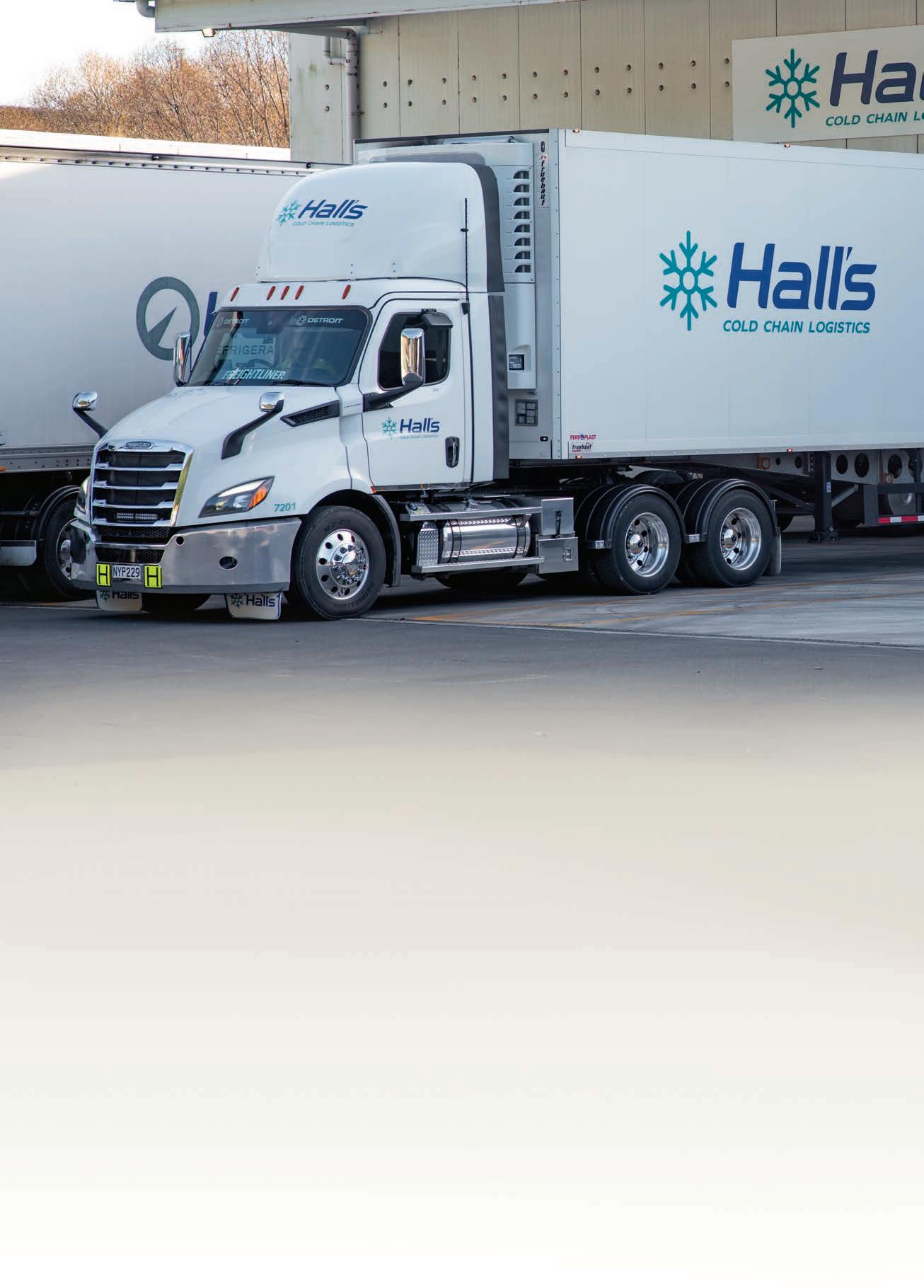
occasion. Stand in the shadows at a truck show, however, and I promise you’ll hear it all day long ‘Shit he/she keeps that thing sharp/mint/on-point/ immaculate!’ A funny quirk for sure, but something that makes us, us. Consider it truckers’ love language … but a word of caution, don’t try it on the spouse.
Not sure about me, but Bruce McLean’s certainly are, and it has to be said the Dunedin and Invercargill Hall’s fleet falling under his operational care all look on point and pearly white. A truck man hailing from a long and broad lineage of lower south pedallers, Bruce’s infectious enthusiasm for his industry and the machines at its core would even rub off on Francis Bourgeois!
Bruce manages the Invercargill depot and runs truck operations at both
Invercargill and Dunedin, with colleague John Warburton managing operations at the Dunedin depot. Day to day he has about 15 trucks in his keep and additional to them are any floating linehaul units from outside the area travelling south of Christchurch, looking to get back north.
“Ours is a mixture of local, linehaul, and floating. The business is dynamic, and customer requirements and order size can change in a heartbeat, so we have to be ready. I’m a customer service man to the core; I get a real buzz out of the operations role and the challenges it presents. We’ve got a great crew across the two depots at the moment. Invercargill is always settled. However, the amount of trucking based in and around Dunedin makes it a competitive labour market and creates a higher level of churn. It’s just the way it is.
“Workwise, things have really
picked up again after a quiet winter in 2023. We were fine through Covid, but had a lull last winter, the first one we’ve really noticed through the whole pandemic era. Thankfully, that’s passed and we’re off again.
“The Freightliners, yeah, they’ve been interesting. Fundamental mechanicals have been bulletproof; they haven’t let us down at all. But they’ve been a little niggly at times with silly things like marker lights and minor electrical-type stuff, and we had one that broke the door handle! The bit you grab ... broken!
“We used to have one based here from new on linehaul and it racked up 220,000km in 12 months. The drivers rated it highly on comfort, quietness, and handling. However, because they’d come off a DD15 in the Western Star, they felt a bit hard done by with the DD13 when they got to places like the Northern Motorway out of Dunedin or the Kilmog.
“Now the business has moved to Scania R590s for the linehaul function, so they’re back to 16L and 590 horsepower, so you know they’re all over them, and you can’t blame them. The Cascadias have found their home in the regional function with the occasional longer run when required.”
It’s an interesting assessment from the man who runs them, and soon we’ll move to the man who lives with one.
There’s a whole lot to unpack in Bruce’s comments and it speaks volumes about linehaul trucking in New Zealand and what is required when perishable consumables and food products are at stake.
Three years after our launch articles, Freightliner continues to wield the big hammer in the domestic US class 8 heavy truck market at about 37.9% (87,000 trucks pa approx.) and Cascadia is without doubt the
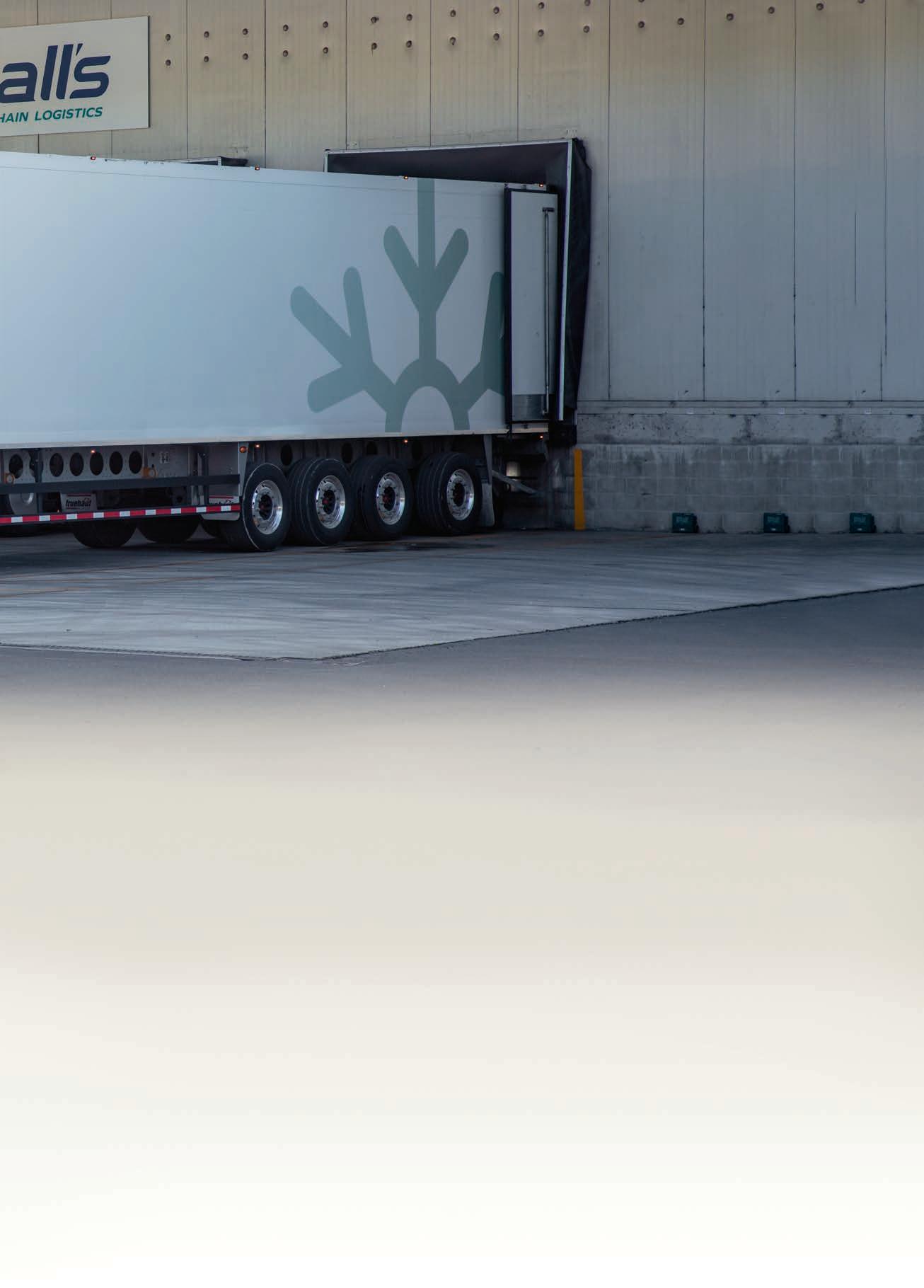
undisputed golden child, still. In many ways the brand lives up to the dream of its founder Leyland James, who sought a light, powerful, economical truck that optimised payload. Dominance in modern times has its roots with Daimler’s top truck man Martin Daum, who turned a flagging market share around with the arrival of the new Cascadia in 2007 and a clear instruction to his people at Daimler Trucks North America (DTNA) that they will deliver a 5% reduction in TCO on the model every two years from that moment on. Yikes! R&D nirvana.
Of course, we got the benefit of all this in 2019 when it was decreed the ANZAC nations will fall under the wing of DTNA. Paradoxically, it did mean losing the Argosy, which caused barely a ripple in Australia while sending New Zealand into apoplectic seizure. A valuable lesson, reminding us the hammer we swing when it

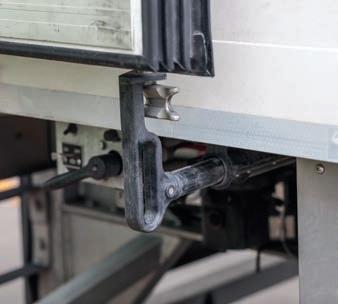
1 & 2) It’s the little things that make big differences, WABCO TailGUARD, integral door catches and levelling valves. I bet the pioneers of refrigerated transport would have loved them!
comes to influencing the global heavy truck market is actually made of polystyrene; probably worth remembering just at the moment.
Never fear though, a bonnet it might have, but at least there would be an 8x4. Well, that was until the regional launch function at the Sydney Opera House in 2019 when Mr Daum put that rabbit in the crematorium, saying such oddness would fall under the wing of the new Western Star when it came; Western Star being the vocational truck in the DTNA lineup.
What it all meant is the road
Down Under on the eastern side of the Tasman would not be an easy one for one of the world’s most dominant commercial motor carriages, and that has played out with only 33 of the 116 model, and 10 of the 126, hitting the road here since launch. (The model number denotes bumper to back-of-cab measurement in inches.)
What we omitted from the list of original requirements when scouting for our truck was a level-headed, well-versed, and experienced driver, who would offer an objective view on the machine. As it turns out, lady luck was with us and, in Phil Taylor, we got the Powerball on that one.
We first met Phil and his Cascadia 116 on the northbound bypass at Balclutha. We’d been held up on our run north from Invercargill and he had happily paused on his way home from the Silver Fern Farms Finegand freezing works to allow us catch-up time. We would learn in the succeeding two days that such accommodation was just who he was. When Phil Taylor says “All good, no problem”, he means it. After a quick meet and greet, Phil continued his way north and we commenced image capture.
If you didn’t know you were in New Zealand, who Hall’s were, or that day cabs and fouraxle reefers are not a thing in linehaul US, motoring north could easily have been a scene from somewhere in the North Carolina countryside. Here was a 13L 6x4 Freightliner Cascadia, with a roof kit, side fairings, no sun visor, and hood mirrors, towing a big semi along the road. This was exactly what we wanted.
Phil was on his way home to Hall’s Cold Chain Logistics Kaikorai Valley depot in Dunedin. It marked the end of his day as a rule, having started the morning with his usual routine of one or two metro deliveries ex the depot, followed up with the run to Balclutha, sometimes making calls to supermarket outlets on the way down. Time permitting, he may also have a couple of afternoon deliveries on his return.
When volumes dictate, he also heads to Invercargill, a couple of hundred kilometres south – more often than not a Monday mission by all accounts.

Under normal circumstances, he might only rack up 250km to 300km a day, so it’s very much a regional role.
We arrive at the Dunedin depot and meet operations supervisor John Warburton, who instantly aligns with the approach and accommodation we’ve encountered since entering the Hall’s world. So far, we were three from three and any thoughts that Hayden, Bruce, and Phil might be outliers in the bell curve of company culture are being rapidly cast to the wind.
The truck made the whole thing quite a buzz really – it’s all so Cascadia, especially if you’ve spent some time in the land of the free. As Phil backed in to the dock, we wondered how many times has a Freightliner Cascadia backed in to a dock? “Surely that number is well into the tens of billions by now?” I said. “It’s like watching an Air Tractor topdress, it’s what they were born to do.”
We met Phil the following
morning on a windy and showery Dunedin waterfront morning. Fryatt Street is the quayside access from the city to the inner Otago Harbour berths. At the far northeastern end, a large business estate is home to ENZA and Talley’s cold storage facilities, and it’s from deep within these corridors of cool that Phil emerges and we leap aboard. First impressions count and the inside of the Cascadia is as immaculate as the outside; you could literally eat off the floor. It’s all so apparent now why so many in the know pointed us toward Phil.
“It’s a lovely truck to drive,” says Phil. “I really like it in that sense. There’s plenty of room in, around, and behind me, and the dash layout is superb – nicely wrapped around and everything in reach. There’s a little rattle in the back wall that’s cropped up recently, that’s why your seat was reclined back against it.”
The space, the big lazy wrap in the dash, they generate a feeling of airiness. All things we remember the designers striving hard to nail, and here their work
was being vindicated by the only jury that counts.
The rattle? Find a US truck that’s rattle- or squeak-free and I’ll show you an abandoned Mt Everest in the middle of climbing season.
“Visibility is superb, and the mirrors are fantastic. You can just see everywhere, and the bonnet almost isn’t there, is it? I don’t notice it, and it certainly doesn’t compromise manoeuvrability,” says Phil Manoeuvrability and Dunedin – now there’s the makings of an oxymoron. There’s no place quite like ‘Dunners’. Well, actually, there is – it’s called Wellington. There’s no escaping it, both islands have a city that tests a truck driver’s spatial awareness to the nth degree. Whether it’s the streets or delivery locations, there’s no quarter given in the Otago capital, and any momentary lapse in concentration will result in a ‘gark’ somewhere on the unit. Even motorway off-ramps, like the northbound exit to Kaikorai Valley that feels like you’re on an ever-diminishing
taper ending in a quirky little 90° left-hand corner with an immediate kink right onto a narrow two-lane bridge split with a kerb median. I wouldn’t say it’s challenging, but first you have to remember it is a motorway off-ramp; and second, if you happen to be thinking about the roast for tea tonight just at that moment … Let’s just say it’s very Dunedin. And when you take into account the traffic the valley absorbs through that wee complex, it starts to boggle the mind.
Fantastic then that both man and machine come into their own and the fact the Cascadia and semi are as straight as the day they were manufactured, speaks absolute volumes about its captain. This is Phil’s home, these are the streets his trucking teeth were cut on, and it shows.
The Detroit Diesel DD13 is your typical modern 13-litre with a hearty voice that makes the mid 70dB recorded in the cab a most enjoyable experience. The match with the platform AMT is on the button and the Detroit DT12 picks away




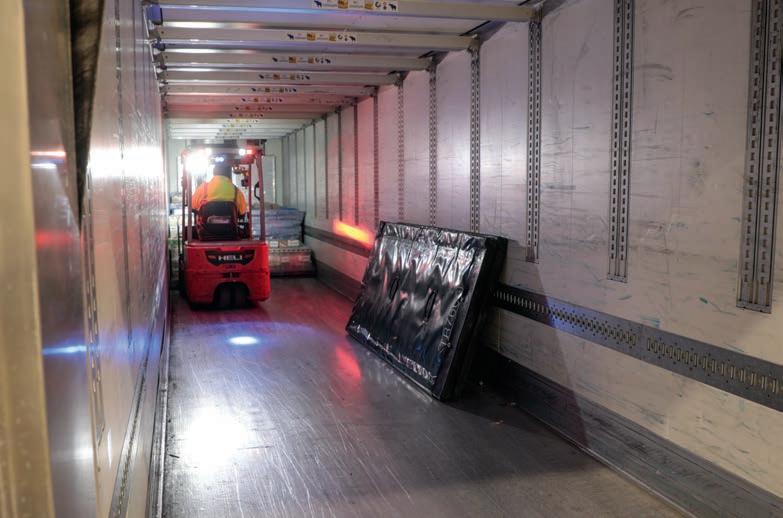


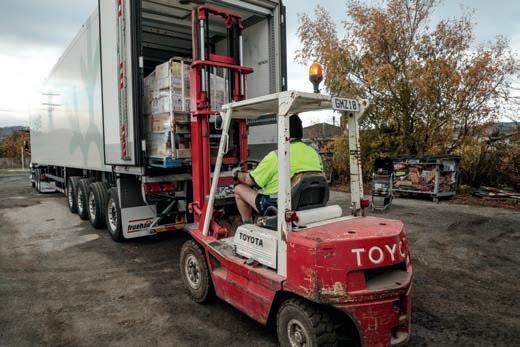
at the gears as Phil negotiates his way around the city’s front apron, onto and up Lookout Point then back toward the depot.
With Eaton’s Endurant now in the mix also, isn’t it a relief Uncle Sam’s OEMs have finally got a suite of auto-shifters in the marketplace that all work as an AMT should?
Anyway, we’re back in the valley and swing into the depot. Phil spins around in the adequate albeit cosy yard – fine if you’re a Dunedin native. In the 116 Cascadia he can see terra firma 3.75m in front of the hood, so he can nose right up to the fence in order to get the unit straight prior to backing onto the dock. By now, regular readers will be well versed on my views regarding
versus real-world helpful ones, and the WABCO TailGUARD system sits in the latter category perfectly. Big trucks and trailers are hard to see around and anything that gives you additional visibility on the ‘dark side of the moon’ so to speak, is certainly worth its weight in gold. Backing onto a dock in a busy DC or depot is a perfect example. TailGUARD keeps the reversing speed under 9km/h and warns the driver of anything within two metres of the rear of the trailer and stops the unit complete at 500mm (the stop distance is configurable between 300 and 700mm). By default, that includes the dock. Part of the awareness process is the sidelights flashing with increased cadence the closer an object is. It’s a canny system.


stopping,” says Phil as we inch our way back. “That’s the trailer doing it by itself. Here, I’ll go forward and start again, you watch the side lights. See, it’s detected the dock. If I’m happy I can continue back, otherwise there’s something there I may not have seen. I think it’s a great tool. Anything that helps, eh?”
The external modular panel look of the 15.54m Fruehauf NZ Schmitz-Cargobull semi instantly tells an industry onlooker whose show it is. The Hall’s unit sports the company’s clean, smart, contemporary look with the snowflake logo and obvious accoutrements of social licence, like side and rear under-run protection. It’s a robust, bulletproof setup with known longevity built into it beyond the Fruehauf NZ
Spec like SAF undercarriage and JOST full-load landing legs and alloy wheels. There’s also kit like a BroLube central lube system to ensure a long and happy life, and EROAD to help keep on top of the compliance and admin chores. It’s a unit designed with continuous movement as the key focus, just as it should be in trucking.
Phil leaps aboard the forkhoist and starts loading product for the daily run south to Balclutha. He points to the Schmitz Cargobull Double Decker racking system. A series of vertical rails with inbuilt racking that can drop to any height down the vertical, meaning you can optimise space in a second layer, regardless of the height variation in the base load.
“Love that! It’s a great
obviously, but you can’t have everything I guess.”
One thing that stood out in the Hall’s depot was a lack of incessant horn tooting from the forkhoists as they moved around, which as a rule, completely desensitises you to horn tooting … it’s a ‘how we’re built’ thing. The clue as to why the ambiance was so pleasant was in the blue lights darting around the floor, emanating from units mounted on the ROPS on the forkhoists. They warn the onlooker there’s a forkhoist approaching. It’s a brilliant system, especially when you consider we are designed to acknowledge and respond to movement … it’s a ‘how we’re built’ thing, and that system is a far better use of it.
As Phil completes the loading
the lid on the Cascadia. It is a snug fit for the 13-litre, with the signature drop in the frame so the radiator is set as low as is able, allowing the sleek and slippery wind profile. All the daily checks are on the left and I know I’m showing my age and level of residual paranoia, but I’m a fan of daily checks on things like oil and coolant, and it’s one area a bonnet has real advantages. With it lifted, all is revealed – and you can quickly see what’s rubbing, seeping, loose – anything that may end up irritating your Monday or ruining your Friday.
Bonnet down and standing back, it’s a clever fleet-spec rig, again with proven components like the Holland fifth wheel, but also from the cosmetic standpoint. There are enough



interested if they want to get into a bit of polishing, yet for the skilled operator who’d rather go fishing than attend a truck show, it will come up just fine with a good honest once-over on a regular basis.
With 14 or so tonne on the deck we tip the scales at 33,450kg. Phil can put about 22 tonne on comfortably and says being a 6x4, you have to be aware of how you’re loading it when reaching the upper limits.
With a power to weight ratio well north of 7kW (10hp) to the tonne, the Cascadia launches away with little or no effort, and it’s here you really appreciate the fit of the machine in New Zealand.
While 13L and up to mid-500 horsepower isn’t going to set many wheels spinning in daily HPMV linehaul duties north of 50MAX, it’s a superb regional distribution spec that is easily able to leap into the breach in the event one of the big-boys ‘has a moment’, and can’t front up at the go-line. There would be no drama plugging into the loaded B-train for a couple of nights if it means customers are kept happy. In all reality, you might be surprised at the trip time differential.
The DD13 in this installation is set at 377kW (505hp), delivering 2508Nm (1850lb/ft) of torque, and as we’ve said, it is backed up by a Detroit DT12 AMT, with Meritor GP46-160s on Airliner air suspension. Up front, the Meritor
FG94 7.5-tonne front axle sits on taper-leaf suspension. Brakes are disc. At the price point offered of recent in some outlets, you couldn’t go wrong with a couple of these in the mix.
We head out of town in the traffic and crest the Saddle Hill in seventh at 1300rpm and 35km/h. The 2021 Cascadia has had a pleasant life with only 220,000km on the clock, and Phil at the helm for the 12 months he’s been with the company. To date, the consumption is sitting at 47.4L/100km (2.11kpl). Reading that in the context of what the truck does, there’s not much to complain about. Outside of the occasional lash to Invercargill, the longest stretch of flat running it gets is the 33km between Allanton and Milton.

“I don’t mind it at all. Like I said, it’s roomy, comfy and quiet. It steers well and goes fine for what is asked of it. I’m an American-truck person, and it’s got a bonnet. Some of my mates reckon the bonnet mirrors ruin it, but they’re a real US thing, and I tell you, they’re bloody handy. I actually use them a lot. And on this raked bonnet they’re great reference points.”
Out across the flood-free north of Waihola at cruising speed and we’re heading for Milton and the first of our two drops en-route at the local SuperValue, the second being New World Balclutha. As is always the case, the big semi certainly reminds you it’s there, especially so considering the competitive tare weight of the tractor at 8300kg and the deteriorating state of our roads. “If it’s loaded wrong, slightly forward too much, say, it’s really horrible to ride in,” says Phil. That of course is not the truck’s fault in any way.
The Cascadia’s cab and vehicle operation from within are state of the art. You don’t become one of the most successful heavy trucks in history with a crappy cab, and it would be the archetypal negative Nelly who would find real fault in how it works.
Access is as easy as it gets, and the driver’s position is superb and fully adjustable. Everything falls easily to hand and the cockpit setup is in the familiar format with gauges and telematics in the binnacle and additional gauges, HVAC, vents, coms/entertainment up
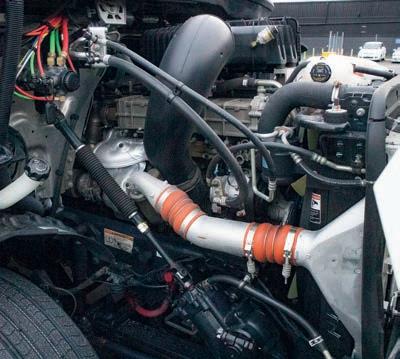
high in the wrap, and switches, valves, and Aux power down low. The headlight control is low down on the right of the steering wheel. There’s a Daimler platform familiarity to the smarts on the steering wheel, and located off the steering column wands are indicator, wipers, and dip on the left, and direction/shifter on the right. For me, a wand shifter is superior to button type, allowing the console area to be clear of intrusions like shift-towers. In Phil’s line of work, having crosscab access is handy.
It’s a day cab bonneted truck so there’s only so many rabbits you can pull out of the storage hat. However, the caddy between the seats, overhead cupboards, and stows both overhead and in the doors, plus room under the passenger’s pew, more than meet requirement in this application.
Fit and finish seemed fine; we had a poke and prod, and three years in, things appeared to be holding up. Materials are highly serviceable and there’s a nice woodgrain pattern through the dash.
Obviously, there’s the recent ‘Budgie’ that’s arrived in the rear wall lining, and of course Bruce’s comments on the collapsed door handle. Hopefully, it’s all being fed back to DTNA. I know first-hand how seriously things like that are taken there.
As it turns out SuperValue in Milton is a cinch, with access off Shakespeare Street and


Great relationships are the key to good business at all levels. Phil says cousins Nicole and Jodie Thompson on the chilled and frozen docks respectively are the best, whether it’s efficiency or just the people they are.


exit onto Spencer. There is an innocent power pole on the left of the unload area that would appear to be minding its own business, but occasionally it leaps sideways and gives the odd truck a tap according to Phil, especially if they attempt to exit back onto Shakespeare. We’re in and out in no time; it’s

a typical friendly Phil exchange – how easy is it for customers when you have a skilful and engaging driver on a regular basis.
Being a semi the back-in was as easy as it gets. However, when talking to Bruce earlier he did say it’s a skill in ever-shorter supply. “Everything we do loads


in and out of the rear, so we have to have people who can back competently – big semis and B-trains. That’s not as easy to find as you might at first think.”
On to Balclutha and Phil happily talks about his place of work. “I’ve worked at plenty of places and it’s as good a place as

I’ve ever been, probably better. The crew I’m with all get on, and everyone knows what they’re doing. Bruce [McLean] and John [Warburton] know what they’re doing and leave you to get on with it. The conditions are great, the gear’s good, and the pay is fine. There’s a bonus system they run worth $100 a week tied to things like driving hours, PODs, CHEP recovery, all the basic stuff a driver should be doing anyway. Guys from our generation shake our heads at those sorts of things needing to be incentivised. There is nothing onerous and it’s easily achievable – if you do your job properly, you’ll get the bonus. On the occasions I’ve missed, it hasn’t been because it’s unachievable, it’s because I’ve buggered something up and that’s annoying … for me, I mean. And there’s no pressure on hours or to do silly things – that’s a big no-no.”
Continuing the theme of keeping compliance easy, Hall’s runs electronic logbooks housed in the same little Zebra device as the dispatch, consignment, coms, and pre-check/maintenance information. “Again, it’s all a bit easy for someone raised in another trucking generation. There it all is,” says Phil holding up the device. “It’s that simple, there’s nothing difficult about any of it.
“The Seeing Machine? A lot of people hate them, I’m not sure why. Yeah, it’s gone off a couple of times for no reason I can fathom, but I’ve got nothing to hide, and it’s a good safety device. It’s a more professional world now and I can only see things like that saving arguments.”
And with that we’re at the Balclutha New World for a twocarton delivery and then on to the huge Finegand freezing works located just to the southeast of town on the Owaka Highway. Hall’s does a lot of transfer work for its customers as well as delivery work, and today we were bringing the bulk of our load down in here, as well as loading out 22 pallets for places far away.
“That’s the chilled loadout

‘Taylorville’
IT’S NOT A BAD PLACE
I’ve had plenty of jobs, I’ll be the first to admit that, and I’m sure plenty you talk to when you say you’re doing this will tell you also,” Phil pauses and chuckles as we trundle along.
“But I’ll also say I’ve enjoyed pretty much all of them, and I’ve gained a lot of experience in a lot of things. I’ve had a lot of fun and met a lot of people. I guess I’ve just managed my life with my happiness and wellbeing as the first priority.”
Looking from the outside observer’s position, you’d have to say there’s merit in the man’s philosophy – never feeling like life has him trapped. He’s not rushed in his approach, nor it appears prone to ‘fizzing’ up. Think back to Jodie on the forkhoist at Finegand, “We love Phil, he’s great.” Surely part of the reason for her saying that is consistency of character when he arrives each day. Nothing is more settling for all parties than knowing ‘who’ is getting out of the cab.
“I’ve never done stock or fuel,” he says, which is ironic
considering both his dad Stewart and grandfather Gordon drove Europa fuel tankers between Dunedin and Haast. The grey-haired set north of 50 years old will remember the Europa fuel brand back in the 1970s and early 1980s.
“I don’t know what my grandfather drove but Dad drove a Leyland Mastiff. It took all day to get there, and then all day to get back.” In the warm, spacious, and comfortable confines of our present ride, we both shook our heads at the grit and tenacity of those hardy old buggers. “Dad eventually went onto buses before a complete change to greenkeeping. Something he loved and did really well. He ended up president of the national federation.”
Mosgiel was home for Phil growing up and his early life was spent in and around all of the above and local truck action in general. Key was inspirational time spent with cousin and mentor Peter Alexander, who worked at Thomas Transport.
Peter moved on to drive at Mainfreight in Dunedin before heading to the North Island and working at Candy Transport in the Bay of Plenty, and then Toll. Not only was he a great mentor to Phil, he also drove, and eventually ran, some cool gear – trucks like the FR Mack he had while at Mainfreight, and the ex-Keith Howells Ghetti Express Kenworth K100G he owned while at Toll. “The FR Mack really kick-started my love of trucking.”
Phil’s own career began courtesy of Mt Cook Line freight division contractor Mike Knopp and the loan of a truck in which to secure his heavy traffic licence. Success led to aroundtown delivery relief work and of course a trailer licence. From there, the usual pattern of progressive escalation followed, just as it did for anyone in that era who had what it took – the thing older heads observe in a young one that tells them ‘this one’s a keeper’. Phil was off and rolling.
Logs, freight, and general for various employers took place
in the succeeding years. Like so many in the industry he headed for Australia with the intention of ticking that box in the list of things he wanted do to, while poking a hole in the mortgage.
“The work was good, I was running Brisbane/Sydney for Armesto’s Transport, initially in a Western Star and then a K104 Aerodyne. What I couldn’t handle was the weather, the heat and humidity, and I wasn’t getting the rest I needed in my breaks. It ended in a fatigue moment –nothing happened, there was no crash or anything, but I found myself following close behind another unit. When I asked my mates travelling with me where he’d come from, they said he had overtaken me. I had no recollection of that happening. That scared the shit out of me and I pretty much binned it and came home. It was a shame because I really loved doing it, but I just couldn’t see how I would get on top of it. The climate wasn’t about to change.”
Outside of the Australian experience, Phil’s driving has been South Island-based, and drilling down one step further again, dominated by south of Christchurch. “I’ve never really wanted to get into the interisland thing full time. The thought doesn’t really excite me.”
In his 37 years behind the wheel, 55-year-old Phil has worked for some of the industry’s iconic names and driven some cool trucks … Christchurchbased AZTEC Haulage in a 440 V8 Mack Ultra-Liner with a 12-speed Maxitorque, carting produce and general between Christchurch and Dunedin. “That was a highlight! What a machine, you couldn’t get enough of it.”
An 8V92 Detroit-powered W-Model Kenworth towing a curtainside B-train between Dunedin and Invercargill for John and Morgan Rob at Regan Carriers: “Drove the doors off it! It was a symphony,” he says with a laugh.
A Tranzlink CH Mack for Mike Nevin, and The Patriot Western Star for Brenics … It’s been the truck-buff’s dream in many ways. The recent passing of Alex
‘Mac’ McLellan prompted memories from Phil also. “I worked for Mac for a time, driving an Isuzu on a regular freight run to Dunedin. What a top man, salt of the earth. I was only 18 then, green as grass, and Mac took me under his wing, jacked me up with accommodation initially also. He always had time to have a yarn with you, just catch up. He will be a huge loss to the industry.
“I came into the industry at an amazing time, when it was at its peak in terms of mentors and role models for a young bIoke. Learning the industry when you’re surrounded by people like my cousin Peter, the Mac McLellans and Steve Martins of the world … how can you go wrong?“
Today, Phil lives just over from Mosgiel in Dunedin proper. He has an immaculate V8 Holden Ute and a Harley-Davidson, and enjoys cruising with soulmate Hollie, and spending spare time with his two grown-up children Karla and Deanna. “Life’s great, eh?”
They say the ultimate truck driver is the 55-year-old head on the 25-year-old body. Like the rest of us, Phil would be the first to admit the second half of that equation has long left the stable. However, he’s the living embodiment of the first. He knows trucking, that there’s something new to learn every day, and the moment you drop your guard or think you know it all, it’ll ‘run over your toes’, metaphorically speaking. Yet his years in the industry also bring a comfort from the skillsets he has amassed, the watchful eye that checks it all as he walks around the rig, the calm unpanicked approach. There’s nothing left to prove, no reason to rush in order to impress. He’s immensely comfortable in who he is, which makes him always open to new things.
He’s at that career sweet spot of enjoying the job, enjoying the truck, enjoying the people, enjoying the industry, enjoying the scenery, which equals … enjoying your life.

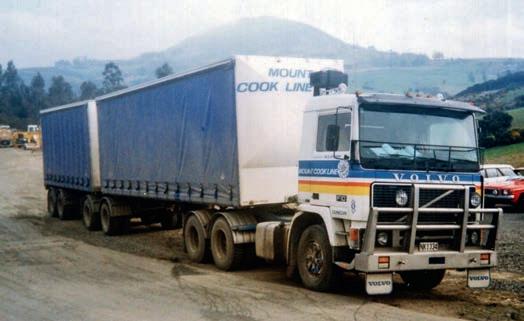


dock run by Nicole Thompson,” he says as we idle in. “And this one we’re backing into is the frozen run by her cousin Jodie Thompson. They are two of the best, there are no other words for it. They keep this place running like clockwork. They are so friendly and make your work life so easy. I’d go so far as to say they’re just good friends now. We’re all going out for a social occasion next month.”
Phil has the semi in the dock in no time, and his commentary on the leading ladies as we drove in was instantly vindicated by the delightful Jodie who wheeled up in her electric forkhoist and welcomed us to the frozen loadout at Finegand, taking interest in what we were there for. “You’re going to be famous Phil!” she says, laughing. “We love Phil, he’s great,” and with that she was off with the first pallet disappearing into the bowels of the giant plant. If only the world was full of happy glass-half-full people, eh?
Experience is everything in trucking, and it’s the little things that make all the difference. Once unloaded, Phil tweaks the raise/lower valve on the semi-trailer so the deck slopes fractionally down from back to front, making the task of escorting the pallets on his pallet trolley to the front of the trailer that much easier.
“It’s safe, too,” he says. “If I slip or something, it’s going to want to roll away from me, never back toward me; and you should never be in front of it with it coming toward you … ever!”
In no time at all, the 22 pallets we were there to receive
post-unload were onboard, and away we went.
At the end of the day the truck is a tool of utility, and one indicator of a good truck might be adaptability. In its homeland, there is no argument the Freightliner Cascadia is a giant. The sheer numbers on the road there perplexes the mind. But we are not the United States. We don’t have 75,000km of lazy rolling interstate, or corporate 1000-plus truck fleets. We carry more on our general access and HPMV trucks – lots more – and our road pricing mechanism means we love collecting axles … even steering ones. It all means Cascadia will never be the colossus here it is there.
But that’s not to say this immensely capable, comfortable, and easy to drive machine doesn’t have a place in Godsown. Cascadias have found happy homes in the bulk and aggregate tip markets, often emulating what this Cascadia does at Hall’s. Take the McNulty truck; local work with the occasional run out to the coast.
Yes, sales might have been modest, but to get a fair comparison you need to measure them against all bonneted US 13-litre 6x4s over the same period.
With a proven driveline capable of backing up the big boys when needed, and with good support after the sale, it would be hard to do a lot better for the outlay.

Tare: 8300kg
GVM: 26,000kg
GCM: 65,000kg
Wheelbase: 4325mm
Engine: Detroit Diesel DD13
Capacity: 12.8L
Power: 377kW (505hp)
Torque: 2508Nm (1850lb/ft)
Emissions: GHG17 (exceeds Euro-6)
Transmission: Detroit DT 12-1850-OH2
Clutch: Detroit HD AMT
Chassis: 11 x 85 x 287
Front axle: Meritor FG941
Front-axle rating: 7500kg
Front suspension: Freightliner Taper leaf
Rear axle: Meritor RT46-160GP (DCDL on both axles)
Rear-axle rating: 20,900kg
Rear suspension: Airliner 46K
Brakes: Disc. EBS, ABS
Auxiliary braking: Jacobs engine brake
Additional safety: Detroit Assurance – 5 (ABA, ACC, LDW, SGA, Intelligent high beam, Detroit Connect)
Fuel: 604L
DEF tank: 47L
Wheels: Alcoa Dura-Bright alloy
Tyres: 275/70 R22.5
Electrical: 12V
Cab exterior: Aluminium cab construction with faring and side extenders, utility lights on rear of cab, day running lights, fog lights, hood-mounted heated mirrors. Aluminium DEF tank cover, and polished battery box
Cab interior: ISRI high-back driver’s seat and ISRI fixed passenger seat. Black leather cover on driver’s seat. Leather steering wheel. AM/FM entertainment system with USB, iPod, Aux, USB
Now, that was a really interesting story to put together, and demonstrates our uniqueness as a wee nation. A huge thanks to the Hall’s team for their enthusiasm and willingness to help whenever we pop our heads up. One of the truly great trucking brands. Especially Hayden Reed, Andrea Albertyn, Bruce McLean, John Warburton, and of course industry ambassador supreme – Phil Taylor.
Theo Ferreira at CablePrice, it’s always a pleasure, as it is also Trevor McCallum; thanks also to Steve Young.
Yvette Mear and Paul Cranston at Fruehauf NZ Schmitz Cargobull – legends! Thanks so much.
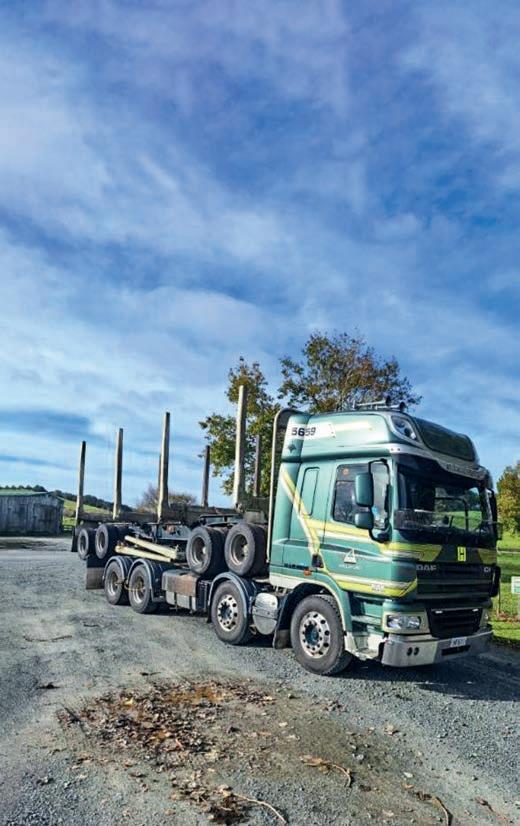
•
•
•
•
•
•
Every cover truck holds a special place in the history of New Zealand Trucking magazine. We love to see where their road has taken them.
GCA8
• Superior sidewall cut resistance.
• Long tread life, exceptional casing durability.
• Enhanced stability and riding comfort.
• The extra-deep tread pattern is specially designed for loaders.
• Excellent performance on extremely rocky surfaces, in open pits, quarries, and underground mines.
GCA2
• Non-directional deep tread pattern designed for muddy and soft surfaces.
• Unique non-directional traction patterns ensure optimum traction and prolongs tread life.
• Superior sidewall cut resistance.
• Good self-cleaning with groove stone ejector.
• This deep tread is particularly suitable for loaders and dump trucks operating in quarries or mining.
GCA3
• Applications: Articulated dumper, dozer, loader, and graders.

GCA8
HFS71 has recently been re-certed but will



• Excellent traction and floatation offer comfortable handling.
•
• Superior long tread life and excellent puncture resistance.
• Low rolling resistance and fuel economy.
• What we said in 2014: “Cab comfort is another advantage over older designs. There is some clever technology and suspension tuning under
•
• Non-directional traction and standard tread depth pattern design.
• Excellent performance supported with heat resistant compounds.
• Primarily designed for mining, off the road, and muddy surfaces.
The DAF was one of two to enter service in the fleet of Northland logging contractor Steve Segetin.


Superior sidewall cut resistance.
GCA8
Long tread life, exceptional casing durability.
Enhanced stability and riding comfort.
• Superior sidewall cut resistance.
The extra-deep tread pattern is specially designed for loaders.
• Long tread life, exceptional casing durability.
Excellent performance on extremely rocky surfaces, in open pits, quarries, and underground mines.
• Enhanced stability and riding comfort.
GCA3

and

• Primarily designed for mining, off the road, and muddy surfaces.


Non-directional deep tread pattern designed for muddy and soft surfaces.
Excellent traction and floatation offer comfortable handling.
• Excellent performance on extremely rocky surfaces, in open pits, quarries, and underground mines.
Superior long tread life and excellent puncture resistance.

Low rolling resistance and fuel economy
GCB5
• Articulated dumpers, rigid dumpers, loaders, graders.
• With excellent traction and buoyancy performance.
• Outstanding stability and operating comfort, with large pattern plate and long service life.
• Unique non-directional traction patterns ensure optimum traction and prolongs tread life.
• Superior sidewall cut resistance.
• Good self-cleaning with groove stone ejector
• The extra-deep tread pattern is specially designed for loaders.
GCA3
• Applications: Articulated dumper, dozer, loader, and graders.
• This deep tread is particularly suitable for loaders and dump trucks operating in quarries or mining.
• Non-directional traction and standard tread depth pattern design.
• Applications: Articulated dumper, dozer, loader, and graders.

• Excellent performance supported with heat resistant compounds.
• Non-directional traction and standard tread depth pattern design.
• Primarily designed for mining, off the road, and muddy surfaces.







• Primarily designed for mining, off the road, and muddy surfaces. GCA7
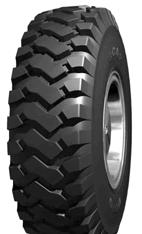
• Excellent performance supported with heat resistant compounds.
GCA2
• Non-directional deep tread pattern designed for muddy and soft surfaces.
• Excellent traction and floatation offer comfortable handling.
• Superior long tread life and excellent puncture resistance.
• Low rolling resistance and fuel economy.




Story and pictures by
Dave McCoid and
as credited
There are drive events, and there are ‘drive’ events, and Penske’s 2024 gathering at Wacol in Queensland at the end of May was an absolute doozy. Little surprise considering the man whose name fronts the enterprise. Over the next two months, we’ll cover off the happenings, starting with the Lion’s share.
Nothing speaks to an OEM’s confidence in its product more than a yard full of trucks loaded to the gunnels and company representatives asking, “What are you standing there for?”
Penske’s 2024 drive event was exactly what a drive event should be, big trucks and a decent two-and-a-half hour lash behind the wheel of the ‘jiggers’ we’d selected in the weeks prior.
After brief addresses from

Hamish Christie-Johnston, managing director for Australia and New Zealand, Craig Lee, executive general manager for on-highway, and head of Western Star Kurt Dein, it was up to the products to do the ‘torquing’.
We’ll split the Penske offering into its two constituent marques, focusing on MAN this month and Western Star next.
Without wanting to unstitch myself here, the only vehicles us
Kiwi fellas weren’t able to drive were the two MAN B-double units. They are now considered multi-trailer combinations and as such, the NHVR requires you do hold an MC (multi-trailer combination) licence. Sad as that may be, it was the last truck for me and concluded the event, so a cruisy yarn was fine.
The lack of a drive was no real biggy as the 26.580 TGX tractor unit is a spec well known to us. With a headline GX cab, it was the true line hauler’s home with 2070mm headroom inside, and all the ‘fruit’ both inside and out. Running gear was the 15.2L D38 in Euro-6e trim, a combination we’re familiar with. On this occasion, it was presented in 433kW (580hp) and 2900Nm (2139lb/ft) guise. Just as I did, you might well ask ‘Why not the full monty 640?’ The old chestnut
of people thinking they need more than they often do was the response from driver and chaperone Wayne Wallace, head of retail truck sales for Australia. It means keeping some powder in the demo keg to impress should the need for more ‘oomph’ be real. “You can never bring them back down when it comes to power.”
Our route took us 70km due west of Brisbane on the A2 to a rest out past the Gatton trailer hook-up heading toward Toowoomba. It’s a four-lane expressway circa Waikato style, with one hill called the Minden which you’d say is akin to St Stevens for the North Islanders, and northbound into Greta Canyon for the Southerners.
At 64-odd tonne GCM through the lazy rolling country, the 580 D38 appeared to be putting

about as much effort into proceedings as the 640 in the Ramsay machine last August did when climbing away from Taupō onto the Rangitaiki at 54 tonne. It’s a gorgeous big thumper filling the cab in that subdued, muffled locomotive groove we’ve commented on before.
The MAN TipMatic 12 30 OD AMT

Big, smooth, and majestic. The 26.580 TGX with GX cab is one of those machines that makes Aussie East Coast B-Train linehaul a no-issue proposition. There’s no replacement for displacement.

transmission (MAN configured ZF TraXon) does a beautiful job of seamlessly swapping cogs, and the eight-bag ECAS suspension was stability personified in an environment that offered it no real test.
As we motored west, Wayne lamented the road surface and all I could think was how happy
I’d be if our carriageways of national disgrace came even close to this.
The flagship of the drive day fleet bristled with all the safety and productivity kit you’d expect and only fools and horses would bemoan the added situational comfort tech like adaptive cruise and active braking have brought to high-speed, high-weight haulage.
This motor loves the basement on the tachometer, and the big Lion easily maintained a steady 100km/h (Aussie remember) for 90% of the open road time, yet with eco-roll and the insulated cab environs, often the sensation was of nothing much happening.



When a rise did rob it of the top 15 or so ‘clicks’, it was effortlessly regained.
Our unit ran the 3.36:1 final drive, which means by application it can be rated to 120 tonnes – handy if it needs to help in a proper multi-trailer environment. Having rounded up the Minden in ninth at 1050rpm, Wayne was keen to demo MAN’s EVBec auxiliary brake descending the other side. Delivering an impressive 627kW (840hp), it is the most powerful in its class. A quick recap of the system: a flap upstream of the turbo closes and combines with targeted airflow of high-speed gas from the remaining opening, back to the exhaust side of the turbo increasing turbine speed
on both sides. This increases back pressure through the entire top end of the engine, resulting in a prodigious braking effect. It will blend with the transmission once the throttle-actuated descending control is activated. The system easily held the show even with gravity pressing hard.
As a place of work, the TG3 cab is as impressive now as it was on first viewing in 2018 in Munich. I’m not sure if it was me, but the Aussie incarnation seamed a little softer than the Ramsay truck – maybe it’s hitting the road deformities that little bit quicker. Driving position, controls and information feedback are stateof-the-art and the SmartSelect wheel as a means to manage swathes of information has lost
me right from the selection list. Yes, it was Euro-5 but, for me, it wasn’t about the engine on this occasion, there were other reasons afoot. First, this genre of TG3 MAN is popping up more and more in regional distribution work at home, and after this experience, it’s not hard to see why. All other reasons aside –and there are many, as you’ll see – this unit in Aussie would set you back a hair over AU$240,000 as it stood with steel wheels.
Second, as I age, I wonder about life after work and would I be happy relieving and ‘playing’ when needed in a more modest carriage of social utility.
My truck host on this jaunt was Sergio Carboni, a wonderful character who fills the regional business manager role for greater Melbourne. Settled in the cab, with those gathered watching us leave, this truck had me gripped from the get go … well, once we found it was in creep mode and switched that off, LOL. (For a moment I wondered how much you’d get through in a day with a top speed of 8km/h.)
True design genius is getting into a totally new truck and feeling like you just put on your favourite pair of shoes. You could position it without thinking; it turned on a dime, zipping around like a kitten chasing a ball of wool.
none of its appeal.
We turned the TGX GX for home and chatted our way back to Wacol, wondering what it would be like to work for a living.
My other MAN selection was a humble wee TGS 26.440 D20 Wharf spec. ‘That’s exotic’ you might think with a side-eye glance, but these days are all about market relevance. I ticked the obligatory ‘big banger’ in the 26.580 because they tend to take your temperature if you don’t; who doesn’t want to show off their Ivy League children afterall. However, this lovely wee jobbie sitting in the corner with its plain-curtain semi spoke to
I know the inner workings of the TG3 cab pretty well and it was all right there at my fingertips – information, switches, the SmartSelect wheel … bliss! By the time we got to the end of the first city block all I wanted was a podcast to listen to.
“They’re pretty neat aren’t they,” said a beaming ‘Serge’. “Mate, I’m smitten. If this was to be my podcast and Luke Combs’ mancave as a retirement hobby … I’m there!” All that said, what really impressed me was yet to come.
Under the cab was the 10.5L D2066 LF57 Euro-5 burner at 324kW (440hp) and 2100Nm (1549lb/ft). Power peaks at 1900rpm, and torque occupies the 1000 to 1400rpm space. Backing that up is the MAN
TipMatic 12 28 OD AMT, and MAN Hypoid diffs at 4.11:1 and four-bag ECAS suspension. It’s an incredibly smooth package and good for a stonking 68-tonne GCM.
Thankfully, we were sitting at around 35-tonne GCM as we headed out on our two-hour urban circuit up the A7 toward the city before veering right to the coast, out around the Mt Cotton area to the southeast and back to Penske’s Wacol HQ in Brisbane’s southwest.
It was exactly the ticket for this machine at this weight. It was smartly away from the lights, the TipMatic so adept at giving you the sprocket it knew you wanted. The truck’s manoeuvrability is also key to tying the package together and its 16.2m kerbto-kerb lock means you can probably poke a big semi in places you thought impossible.
For me, though, the real eyebrow-raiser making this little toiler so likeable was the ride and complete absence of bullying from the semi. In and
around the city fringes – the ups and downs, the corners and gullies – not once did I feel even a gentle nudge, and although that is testament to good load placement as much as anything, the generous GCM means this thing is nuggety in the undercarriage and won’t be pushed around easily.
Again, the accoutrements of modern safety afford another layer of surveillance, almost essential as the cityscapes of both Antipodean nations increase in headcount yet reduce in personal accountability.
Our cab was the TM, narrow, long and normal height, meaning a 2.240m external width that gives the truck more ‘prominent hips’ – guards and bumpers – and a more stocky overall look than the fuller figure accommodation. ‘Long’ means it has a bunk, which is always nice for your stuff, not that there’s any shortage of space because ‘long’ also means under-bunk lockers – winner winner chicken dinner! The ride was the equal of its


A take on a famous line from the Hitchhiker’s Guide to the Galaxy, ‘Your little pal who’s fun to be with.’
much bigger brother. In fact, I’d probably have chosen the TGS as the winner there. Handling and behaviour in the urban confines and fringe motorways was impeccable, and in respect to the latter, it had no trouble hanging
on to the crowd. Of course, north of, say, 50 tonne, that might change considerably.
A retirement sweet spot, or your first brave leap into a new truck on a regional task … you’d be hard-pressed to walk away.




In the era before alloy wheels and stainless steel became en vogue, Newvale Coal Company ran a well-presented fleet of predominately Nissan Diesel trucks. The primary task was delivering coal from two company mines located near Waimumu, southwest of Gore, to customers throughout Southland. The company is still in operation today under different ownership, but the classic green and yellow livery has given way to a simpler blue version. Photo: Craig McCauley. PROVIDES ASSISTANCE to the driver.
Blind spots are a major contributing factor in heavy vehicle vs pedestrian/cyclist interactions, particularly in left hand turns. MAX-SAFE have a range of solutions to help increase the driver’s awareness of vulnerable road users around their vehicle. Our solutions include optional visual and audible alerts for both the driver and the vulnerable road user i.e. inside and outside the cab. One such offering is MAX-SAFE Side View™: an affordable solution based on an AI camera that detects and protects pedestrians/cyclists – ultimately enhancing safety.


• SAFEGUARDS the side of the VEHICLE.
• PROTECTS PEDESTRIANS, cyclists and motorcyclists.
• HIGH ACCURACY – detects people (stationary and moving).
• MORE AFFORDABLE than sensor systems.
• SUITABLE for most ANZ CONDITIONS.
• Provides ALERTS and AUDIBLE WARNINGS.
• STATE-OF-THE-ART AI TECHNOLOGY.
• GREATER SAFETY and PEACE OF MIND –for Drivers & Fleet Managers.
• Part of the MAX-SAFE SAFETY ECO-SYSTEM.













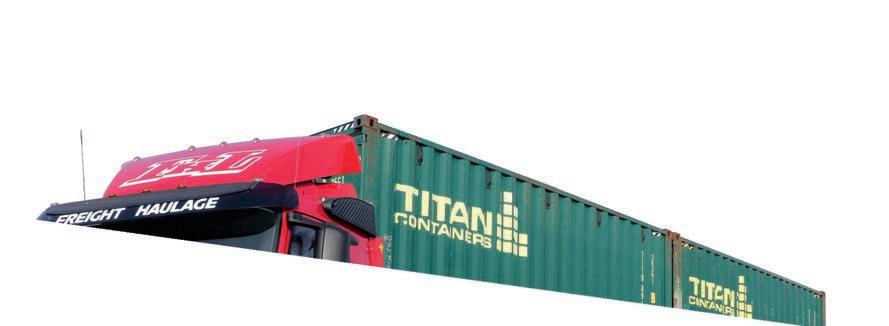

The annual Gore Truck Show was held on the Saturday of King’s Birthday weekend as a part of the Tussock Country Gore Gold Guitars country music festival. Thousands of visitors flocked to the Eastern Southland town, lining the main street to watch the parade. Earlier, attendees enjoyed a public static display where the entrants were judged for a lengthy line-up of awards.
Transport Repairs kindly allowed the use of its yard and workshop facilities for the display and judging of the trucks, and as a host centre for trophy returns and the collation and aggregation of the judges’ points to decide the various honours. Within the Transport Repairs workshop were several trade stalls, including model vendors.
A children’s colouring competition was displayed, which had been used as a promotion tool in the local newspaper. Something new and quirky was a ‘Kids, build your own truck competition’, which allowed them to make a model truck from any type of material, which had to fit onto a piece of A4 paper. It drew a dozen or so entrants.
The event was organised by Rhonda Wilson and a small local committee who gathered prizes, prepared the venue, invited
judges and ordered compliance requirements, such as street access and logbook waivers. McDonough Contracting was again the main sponsor and covered off the traffic management obligations.
The parade commenced at 2pm in brilliant sunshine but was marred by faithfully predicted rain. There were 95 trucks in the parade, this number a little down on previous years, but the standard of presentation was overall higher making for some very tight decisions in the judging process. There was a good turnout of classic trucks, which turned heads in the parade.
The prizegiving was held at the Croydon Lodge with refreshments and a buffet meal afterwards. At the ceremony, Rhonda welcomed everyone and acknowledged the sponsors who donated a huge number of prizes and trophies to accompany the bragging rights

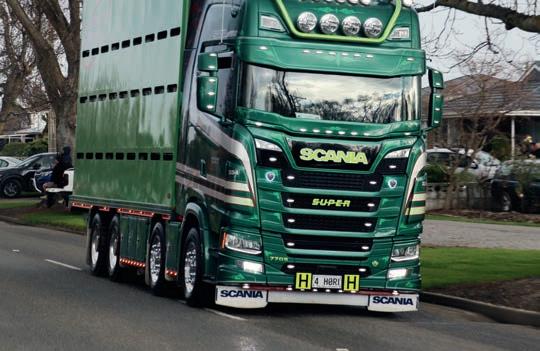



associated with the various awards. Bruce Robertson compered the prizegiving after acknowledging the recent passing of Alex McLellan, who had been a regular supporter of Gore Truck Show for many years and whose family had just donated a memorial trophy in his honour for the best Kenworth. Bruce also recognised the hard work done by all entrants – especially the stock trucks – to prepare for the show at a difficult time of year for availability due to it being very busy with herd shifts to winter grazing.
The King Rig title was awarded to Daryl Shand, operations manager from Freight Haulage. This was the second time FHL No.29 has won this trophy; it also claimed the same prize in 2016 with Lindsay Stuck as the entrant. Coincidentally, Lindsay also won the King Rig title last year with a Scania R620, so the trophy is no stranger to the Freight Haulage office. Daryl has worked at Freight Haulage for 22 years in various roles and his son Ryan works at Truck Stops and successfully showed a FHL Mack, taking away the Best Mack and Best Tractor Unit awards.



Andy
showed off the new rig he drives for Open Country Dairy in Invercargill.


KingRig Daryl Shand Freight Haulage (Volvo FM)


0-40,000km AJ Beatty Herberts Transport (Scania P360)
40,000-100,000km Rob Singh Carters Tyres (Isuzu NPR)
400,000-700,000km Jamie Peterson Scott Transport (Kenworth T909)
700,000-1,000,000km Richard Parish Fonterra (Scania G540)
1,000,000km+ Robert Galt Eden Haulage (Kenworth K200)
BestIsuzu Rob Singh Carters Tyres
BestFreightliner Coltin Manson Booths Transport
BestScania AJ Beatty Herberts Transport
BestMercedes-Benz Jamie Ferris Healy Transport
BestHino Craig Chamberlain Easy Bins Southland
BestKenworth Robert Galt Eden Haulage
BestMitsubishi McDonough Contracting
BestVolvo Barry Ramsay Freight Haulage
BestMack Ryan Shand Freight Haulage
BestMAN Quade Payne Waikaka Transport
BestNissan/UD Glen Hornell Kings Log Transport
BestDAF Erin Wright Herberts Transport
BestIVECO Brent Robinson Three Rivers Contracting
BestOther Phil Collinson Eden Haulage (Western Star)
BestHWRichardsonGroup Gerry Phillips Dynes Transport (Kenworth K124)
BestFemaleDriver Amanda Baldwin Easy Bins Southland
BestLogger Jamie Peterson Scott Transport
BestBulkTruck Brendan Brand Hokonui Rural transport (Kenworth K200)
BestTimberCartage Gerry Phillips Dynes Transport (Kenworth K124)
BestCurtainsider Colin Manson Booths Transport (Freightliner Argosy)
BestBulkSpreader AJ Beaty Herberts Transport (Scania P360)
BestStockTruck Luke Hayward Ryal Bush Transport (International T-Line)
BestTractorUnit Ryan Shand Freight Haulage (Mack Anthem)
BestTanker Brian Hodgson Hodgson Contracting (Kenworth K200)
BestLinehaul Robert Galt Eden Haulage (Kenworth K200)
BestLightVehicle Rob Singh Carters Tyres (Isuzu NPR)
BestPassengerVehicle Anne Brown Go Bus (FUSO)
BestCraneTruck Rob Wylie Powernet (Hino 500)
BestStockFeedTruck Shawn “Fraggle” Cross Wilkins Farming (Kenworth K200)
FurthestTravelled Chris Berghan Martinborough Transport (Scania S770)
TidiestOldWorkingTruck McDonough Contracting (International Eagle)
BestRefurbishedTruck Gerry Phillips Dynes Transport (Kenworth K124)
BestVintageTruck Paul Clarke P I Clarke Ltd (Ford D2418)
BestFleet Easy Bins Southland
BestPaintJob Chris Butler
People’sChoice Chris Berghan
Switzers Valley Transport (Kenworth K200)
Martinborough Transport (Scania S770)






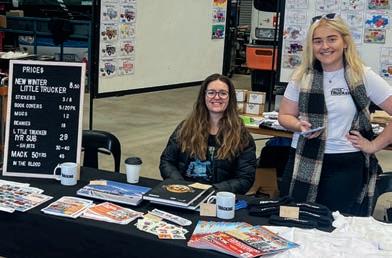
Young truck fans were out in droves at the 2024 Gore Truck Show, and the team at Little Trucker Down Under loved catching up with readers.
Locals lined Main Street in Gore last month for the truck parade as part of the annual McDonough Contracting Gore Truck Show.
From concrete mixers to cattle transporters, tow trucks and fire engines, around 100 trucks of all shapes and sizes paraded up and down Gore’s main strip following the market day that saw a yard full of colouring competitions, sausage sizzles, truck toys and Little Trucker Down Under merchandise.
While the trucks were the obvious draw card, seeing all the younger fans come out to enjoy the show was a highlight for the Little Trucker Down Under team.
“It was great to see so many

beautiful trucks on display, and to see how much the region supports the trucking industry by coming along to this show every year,” says Shannon Williams, editor of Little Trucker Down Under
“But the highlight was seeing all the young people come along with their families and their enthusiasm for trucking. We had so many little ones come up to our Little Trucker Down Under stand, and most were already huge fans of the magazine –which is great to see!
“We also loved introducing the magazine to those who haven’t seen it before. Well done to the organisers who put the show together – it was a fantastic day out.”
Maddy McCoid, Little Trucker Down Under business development manager, says meeting so many truck fans was fantastic.
“We had people of all ages coming up to say hi at the Little

Trucker stand. It was a great mix of current readers and people new to the Little Trucker Down Under fanbase.
“The great thing about our magazine is that it is designed to encourage young people into the trucking industry, to show them what it is all about at an early age. Events like the Gore Truck Show help to showcase not only the beautiful trucks, but the great transport community young people can be a part of.”
New Zealand Trucking field editor Carl Kirkbeck says the Gore Truck Show is one of those shows you need to add to your bucket list.
“Rhonda Wilson and the organisational team do a superb job of making the show the success it is, and this year was no exception,” he says.
“The level of dedication shown by the drivers and their support crews in preparing the units was exceptional, especially considering the time of the year
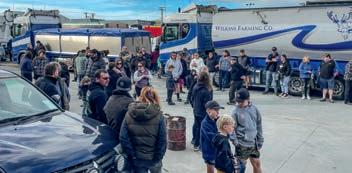
By Shannon Williams
the show is held and the state of the nation’s roads. However, the result of all that elbow grease on the end of the polishing rags certainly makes for a stunning display and parade that the public, both young and old, truly enjoy.”
The Little Trucker Down Under stand featured a wide range of Little Trucker merchandise, including T-shirts, stickers, exercise book covers, as well as New Zealand Trucking beanies and mugs, and a whole lot more. The winter 2024 magazine was also up for grabs.
Were you at the show?
Send your pics to shannon@ nztrucking.co.nz and they could appear in the next Little Trucker Down Under
Did you miss out?
Scan the QR code to go to littletruckerdownunder. com. There, you can shop for merch, get the latest issue, or subscribe.

Wheels at Wānaka 2025 – there is only one road, and it leads straight there!

If decibels were currency, then Goodman Contractors would be Fort Knox! Here, the V8 Detroit powering the company’s immaculate WABCO 222F single-engine elevating scraper sings the symphony of an era largely gone nowadays, sad as that may be. Hearing it was pure joy.




PN# 03079001651
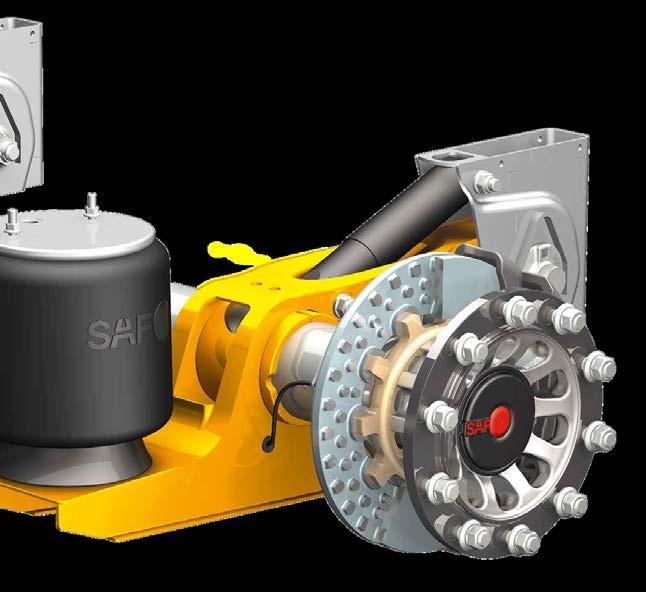

Proven over decades in the trailer area: The special design of the SAF INTRADISC plus INTEGRAL increases the service life on your braking discs and pads.
Unlike conventional brake disks, SAF INTEGRAL is a two-piece brake disc.
The unique design principle prolongs the service life of the pads and the disc, meaning your trailer can stay on the road for longer with less maintenance costs.
Significantly lower heat transfer between disc and wheel hub.
100% more heat dissipating surface than traditional brake discs.
60% more ventilation.
Conical ventilation channels for maximum interior ventilation.
10 ventilation channels under the brake disc.
10 additional ventilation channels under the adapter ring.
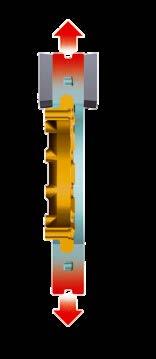
The INTEGRAL disc is cast onto a splined adapter ring.
By composite casting of disc and adapter, the disc can expand radially and contract again during cool down.
RADIAL expansion results in no hot spots or distortion as we see in conventional brake discs.
Expansion only radial
Since the braking surfaces stay absolutely flat in every operating state, the discs and pads last far longer.
Fleet Solutions:Parts Solutions:
transpecs.co.nz
0800 875 669
cs@transpecs.co.nz

twlnz.co.nz
0508 677 704
online@twlnz.co.nz

Hamish Cole A.K.A ‘Stretch’ leaves the vineyard in his 1980 R612RS

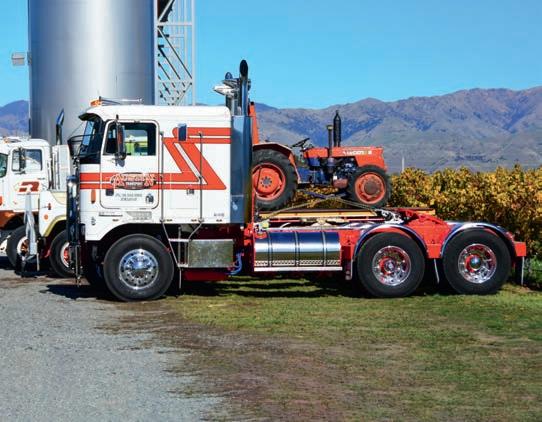
Some famous brands from the 70s and 80s.
Murray and Lynette

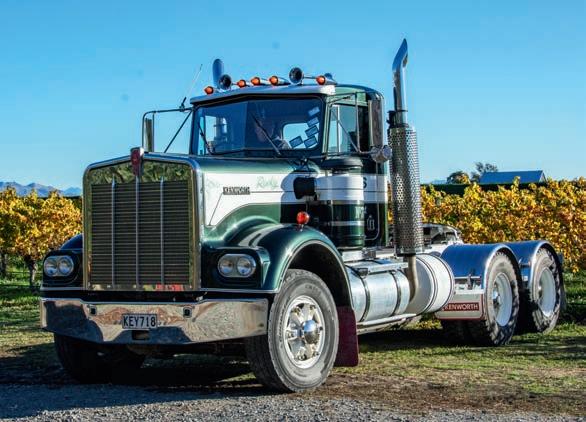

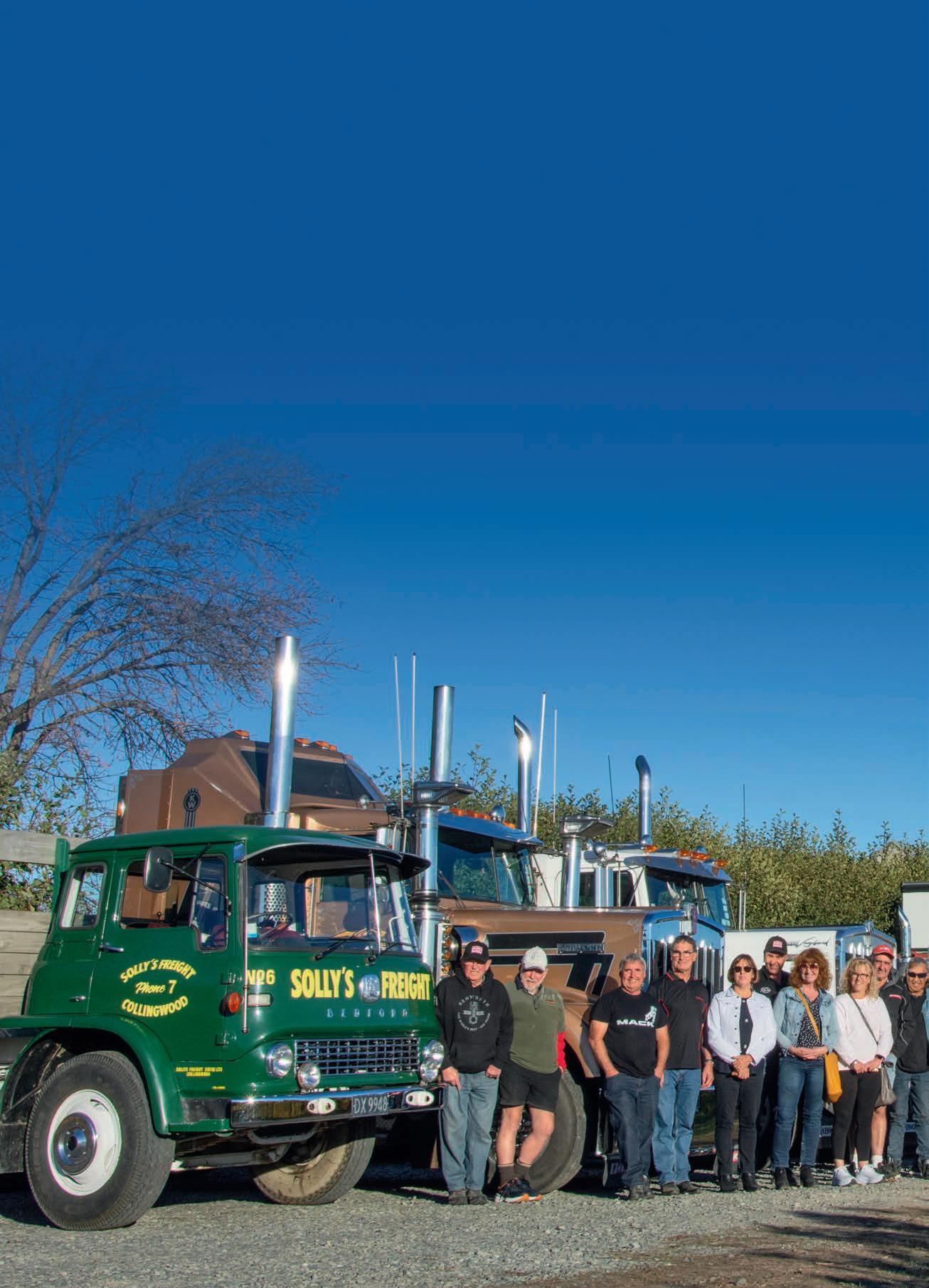
Travelling in a 1980 W-Model Kenworth named Rocky through the Upper South Island with New Zealand Trucking’s Dave McCoid gave Milly McCauley insight into the evolving classic truck movement.
Story by Milly McCauley
The Top of the South classic truck group is an informal gathering of people with a common interest in taking their classic trucks out and about, instead of them sitting in sheds and not being enjoyed.
Lisa Austin, Geoff Webby and Murray Bruning organised the event, which involved a threeday run starting in Nelson. There were about a dozen participants.
On day one, the trucks travelled from Nelson through the Rai Valley and Havelock to Blenheim, where the event was
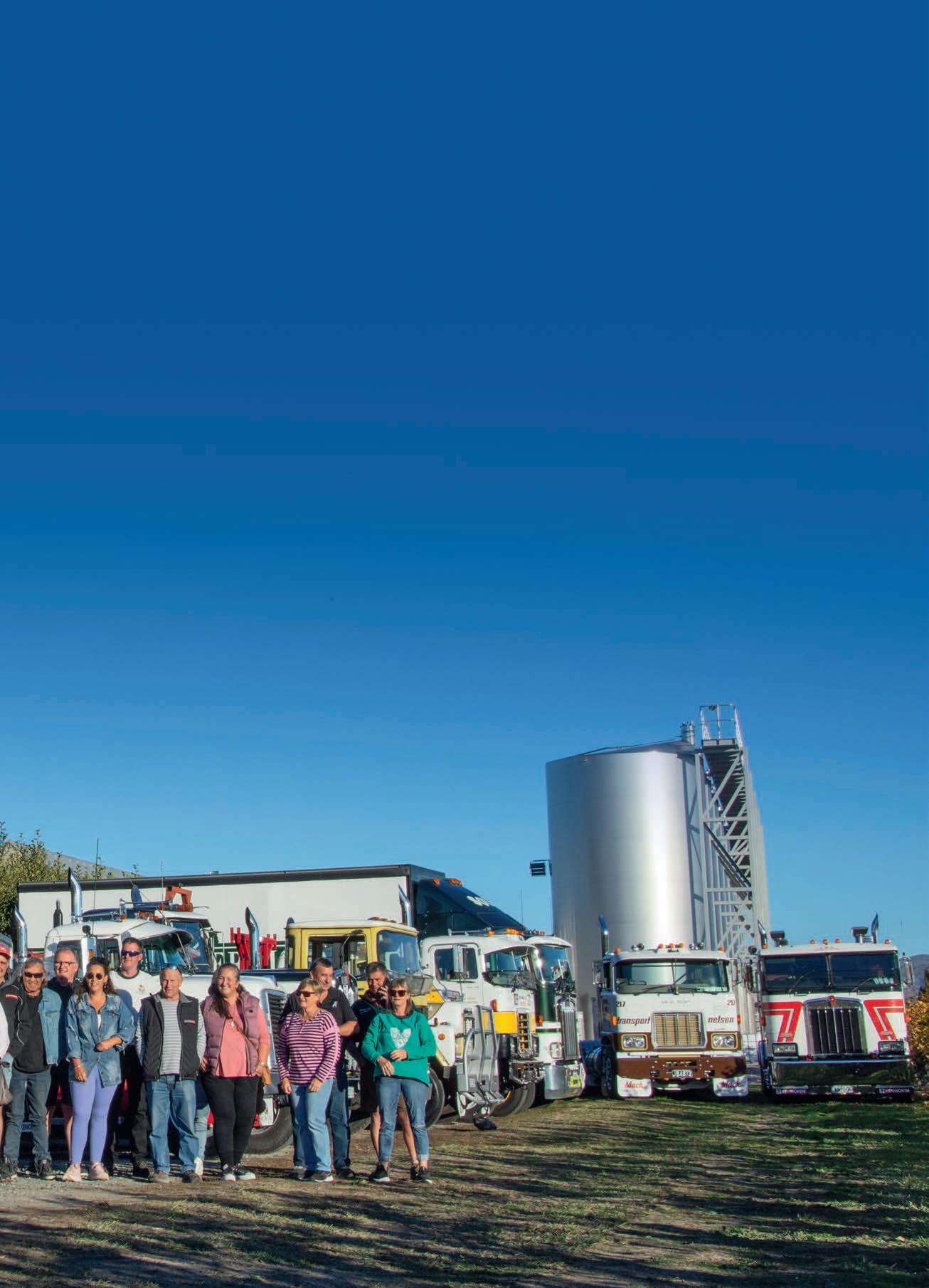
Photos by Milly McCauley & Dave McCoid
centred. New Zealand Trucking magazine met the group on the morning of day two at Wadsco Truck’s Blenheim premises.
Local interest in the group’s vehicles was strong, with many turning up to have a look at the selection of trucks originating mainly from the 1970s and early 1980s. Many workhorses that would have been on the road in that era were there, including Mack’s R and F trucks, various Kenworths and several trucks of British origin.
Several local Marlboroughoperated trucks arrived and
joined the group for a run up SH1 to picturesque Picton, where the trucks were left on the waterfront while the troops had morning tea.
After a period of socialising, it was back through the myriad of grapevines the district is famous for to the Allan Scott Family Winemakers vineyard, located between Blenheim and Renwick. The vineyard has a cellar door and bistro and some folks participated in the hospitality on offer while others just mingled. The trucks were arranged for a group photograph, and as the


last rays of sun dropped behind the Richmond Ranges, a convoy rolled out the winery gate and headed back into Blenheim.
As the trucks rolled out, the passion, commitment and dedication of those determined to preserve these notable rigs of New Zealand’s trucking past were evident.
Co-organiser Murray Bruning explains that they wanted to keep the event predominately about vintage non-working trucks. However, there is a spot for five modern trucks at a time in each run in the future.
It is the group’s intention to continue with runs and visits to events of interest, including local A&P Shows.
My thanks to the Top of the South Classic Truck crew for being so welcoming and to Ed Solly for allowing Dave and I to take Rocky across from Nelson to join in.








Eru Graham was crossing the Kaimais in Blue Genesis, the Dynes Kenworth K220, when Gavin Myers came up behind him, heading in the same direction. Luckily, Eru stopped in Te Poi for a quick bite, so Gavin pulled over, too, to say G’day and have a quick yarn.
Eru is based in Mt Maunganui and was on his regular run to Auckland, though he says he’s been “all over” in the K220. The day before, Blue Genesis had clocked over to 160,000km. It went on the road in early 2023.
“It’s a good truck. The digital dash took getting used to after the K200s, but it’s still a Kenworth, you know?” he says.
Eru has been driving for Dynes for four years now. “I’m enjoying it. Dynes is a good crowd. There are a lot of worse places to work. These fellas are all right … I was lucky walking back into a good job at a good company and with good work.”
Before that, Eru spent 15 years in Australia. “I was a fencer by trade, but I injured my back twice and had to have surgery – which meant I could no longer do my old physical work. Work Cover in Oz made sure my employers found other ways for me to earn a living, doing less physical, manual work. So, I ended up driving. It was by fluke, really. I’ve been doing it since – a good 15 years or so now.”
Eru says an industry positive is that the community is so close. “Although that could be a bad thing too,” he adds with a laugh. “The only other thing we really have to deal with that’s an issue is the quality of the roads.”
He reckons another positive for the industry is electronic logbooks. “The older guys don’t like it, but my family shares the roads with these blokes, you know?” Eru adds. “I can only speak for myself, but thankfully, I don’t have any unreasonable deadlines. I’m left to do things slowly and safely.”
Eru’s vexing question was a breakfast of bacon and eggs or fresh fruit and muesli. “Bacon and eggs, that’s an easy one!” he says with a hearty laugh.
Northland photographer Jaymin McGuire recently ventured to the South Island and spotted the gleaming 2019 Kenworth K200 driven by Kerry Taylor.
Kerry, who works for Martinborough Transport, shared his


journey into the trucking world, which started with his father. “What kicked it all off was the old man going for rides; eventually, he got me a job at his work,” Kerry says.
On that day, Kerry was en route to Silver Fern Farms Ashburton, one of the many destinations he covers for his stock transport work. Kerry reckons the best part about driving is that he’s a “paid tourist”.
“You could be in the North Island one day and at the bottom of the South the next,” he says, appreciating the unique opportunities his job provides.
Kerry’s pride in his truck is evident. “The K200 is definitely my favourite. It’s been my dream truck since I was a little boy – just the KW brand in general, really.” The K200 is fitted with the venerable Cummins X-15 and 18-speed Roadranger combo.
Despite his passion for trucking, Kerry acknowledges the industry’s challenges. “From a stock truck driver’s view, there are bugger-all stock effluent dumps around the country. It’s really frustrating because we have no place to dump out effluent,” he explains.
If he were Transport Minister, Kerry knows what he’d prioritise: “Build more effluent dumps, especially along state highways. And more supervision and training for drivers obtaining their HT across all classes for drivers unfamiliar with New Zealand roads.”
When asked about his preference between wine, beer, or whiskey, Kerry’s answer is decisive: “Definitely, whiskey.”

Out here, standard is just the starting point. We believe in pushing the limits. For over 50 years, Mack Trucks have outpowered, outlasted and outperformed to earn their best-in-class reputation. With new upgrades to horsepower, torque, fuel-efficiency, driver comfort and safety, Mack is setting the standard once again.



Story by Faye Lougher

Photos: As credited
As retirement plans go, buying a haulage company doesn’t stand out as an easy option, but the couple who bought longestablished Kāpiti company Clive Taylor Ltd are no strangers to hard work.
Three years ago, Andrew (‘Sooty’) and Tania Breach were living in Taranaki and working in the oil and gas sector – Sooty as a mechanic/crane operator on offshore rigs and Tania as operations manager for Wood Group Training.
The Labour government at that time had indicated its desire to overhaul the industry, banning future offshore oil and gas exploration. The couple realised their careers were no longer secure and started looking for a new venture.
Before moving into the energy sector, Sooty had extensive experience as a mechanic and driver. After leaving New Plymouth Boys’ High School, he completed an apprenticeship at the local Ford franchise and then worked for Ross Graham Motors, which had the contract working on Hooker Brothers Fleet (now MOVe).
During the 12 months Sooty worked there, he started driving trucks, a skill he needed for CoFs and road testing.
“I always wanted to be a truck driver, I guess, but it was really
hard to get a truck driving job back then. I hassled Chris West of AR West Logging in Ōakura. I was employed as a mechanic/ truck driver there but, basically, drove during the week and then spent all day Saturday fixing broken springs and doing brake relines.” A highlight was contracting to Pacific Haulage in Gisborne, carting export to the Mount and bringing loads from Te Teko to the Gisborne Wharf.
After 12 to 18 months, a job opened at McCarthy Transport when it started basing trucks in New Plymouth.
“I drove for Mark McCarthy for about 12 to 18 months, and then he bought AR West Logging, and all those boys came over. It was one big happy family.”
Sooty spent about four years working for McCarthy’s before deciding he’d had enough of logging and wanted to try
something new. He then moved to JD Hickman. “I worked my way up from the shittiest truck to the flashest one. Then John put me in the office as a sales rep/manager to see if I liked that.”
Deciding he wanted to be an owner-driver, Sooty left in about 1998 and went to work for an owner-driver at Owens Tankers, driving a CH Mack. After 12 months doing fuel, he was offered a contract of his own and bought his first truck.
A change in company structure about six months later saw Sooty get a job at Hooker Pacific, carting LPG in the winter and hot bitumen and petrol in the summer. After a few years, the first of the big fuel crises came through, and he sold both his trucks to other ownerdrivers internally at Hookers, finished the month, and did some part-time work for
J Swap driving an alloy tipper.
A few friends were working on the offshore rigs and he thought he’d give it a go, paying to take a BOSIET [Basic Offshore Safety Induction and Emergency Training] course.
“I worked for Halliburton International for about six months or so as a labourer and went offshore on a couple of facilities and also a couple of land rigs. I loved it. Then I chased a job offshore on a rig doing exploration drilling just off Waitara.”
Sooty started as a roustabout, doing basic labouring, until a job came up as an assistant mechanic on permanent night shift.
“I didn’t know what the hell I was doing, to be honest, but I faked it till I made it! I was there for a couple of years, and when that demobbed overseas, we towed the rig to Nelson. Then I got on the heavy lift ship to Singapore.”
Sooty returned to New Zealand to find he had no job and no wife. Another offshore job came up, and he worked on
Maui A and Maui B for about three and a half years.
“I had a bit of a claim to fame because I reckon I’ve worked on every offshore installation in New Zealand – 107 and Kupe and a couple of others. It was a good life.”
From there, Sooty went onto an FPSO – a floating production storage offtake vessel – working as a mechanic for a couple of years before moving onto the platform a kilometre away as a mechanic/offshore crane operator.
By now, Sooty and Tania were a couple, having met while working in the same industry.
Born in Lower Hutt, Tania grew up in New Plymouth, doing a business and office skills course when she left school.
“I ended up working for an accounting firm, which I hated. I went and worked in Australia for a year before coming back and working for the Union Steamship Company based at Port Taranaki. Another part of the business was New Zealand Offshore Services, and that was when I first got into the oil and
gas industry.”
At the time, the Maui B was being built offshore and the company Tania worked for supplied the labour, catering and marine crew for the project. She worked in the industry for about seven years before leaving and having her children. She returned to the industry when her youngest was two and worked for another offshore company as crewing manager. Each offshore oil rig had approximately 60 people working on it.
“I looked after various offshore platforms and rigs, and it was a pretty cool job. It took me to some amazing countries around the world, taking guys to join a ship or a rig before it came down to New Zealand. It took me to Panama and Central America, South Korea, Singapore, Noumea, Cairns, Hawaii, and Seattle in the States. I looked after the guys and their rosters as well as their training, their flights, accommodation, transfers out to the rig by helicopter, everything.”
Tania says that’s where she
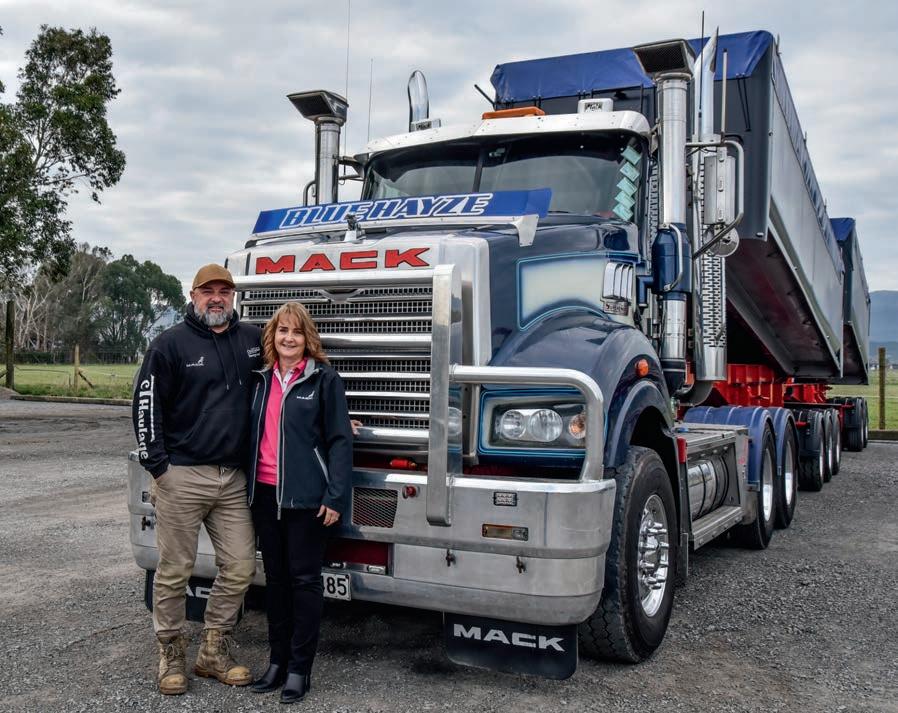
developed her passion for training. “It was like a big jigsaw puzzle that you had to put together to get a guy offshore and to his rotation, organising all that as well as liaising with them on the HR side of it as well.”
Tania spent most of her career in the energy sector, but in 2016, she was made redundant. She spent six months working for another offshore company looking after a dive support vessel, before gaining a job at Wood Group Training in New Plymouth.
The company is a major provider of safety training and consultative services to the oil and gas, energy, food processing, transport, construction, engineering and manufacturing, marine, aviation and government sectors.
“They did helicopter underwater escape training in their marine training centre, and they had a huge hot-fire training centre too. There was also training in first aid, heights, confined space entry, gas testing, you name it. I was operations manager there. I basically coordinated all the training staff and the resources that they needed and rostered them on for the training courses.”
Tania worked there for five years until Sooty, having seen the writing on the wall regarding the direction the government was heading, started looking for a new adventure. “I thought about going back to truck driving as an owner-driver and looked at logging contracts,” he says.
“I carried on working and then a mate of mine down in Paraparaumu said that Clive Taylor was for sale and thought I’d come down and have a look.
“I came down on my own and my mate dropped me off at Clive’s yard, and we had a bit of a chat. He had all this stuff written down on a piece of paper by hand and that was the complete list. ‘This is how much it’s valued at. If you want it, go and find some money!’”
Sooty says he couldn’t understand why the wellrespected company had not had people fighting over it.
“That was my biggest fear – he had capable truck drivers who had their own businesses who could have invested and taken it on but none of them did. And that was the biggest thing, I thought, ‘Why not?’”
Sooty looked at what was on offer and accepted the challenge of buying the company, taking over on 1 February 2021.
“Clive was very good to deal with; it was a handshake – oldschool stuff. That suited us, and it suited him. So we trotted off and tried to find some money and bloody ripped into it, and that was pretty much it.”

Tania carried on working in Taranaki for about six months until they realised the business needed both of them on deck in order to grow.
“We’ve taken the business from a company that had pretty much nothing in place for HR or health and safety, to where we are today. We started from scratch. We had three drivers and nine trucks when we bought the business off Clive. In the space of three years, we’ve now got about 20 trucks and 17 drivers.”
Sooty says when they took over there were only a few clients – one of which was Higgins – and worked mainly on the local expressway projects.
“We’ve grown the business. We’ve got a good customer

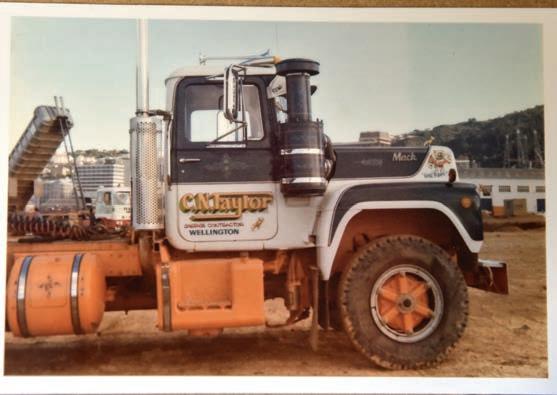

base now. My whole focus was finding work outside of that while still trying to maintain that good service to Higgins and Fletchers, which I felt we did.
“We have this policy of ‘don’t say no’ to anyone; the phone rings, we say ‘yes’ and figure out how to do it later on, and that worked well for us. One day, I was looking at the two latermodel trucks I bought off Clive. One was an alloy unit, the other a Hardox unit and I thought, ‘The Hardox one is carting rock, that’s the way to go.’ So that’s what we put on the road.”
He says it made sense, because hardly anyone has an aluminium unit in Wellington – they’re mostly truck-only in construction and civil work.
“I imported two highkilometre trucks out of Australia because, at that time, it was taking anywhere from 18 months to two years to get a truck. So we imported our own with Murray Sowerby. He brought them in for us. We got bins made and got them all painted and tidied up and they’re still working today. They’re good trucks.”
Not long before the couple bought the business, Clive had sold Rock Dog – an eight-axle 2017 Trident tipper – and one of the first things Sooty did was repurchase it and return it to the fleet.
Sooty and Tania retained the Clive Taylor name, but added the word ‘Haulage’. Sooty says the Clive Taylor brand was good. “We’re never going to change it, and we never wanted to. It was always going to stay Clive Taylor, and he was more than happy with that.
“Even when I was an ownerdriver, I never had my name on the side of my trucks. We’re not here to have a legendary status or make a name for ourselves. We’ve got a small window to be successful here – 10 or 15 years – and then the place is going to be sold. We’ve got to try and do everything right that we can in the small window we’ve got.”
They also kept the signwriting the same, including the company name on the back in red. Tania says Clive gets phone calls and texts and pictures from his mates who see his trucks on the road. “He’s reminded constantly and he’s stoked.”
Driver Andy Maynard moved into a role as operations manager when the company changed hands. “He was just one of the boys when we bought the company. Him, Les Addis and CJ were the longeststanding drivers,” says Sooty.
“They weren’t that busy, doing bits and pieces, so I said, ‘The whole focus is for you guys to be out driving your trucks. I don’t want to see you
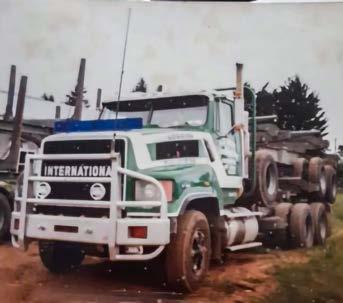


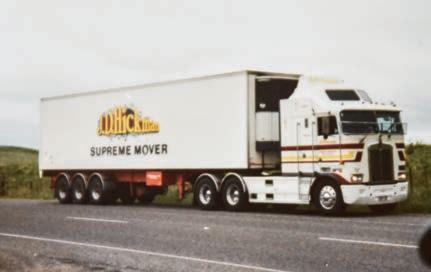

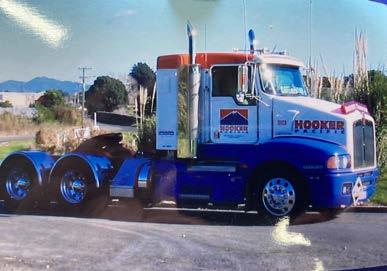
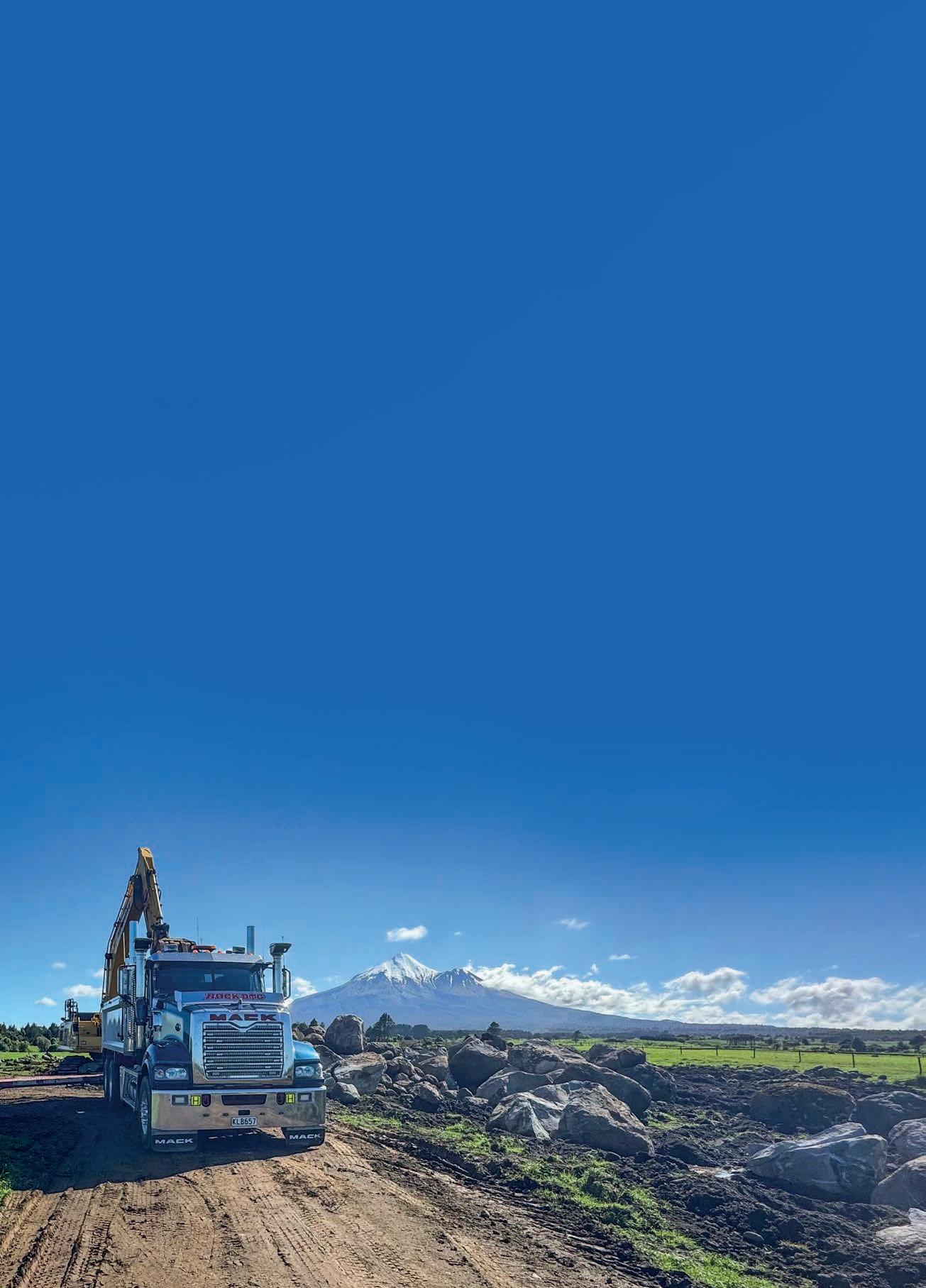
in the yard.’ It wasn’t really that hard to get them busy and motivated. Andy showed an early sign that he’d like to be in the office or dispatching when we interviewed him, and he’s been steering his career in that direction.
“With all our staff, we give them the tools to go and do the job and we expect them to selfmanage. They get a good idea of what’s expected and we try to keep out of their faces as much as we can, and let them go out and do the job properly.”
Sooty says as the company started getting busier, they employed a driver to replace Andy. “We got Andy into a management/truck driver role for starters, which he’s embraced. We’ve just worked with him from there and he’s full-time off the road now.”
The couple say that the business wouldn’t be where it is today without Andy’s help, input, local knowledge and contacts.
With Tania’s background, instigating robust health and safety practices was a priority. “I started with the basics, getting some good practices under way. Toolbox checks and safe operating procedures and training were the big things. The guys didn’t have any training. They didn’t have first aid or what I would call basic practices, so
I started from the ground up, really.”
Sooty says their first health and safety meeting was around the barbecue table out in the shed. “We printed off all the topics we were going to talk about and they all sat there and looked at it and thought, ‘What the hell’s going on here?’ We gave them our safety manual so they could all read it and understand that this is where we’re heading, what we’re doing.”
Tania says the key thing is that everyone – and she singles out Andy in particular – really embraced it, despite having come from a background where there had been nothing in place before. “With our backgrounds, that’s the first thing you do,” says Sooty. “You have a meeting, you have a chat, you have a hui, then go do the do-ey, and it’s grown from there.”
The company has also moved from a paper-based job docket and timesheet system to digital.
“Judith, our awesome accounts manager, was parttime with Clive and she’s now full-time with us. We would be lost without her attention to detail and expertise. She’s really embraced that as well, going from that paper-based system to what we use now – MyTrucking for all our job allocations to EROAD on all the vehicles, and we do inspections using the
EROAD inspect app. We use Safe365 apps for accidents or safety observations – the list goes on. Everything now is pretty much based off the guys’ phones, their time logs, incident reports, everything,” says Tania.
The company is Tōtikaaccredited for health and safety pre-qualifications, and Amotairegistered because Sooty has whakapapa links to Ngāpuhi.
Tania says the couple is keen to get class 5 drivers into the industry, training them up if necessary. “We don’t have anyone we’re training at the moment. We’ve actually got a really plentiful supply of drivers and lots of applications every week from people looking for jobs with us, so we’re very lucky. I think we get quite a following with the Mack branding and the Mack trucks. The average age of a truck driver is 57, and the majority of our guys would be in their 30s.”
The next big project in the pipeline is the Ōtaki to north of Levin Expressway construction, expected to start next year.
“That’s what everyone’s waiting for,” says Sooty. “We were sitting in the motorhome that night when we were umming and ahhing whether to buy this place and there was an article on the 6pm news about the next section. We were months away from buying the place, but they said on the news

that Ōtaki to north of Levin would be getting under way. We thought, ‘Right, that’s our ticket’. And now we’re sitting here waiting, four years later.”
Sooty says he hadn’t realised the downturn in the industry was going to have such a longlasting impact. “We should have reacted probably from a business side of things a little earlier. The plan towards the end of last year was to zone in on our fleet, get rid of the old gear and just look for efficiencies. Now, it’s more of a requirement than a wish-list. It’s very hard
and only getting harder.
“We’ve got a great team, great drivers, who take real pride in their gear. All our gear looks sharp, and there’s only one way that can happen – and I ain’t polishing anyone else’s truck!” says Sooty with a laugh.
“They do it themselves. They’re all very, very proud of the equipment they drive, and we like to think we give them the right tools for the job and support them in that way. We don’t hold back on the on the bling and the practical stuff for them to go and do their job.”


Before Clive Taylor left the company he started in the 1970s, new owners Sooty and Tania Breach recorded a video of his memories that you can watch on the company’s website.
Born in Wellington in 1943, Clive Taylor moved to Raumati with his parents when he was two. After leaving school at 15, he worked in the building trade for a few years but really wanted to work in the automotive industry, so he left and worked in a garage.
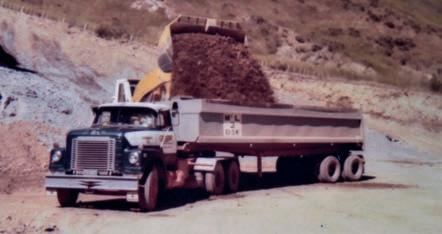

A friend was working for a shingle company where Clive got a job driving a tip truck and running the crushing plant. From there he went to work for Car Haulaways in Paekākāriki.
“We used to leave there at two o’clock in the morning and drive through to Auckland, stay there overnight, and then unload,
reload and the next morning we’d drive home again. We had to go up the Paraparas [SH4 between Raetihi and Whanganui] in those days because we couldn’t get under the bridge at Mangaweka.”
Clive’s next move was into refrigerated transport with RFL Refrigerated Freight Lines, carting ice cream from the Tip Top factory in Johnsonville, as well as loads of export meat and Wattie’s products.
“I did that for three and a half years and I really enjoyed it. It was long hours. You might leave on Sunday and get home Friday night. We always had a motto, ‘If you weren’t half an hour early, you were running late,’ because you didn’t know whether you could get roadworks, a puncture, or whatever.”
About this time, Clive thought he’d like to own his own truck, and borrowed $5000 from his mother to buy a second-hand truck and secure work as an owner-driver for a carrying company in Petone. “I didn’t really want to go out on my own because it was tough, even in those days.
“In those days, you needed a vehicle authority, which is like a carrying licence, and I never had one. I used to whiz into town, and then the cops would be looking for me, so I’d have to come home and hide and then I’d go back at 4am the next day!”


4)
Clive realised he’d have to get a licence in order to survive, and was soon in a position where he gained work on the reclamation extension of Aotea Quay in Wellington. “That’s how I started, with one old truck, and then I got a brand new semi built and we started work on the reclamation.”
Each day, when he finished work on the harbour project, Clive would drive home to Raumati, load sand and deliver it back to Wellington, before returning to reload for the following day. “I got to bed at probably 11.30pm or midnight, and then I’d be away again at 5am.”
Clive’s first new truck was a Mack, and he says the service he received from Ron Carpenter and the team he headed was unparalleled. “Mack has been wonderful; the product, plus the backup of having mechanics who used to come down and work on my truck until midnight because I had to leave at 5am. They’d be here whatever
happened, and if something went wrong, they’d give you another truck to use while your one was getting fixed.”
Clive has lost count of how many new and used Mack trucks he has bought over the years but says the brand played a big part in the business’ success.
In the beginning, it was based at Clive’s home. As the land around him was developed, he needed larger premises and bought the old council yard in Paraparaumu, moving his expanding business there.
Eventually Clive’s son Darren, a spray painter by trade, joined the business.
In more recent times, they worked on three major roading projects in the lower North Island – Transmission Gully, McKays to Peka Peka, and Peka Peka to Ōtaki. The next project is Ōtaki to north of Levin – work Clive Taylor Haulage will no doubt be involved with.
“Sooty and Tania have been amazing. I couldn’t ask for a better couple to take over the

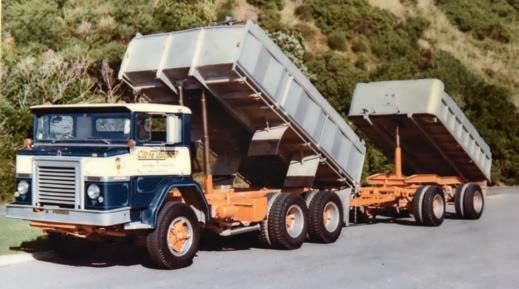
business and carry on the name. It’s been really wonderful and I’m really proud of them.”
Clive says he has put in a lot of hard work and long hours over the years, and running
the business has been quite stressful at times. “I will miss the old truck, well, all of the trucks and all the bits and pieces here. But that’s life. We’ve just got to move on.”



Contacts:



In the mid-2000s, the sales brochure for the LT SuperLiner summed it all up in one single sentence.
The LT, affectionately known as King Kuri, on the job doing what it does best.

When the Mack Super-Liner LT was released in the mid-2000s by Mack Trucks Australia, the promotional brochure graphically announced, ‘We’ve unleashed a monster’. Thirty years on, Andrew ‘Sooty’ Breach has realised a dream, and tamed one of these impressive beasts.
The LT Super-Liner is one of those trucks that makes you stop and stare no matter your stable preference. It exudes a presence that lives up to the media hype generated when the model was released. Phrases like ‘it’s big, it’s impressive, it’s a tower of linehaul muscle and chrome’ were used to promote the new model. Fair to say, when it hit the road, we were not disappointed.
One of the most striking LTs to go on the road in New Zealand was the 2007 6x4 tractor unit of Menefy Trucking in Palmerston North. “Yeah, that was a cool

truck. When I used to see it on the road, I remember thinking to myself, one day I will get hold of one,” says Sooty.
“When the time came, I tried to purchase one here in New Zealand, but, unfortunately, had no luck. So with the help of our good mate Murray Sowerby, we tracked this one down in Australia. It was a oneowner truck, working in an earthmoving and logging fleet, mostly pulling a transporter, shifting machinery. Murray was awesome, arranging the legals and getting it shipped over for us, as well as assisting with compliance.”
The LT Super-Liner was offered new with either the Cummins Signature or Caterpillar C15 under the hood, both respectively pushing 550hp and 1850lb/ft. “We were after a Cat-powered one, with Roadranger gearbox, Hendrickson suspension and Meritor rear end, and that’s exactly what we have found. From what we know, it was a one-owner truck that was built in 2005, and has just over 980,000km on the clock now. It spent some time in Tasmania on projects there, then moved to mainland Victoria later in its life with that company.
“According to the original owner, the head has never been off the C15, and it was a good reliable unit in their fleet. It was plain Jane when we got it, but you could tell it had been looked after, so that helped with achieving the end result that
you see now,” Sooty explains.
Like the Super-Liner, the trailers also have a connection to Sooty. “The B-train tippers were new in 1998 to PGF in Benneydale. I was living in New Plymouth at the time, driving through to Auckland pretty much daily. This took me right through the King Country, PGF’s backyard, so I would see them most days in my travels. I remember thinking at the time that they looked quite cool. It was a bit over a year ago that I spotted them on Trade Me. They had ended up with a wheat grower on the Takapau Plains. I had a look over them, and I could see that they would fit in amongst what we do as an extra, so the deal was done and we pulled them home.”
Sooty and the team worked the B-train set as they were for about a year, but have now recently completed a full
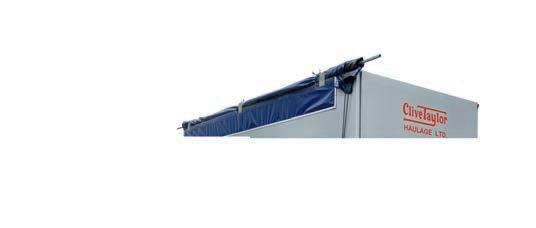


strip-down and rebuild of the trailers. This has brought them back to spec again, legal for a 30-tonne payload as well as now sporting Clive Taylor Haulage fleet colours.
“It was cool that we were able to get the LT all sorted and back on the road again, and in the fleet colours just before Clive packed up and headed off to Australia. He was absolutely stoked to see it parked in the yard and wearing the Clive Taylor livery. I think he was all set to jump in the cab and get back to work,” Sooty says with a smile and a laugh. Being completely honest, who could have blamed him.
The LT Super-Liner is a truck from an era of trucking that we are fast realising was the pinnacle of the mechanical machine. A time where the beast was tamed by the operator behind the steering wheel, swinging off the gear lever. Yes, we now live in different times, but Sooty and the Clive Taylor Haulage team certainly have proven here that there is still a place in the pride for an animal of this nature.








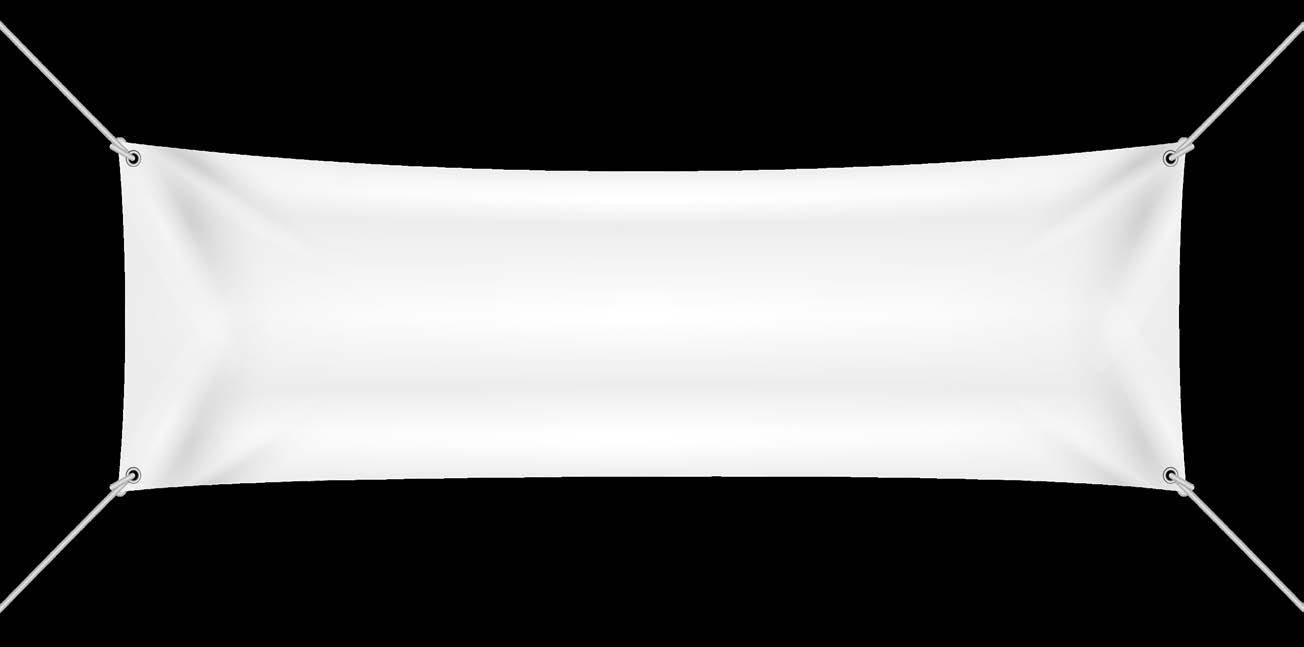

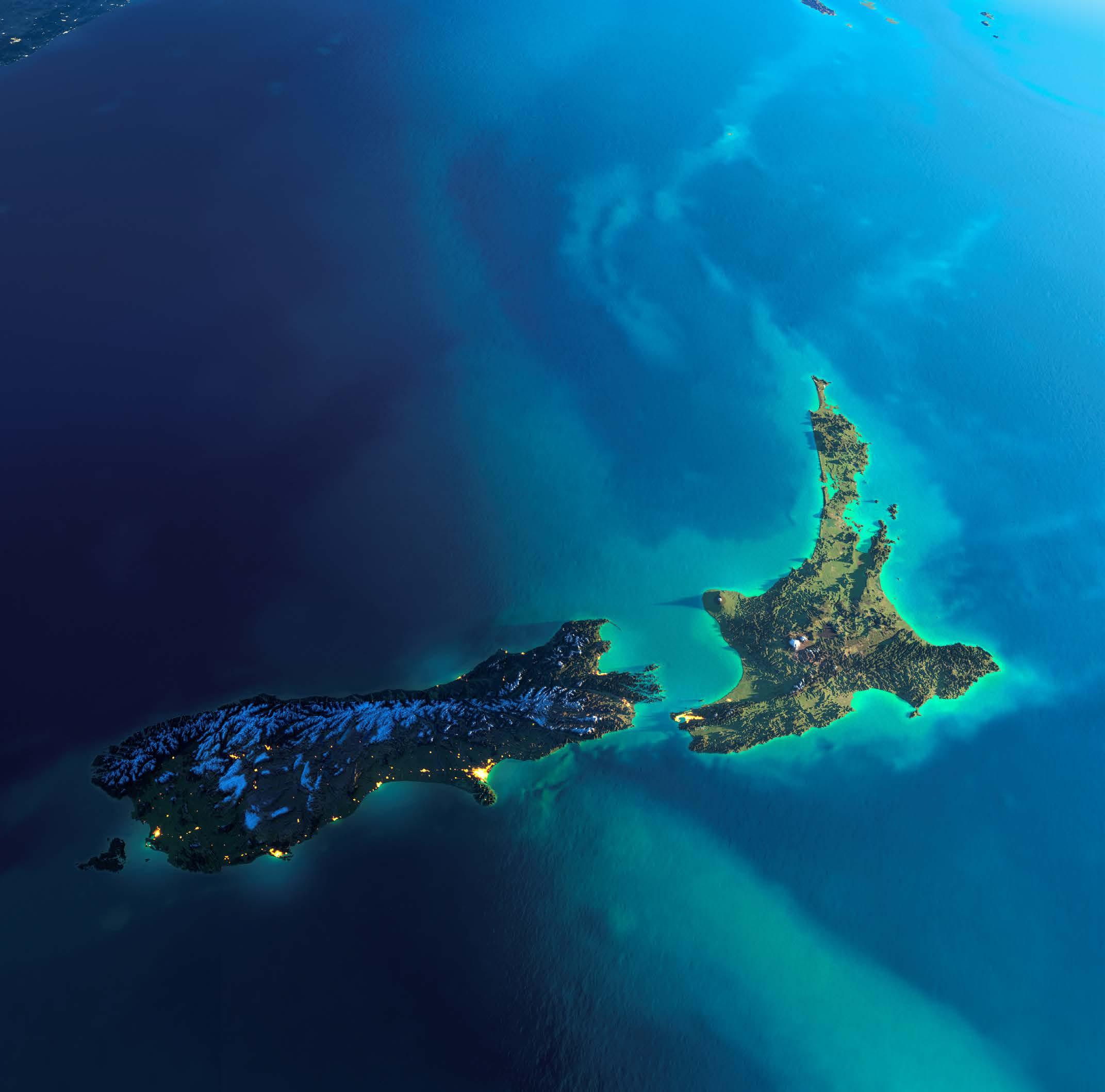



In partnership with the Inspiring Futures Foundation, applications are now open for our 2024 Commercial Road Transport scholarships! These scholarships cover either one qualification or up to three micro-credentials.
Applications close soon so get your application in today!
Scan the QR code below or visit mito.nz/CRTScholarships to apply.

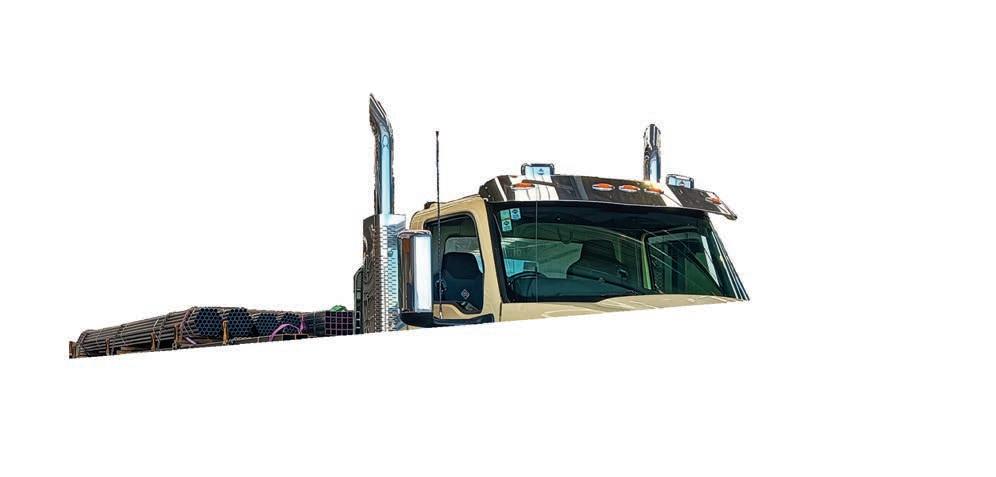

OPERATOR: LT Transport, Lower Hutt
ENGINE: Cummins X-15 15L 410kW (550hp) 2508Nm (1850lb/ft)
TRANSMISSION: Eaton UltraShift MXP
18-speed AMT
REAR AXLES: Meritor MT-14X
REAR SUSPENSION: International IROS
BRAKES: Drum. ABS, EBS
BODY/TRAILER: Roadmaster 14.2m quad flatdeck
FEATURES/EXTRAS: Premium interior trim, sliding fifth wheel, twin exhaust stacks
OPERATOR: Edmonds Transport and Earthmoving, Ongaonga
ENGINE: Scania DC16 16L Euro-6 574kW (770hp) 3700Nm (2729lb/ft)
TRANSMISSION: Scania Opticruise GRSO926R 12-speed AMT with 4100D retarder
REAR AXLES: Scania RB735 hub reduction
REAR SUSPENSION: Scania air-suspension rear (spring front)
BRAKES: Disc. ABS, EBS
SAFETY: AEB, ACC
BODY/TRAILER: Newport Hardox steel bin with matching refurbished four-axle trailer
FEATURES/EXTRAS: Fridge, V8 leather trim, CTI, Alcoa DuraBright alloy rims all around, Kelsa light bar, drop visor, Euro stone guard, LED beacon
PAINT: HRPP
SIGNAGE: Sign It Up
OPERATION: Aggregate cartage throughout Hawke’s Bay
DRIVER: Amy and Steve Edmonds
SALES: Callan Short
PAINT: Factory
SIGNAGE: Speedy Signs, Seaview
OPERATION: Specialist general freight throughout the lower North Island, with runs through to Auckland at times also
SALES: Hugh Green

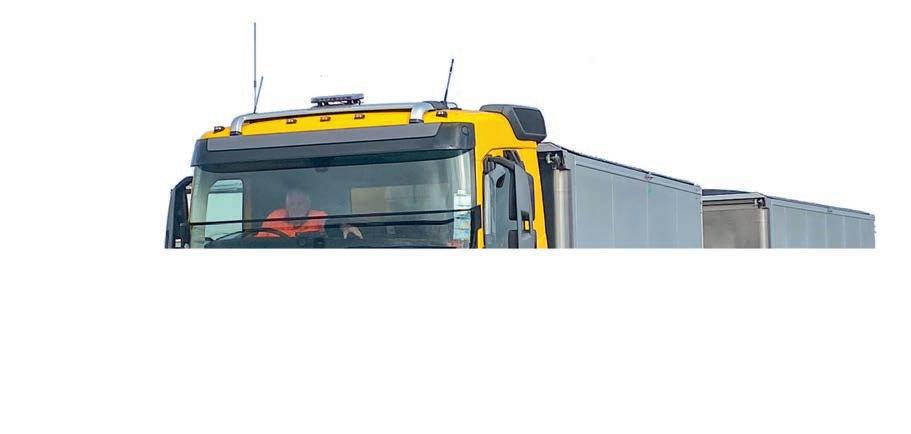

OPERATOR: Stevenson Group, Auckland
ENGINE: Volvo D13K 368kW (500hp) 2500Nm (1844lb/ft)
TRANSMISSION: Volvo I-Shift 12-speed AMT
REAR AXLES: Volvo RTS2370B
REAR SUSPENSION: Volvo eight-bag air suspension
BRAKES: Disc. ABS, EBS
five-axle trailer
SAFETY: Volvo Safety Suite LCS, LKA, DAS, ACC, EBA, passengers side view camera
BODY/TRAILER: Transport & General Transport Trailers tipper body and matching
Scania R660 A6x4NA 6x4 rigid – Highline sleeper cab
OPERATOR: Raj Singh,
ENGINE: Scania DC16 16L Euro-6 485kW (660hp) 3300Nm (2434lb/ft)
TRANSMISSION: Scania Opticruise G33CM1 14-speed AMT with 4700D retarder
REAR AXLES: Scania RB662
REAR SUSPENSION: Scania air suspension rear (spring front)
BRAKES: Disc. ABS, EBS
SAFETY: ABS, EBS, AEB, ACC
BODY/TRAILER: Scania factory tractor setup. Stainless steel by Arcryte, Rotorua
FEATURES/EXTRAS: Scania scales, Highline cab, fridge, coffee machine, microwave, V8 leather trim, overnight A/C unit, CTI, Alcoa Dura-Bright alloy rims all around, drop visor, Euro stone guard
PAINT: Factory
SIGNAGE: Caulfield Signs and Graphics, Rotorua
OPERATION: Floating general freight duties with MOVe Logistics
SALES: Callan Short
FEATURES/EXTRAS: Heated seats, stone guard, Alcoa Dura-Bright alloy rims all around
OPERATION: Aggregate deliveries throughout the Waikato from its base at the Hunua Quarry
SALES: Blair Stapleton



OPERATOR: TCL Haulage, Hautapu
ENGINE: Cummins X-15 15L 459kW (615hp) 2779Nm (2050lb/ft)
TRANSMISSION: Roadranger RTLO20918B
18-speed manual
REAR AXLES: Meritor RT46-160GP with full cross locks
REAR SUSPENSION: Kenworth Airglide 460
BRAKES: Drums. ABS, EBS
BODY/TRAILER: Transfleet bulk bin with matching five-axle Transfleet trailer
FEATURES/EXTRAS: Stainless-steel tank trims, leather seats, fridge, drop visor, air cleaner light trims, classic grille bars
PAINT: Factory
OPERATION: Bulk aggregate deliveries throughout the Waikato
DRIVER: Steve Russell
SALES: Adam McIntosh
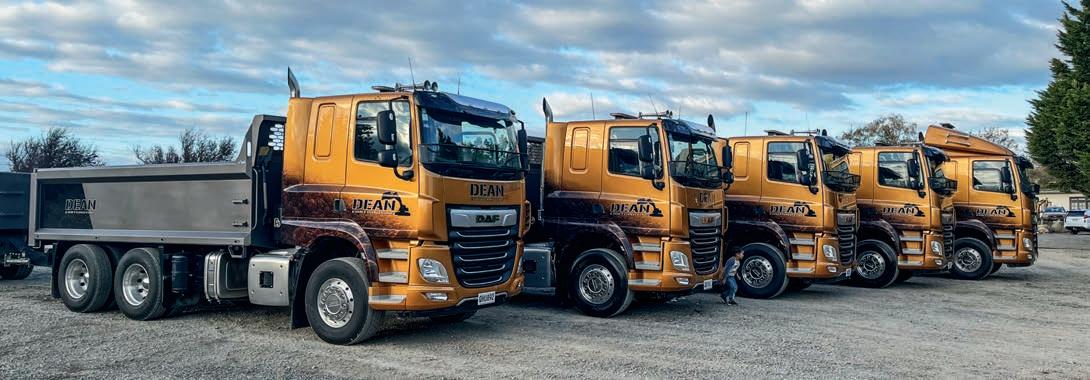
OPERATOR: Dean Earthmoving, Dannevirke
ENGINE: Paccar MX-13 13L Euro-6 390kW (530hp) 2600Nm (1920lb/ft)
TRANSMISSION: ZF TraXon 16TX2620
16-speed AMT
REAR AXLES: Paccar SR1364 with dual diff locks
4 x DAF CF530FAT 6x4 rigids and 1 x CF530 FTT 6x4 tractor
REAR SUSPENSION: Paccar eight-bag air suspension
BRAKES: Disc. ABS, EBS
SAFETY: Full safety suite – ACC, AEB, LKA, DA
BODY/TRAILER: Bodies, trailers and tractor unit fit-out by MJ Custom Engineering, Palmerston North
FEATURES/EXTRAS: Sun visor, stoneguard
PAINT: Ford Ranger Gold applied by MJ Custom Engineering
SIGNAGE: Speedy Signs, Palmerston North
OPERATION: Civil contracting and earthworks throughout the East Coast
SALES: Mark O’Hara
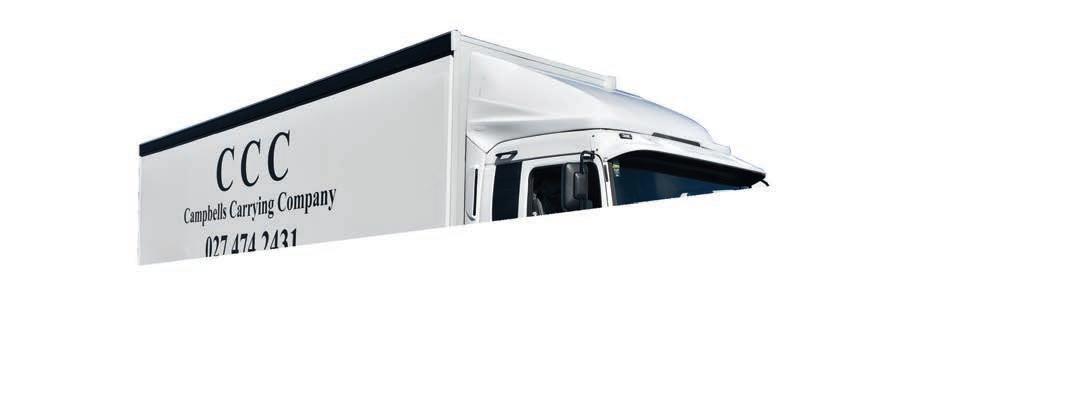
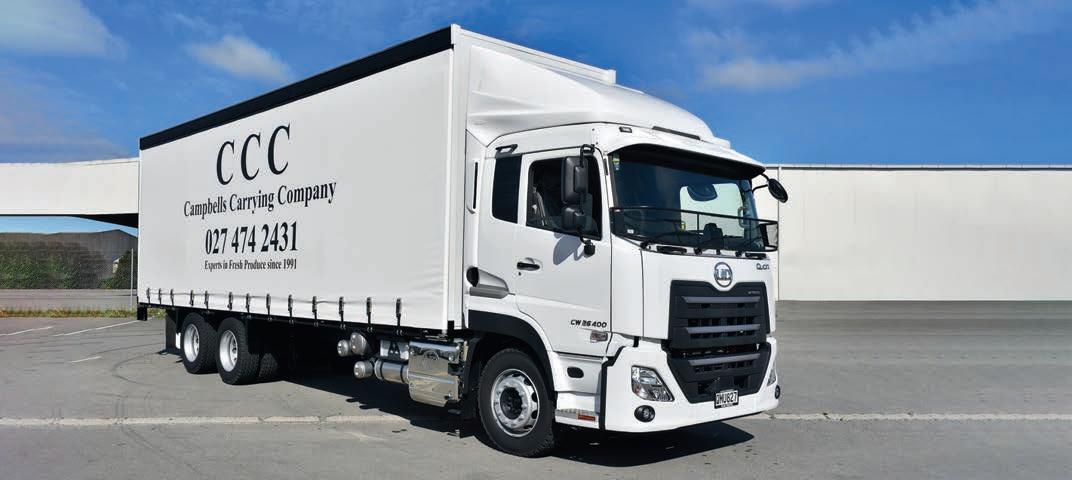
OPERATOR: Campbells Carrying Company, Auckland
ENGINE: UD GH11TB 11L 298kW (400hp) 2000Nm (1475lb/ft)
TRANSMISSION: ESCOT-VI 12-speed AMT
REAR AXLES: UD
REAR SUSPENSION: UD eightbag air suspension
BRAKES: Disc. ABS
BODY/TRAILER: Hale
Manufacturing 8.5m body with
OPERATOR: Akarana Timbers, Auckland
ENGINE: UD GH8 263kW (360hp) 1428Nm (1055lb/ft)
TRANSMISSION: ESCOT-VI 12-speed AMT
REAR AXLES: Single reduction hypoid with cross locks
REAR SUSPENSION: UD eight-bag air suspension
BRAKES: Disc. ABS, EBS
SAFETY: ESC, LDW, LCS, ACC, EBA
BODY/TRAILER: Seaview Custom Engineering
FEATURES/EXTRAS: Palfinger PK22002 crane
OPERATION: Delivering timber and pre-nail products throughout greater Auckland district
SALES: Marvin Fynn
2000kg Zepro tail lift
FEATURES/EXTRAS: Airplex aero kit with side skirts, sun visor, stoneguard
PAINT: Factory
OPERATION: Produce transport throughout Auckland and the Bay of Plenty
DRIVER: Scott Campbell
SALES: Richard Lloyd
PHOTO: Richard Lloyd

AB – Air Bag
ABS – Antilock Braking System
ACC – Adaptive Cruise Control
ABA – Active Brake Assist
AEB – Autonomous/Active Emergency Braking
AEBS – Advanced Emergency Braking System
ALA – Active Lane Assist
ASR – Anti Slip Regulation / Auto
ATC – Automatic Traction Control
BAS – Brake Assistant System
BB – Brake Blending
DAS – Driver Assistant Support DM – Driver Monitoring DS – Driver Support DTC – Drag Torque Control
EBA - Emergency Brake Assist EBS – Electronic Braking System
EBSS – Electronic Braking Safety
– Electronically Stability
– Forward Collision Avoidance
– Forward Collision Warning
– Front Under-run Protection
– Hill Start Assist
Suspension
PCS – Pre Collision System
PD – Pedestrian Detection
RB – Reversing Buzzer
RM – Rocking Mode
RW – Reverse Warning
SAB – Side Air Bag
SC – Speed Control
SD – Side Detection
SGA – Side Guard Assist TEBS – Traffic Eye Braking System TECC – Traffic Eye Cruise Control TPM – Tyre Pressure Monitoring VSC – Vehicle Stability Control







New Zealand has a rich heritage of body and trailer building, and we’re proud to showcase some recent examples of Kiwi craftsmanship every month. To feature on these pages, send a photo, features and the manufacturer’s name to carl@nztrucking.co.nz.
Raymond Transport of Mt Maunganui recently commissioned this wide-track seven-axle skeletal B-train from the team at Patchell Industries to carry out container movements throughout the North Island.

Looking for optimised tare weight and stability, the build has SAF INTRADISC BI9 super single axles, with Wabco EBS throughout. Keeping things coupled together are SAF Holland fifth wheels.

FEATURES: Peterson LED lighting, Knorr-Bremse EBS, Bigfoot CTI, SI Lodec scales, Mills-Tui alloy rims. Mills-Tui, Rotorua
FEATURES: Hella LED lighting, Wabco EBS, SAF INTRADISC axle sets, SAF Holland fifth wheels. Patchell Industries, Rotorua
The arrival of the X-Series Western-Star had Penske enlist the experience of New Zealand logging legends Mills-Tui with its demonstrator build.
Using a Mills-Tui five-axle Multi trailer as the base, the unit features high-tensile chassis and bolsters, and runs on Hendrickson air-suspended axles.
Mills-Tui has added a few advancements, with TuiTensioners, new resilient bolster mounts, a bolt-on bumper on the truck, as well as bolt-on bumper/pusher bar for the trailer.
An array of quality components complete this sharp build, as we have come to expect from the detail-driven Mills-Tui team.
Since 1953

FEATURES: Alcoa Dura-Bright alloy wheels, SAF discbraked air-suspended axle sets. TMC Trailers, Christchurch
Nothing short of stunning springs to mind with the latest build from the Southland workshops of TES for valued client Arnold Transport of Hari Hari on the West Coast. Starting with a new 8x4 IVECO S-Way, TES has crafted a 7.3m tipping drop-sider body for the truck, pairing this with a matching 9.8m five-axle trailer, that runs SAF INTRADISC axle and suspension sets, with liftaxle option also fitted to the unit. Both the truck and the trailer feature curved alloy lift-out sides, with demountable covers completing the build.

This month, saw another new TMC two-axle tipulator trailer go on the road for Road Metals Company of Christchurch.
The new tipulator joins other TMC units already residing within the Road Metals fleet. The proven recipe for longevity includes a hard-wearing Hardox steel bin, and SAF 22.5in disc-brake axles, all riding on SAF air suspension.
Topping off the build, and keeping the load in check, is an all-weather roll-back tarp provided by Power Tarps NZ.
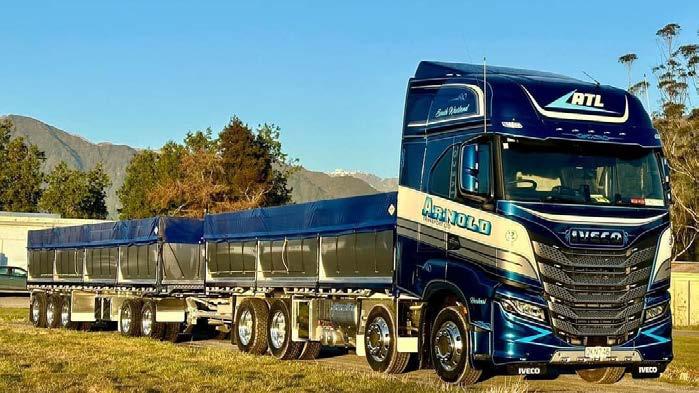
FEATURES: Peterson LED lighting package, Edbro hydraulic rams, double-door tool lockers both sides. Transport Engineering Southland (TES), Invercargill
The premier name in the world of truck and trailer wheels
Delivering the great professional look of a wheel in combination with significant weight saving benefits and the strength of a quality forged aluminium wheel makes ALCOA Wheels stand above the rest.

The first inductee to the Bridgestone Million Mile Club this month is this well-kept 2001 Mack CH Elite belonging to the team at Feary Group of Christchurch. AEQ588, proudly known as Unchained, has the best part of 2,300,000km on the clock now, and is still on frontline civil earthwork duties.
Chatting with permanent driver Teone Robinson, as well as a little research on the
CarJam website, brings us up to speed with the truck’s history. There are conflicting reports, but apparently it was new into the TNL fleet with an ownerdriver based in Nelson. It looks as though it was first built as a rigid bulk tipper, with an alloy bin and matching four-axle trailer. At some stage in its TNL life, the truck was cut down and reassigned to tractor unit duties, pulling all manner of
trailers. From there, it appears at around 650,000km, it was traded in Nelson, and made its way to the Bay of Plenty. A stint with Smithbridge was next, eventually making its way into the HEB Construction fleet. Traded back to Motor Truck Distributors in 2012, AEQ588 found a new home with McWatt Roadhaul of Pōkeno, mostly pulling a bulk pneumatic cement tanker. It was early 2023 when Feary



Group managing director Charles Feary spotted the tractor unit for sale on Trade Me. “We purchased the CH for the right money and had it shipped and delivered to us here in Christchurch. It was in solid condition, needing a bit of TLC, but it was all there.
“Unfortunately we found after about four months, the 470 had an issue where it was leaking water from damage to the head as well as the block. We hunted around and tracked down a fully rebuilt 470 out of an ex-logger from Southland. It only had around 35,000km on it, and it had also been opened out a little to the 510hp mark. So that was purchased and fitted, and we were up and running again,” says Charles.
The CH in the care of McWatt Roadhaul, pulling a pneumatic cement tanker.
Apart from routine maintenance, AEQ588 has proven trouble-free and reliable. “Teone has done a fantastic job of bringing the truck up to scratch for us. He lives and breathes trucks and it shows. He really takes pride in it, and makes sure that it is always looking its best. And it’s funny, it is one of those trucks that acts like a rolling billboard for our business. We have newer trucks in the fleet, and they just don’t get noticed. The CH, however, is one of those trucks that turns people’s heads, and makes them take another look. Yeah, we are very happy with it, and in time as finance allows, we will keep it looking the part,” says Charles.
We certainly agree, the CH is a classic in its own right, and with a little bit of effort, they are definitely sharp-lookers.
Our second inductee this month into the Bridgestone Million Mile Club is this classic 1998 K100G Kenworth 8x4 rigid tipper. Owned and operated by Muir Hamilton of Hamilton Industrial Services, the mighty 100G, according to the records, has a touch over 2,000,000km showing on the clock now.
Looking into the history of the 100G, we find that the first registered owners were Williams & Wilshier of Gisborne, where it was put to work with logging gear and a four-axle trailer. It appears to have completed a touch over 700,000km in that company’s care. It then moved across to Rotorua into the Paragon Haulage fleet, and in late 2004, the 100G moved south to Kaiapoi, finding its place in the SML fleet. In 2011, it was sold, and there was a change of ownership to Hewvan Timber of Palmerston, Otago, where it looks to have resided for a bit over five years. After its time with Hewvan Timber, the 100G moved into the CRB Logistics fleet for a stint there on all manner of general freight duties as a tipping drop-sider. After this, the unit spent time within Barry Caulfield’s fleet based out of Awakeri. And it was here, in about 2020, when Muir took over the reins of the 100G.
“The truck for us was needed to work alongside a business venture we were involved in at the time. We were using highpressure waterblasting in a process that removed the excess bitumen that flushes up through
the aggregate and compromises the surface. There was a truck that was set up with the blasting equipment, and then we sat alongside this with the K100G, and decanted the water from the solids, then bagged the solids for removal to recycling plants in Auckland and Gore,” says Muir.
“The truck has been a solid unit for us. I am not sure of the engine’s history, but the 3406E I have been told is now running 550hp. The rest is all normal spec, 18-speed Roadranger, 46/160 diffs with HAS460 suspension. I have replaced the front diff, and recently replaced the UJs on the rear driveshaft. We have also replaced all the airbags, the front spring packs, as well as all the shackle pins and bushes. So yeah, we have spent a little bit of money on it, but that is repairs and maintenance.
“As I mentioned, it is a solid truck, and it has been looked after, but unfortunately we no
longer have the need for it, so if anyone is looking for a good drop-sider tipper that is ready to get back to work, then drop me a line and we can have a chat,”
was Muir’s parting comment.
If you are in the market for a good ol’ K-model 'K-whoppa', give Muir a call. He has the machine for you.


Bridgestone and New Zealand Trucking Media want to recognise trucks that have achieved this milestone in the act of carrying the nation on their backs. Each month, up to eight trucks will be selected, and will feature in the magazine, as well as on our social media.

of
Our 100 year history proves that when you do everything with heart, nothing is too heavy. Mitsubishi from Centra, moving New Zealand forward.
You can hire a Mitsubishi Forklift on a fixed term hire contract, maintenance included on terms from day to day right up-to 7 years
• New or Used, ex fleet forklifts available
• Huge range to choose from
• Delivery within 24hours

Auckland - 32 Hastie Avenue, Māngere Bridge, Ph: 09 634 8500
Hamilton - 38a Maui Street, Ph: 07 849 5128
Tauranga - 12/45 Kaweroa Drive, Tauriko, Ph: (07) 282 9910
Palmerston North - 25 Bisley Street, Ph: 06 355 9033
Christchurch - 38a Parkhouse Road, Ph: 03 343 6814








Not since the Penrith Working Truck Shows over 20 years ago has anything been held on the scale of the inaugural Sydney TruckFest 2024.
Andrew Geddes
The inaugural Sydney TruckFest took place between 3 and 5 May at the Hawkesberry Showgrounds in Clarendon NSW, a location familiar to those who have attended the popular Clarendon Kenworth Klassic. The brainchild of Brendon Ryan and Bruce Gunter, the creator of the Klassic, the event had the same well-organised, relaxed atmosphere and professional approach Klassic attendees have come to expect.
While Sydney is well entrenched on the truck show circuit with the Klassic, Bruce and Brendon said Sydney had had a drought concerning an all-makes and trade/truck show.
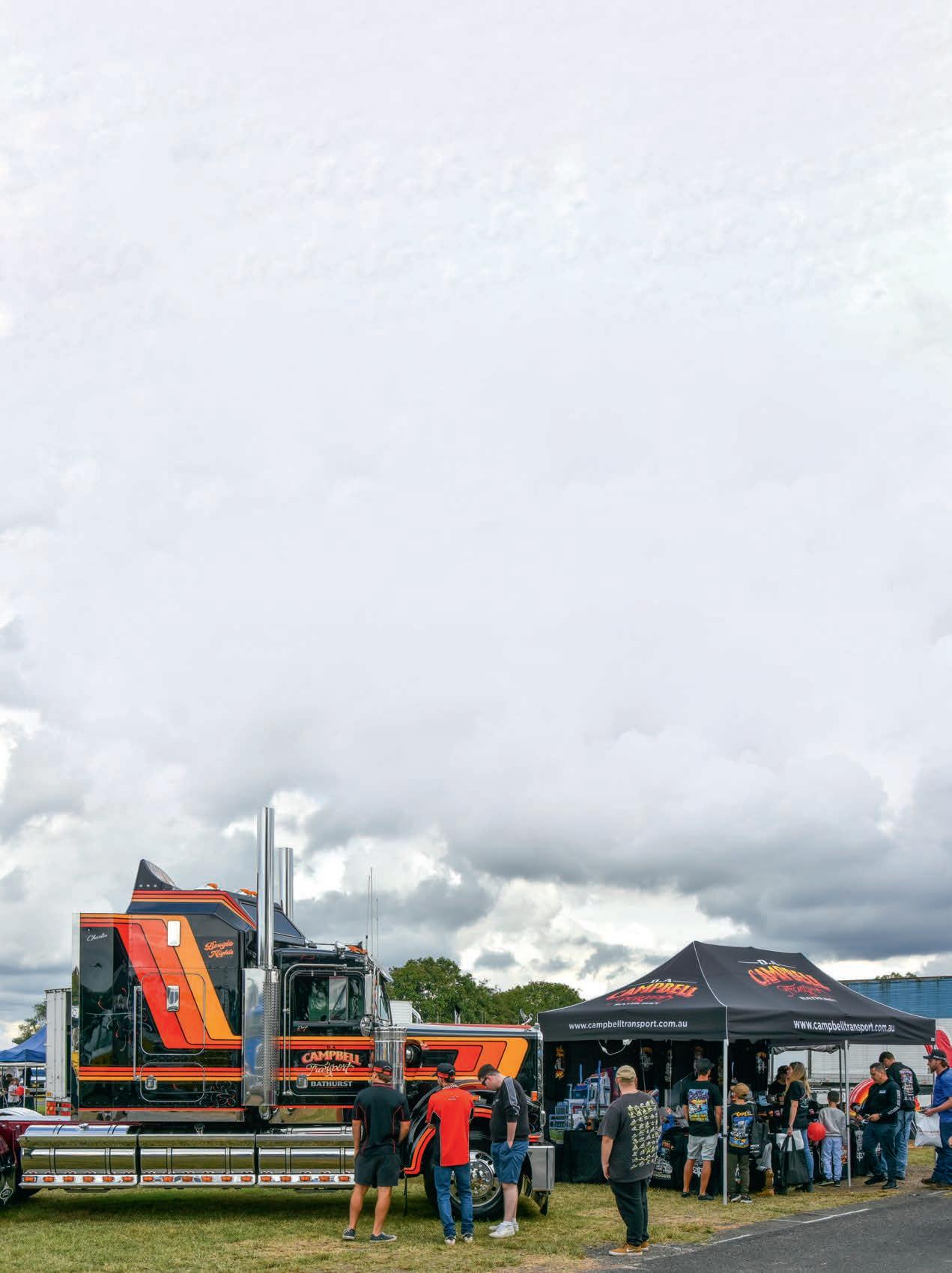
Trade stands and attractions showcasing new vehicles, trailer manufacturers and associated transport services ran in conjunction with truck displays, including a show ‘n’ shine competition, which attracted a high class of entrants.
Classic truck rides were a big hit with showgoers. The shrill sounds of two-stroke Detroits soon drew a long queue to enjoy a 15-minute ride around the area in some true trucking history. Trade stands, including Drake Collectables and Iconic Replicas, drew eager buyers.
A major drawcard of the TruckFest on the classic truck side was the Back to the Woolsheds display.
While the event was created to showcase everything new to the transport industry, the organisers – also being avid historians – chose the Hawkesberry Showgrounds for the Yennora Woolsheds, transforming the venue into a classic-truck time capsule that showcased some of the best examples of Australian classic trucks available.
The weather forecast leading up to the show was patchy, with the show days forecast for heavy rain throughout the wider area, anywhere between 20mm and 40mm of rain to over 100mm daily was possible.
Mid-week, before show organisers decided to run with
the event, and while rain and overcast skies did dominate, the sun also appeared.
The spectators and public didn’t seem perturbed, with more than 4700 attendees, while some 70 trucks battled it out for show ‘n’ shine honours.
Bruce, Brendon and helpers breathed a sigh of relief on Sunday evening, with the success of the event locking the Sydney TruckFest in every second year opposite the Brisbane Transport Expo. Feedback from the public and truckies was a resounding thumbs-up. We’ve already pencilled in the dates for the venue and are aiming for March 2026.
The merchandise stand of DA Campbell Transport from Bathurst is always hugely popular with truckies and the public alike, offering a wide range of clothing and branded goods. Displaying Boogie Nights, its Legend 900, proved a hit!





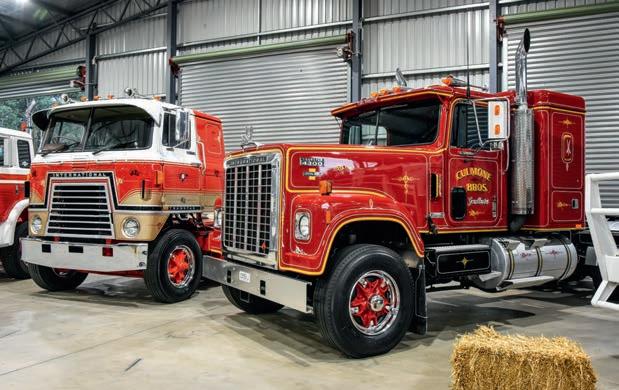
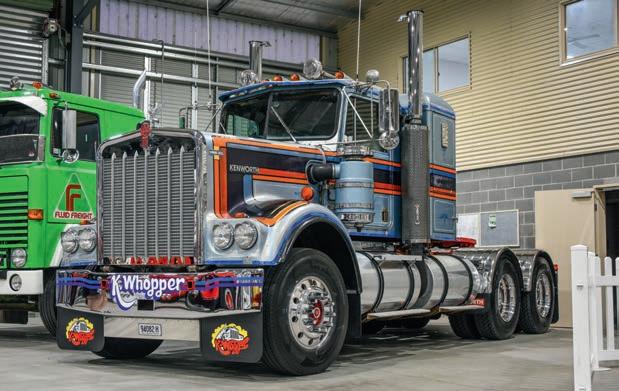


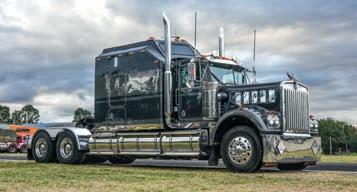













Some interesting developments on display: it’s clear the Australians are starting to trial several axle-spacing combinations (above), and holeless alloy rims (below) .

Less-than-wonderful weather over the three-day event didn’t dampen the public’s enthusiasm.
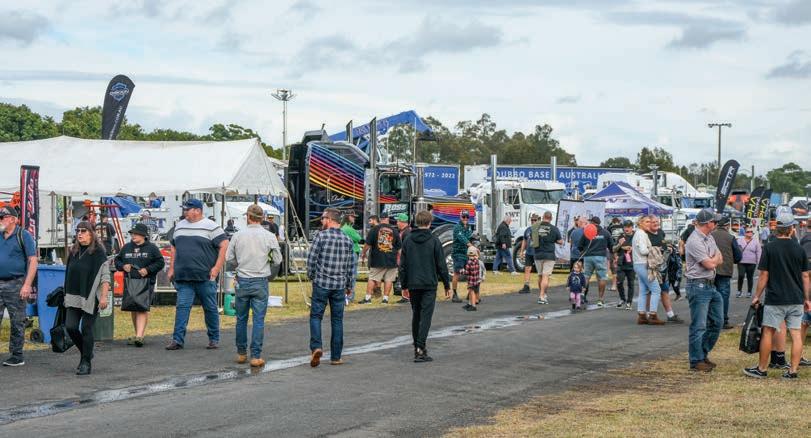


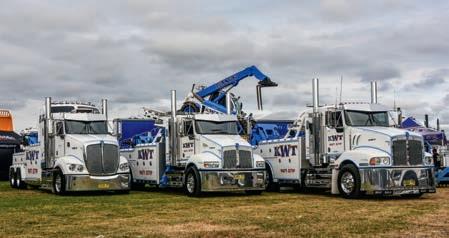







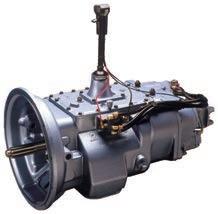


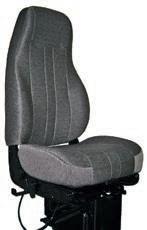




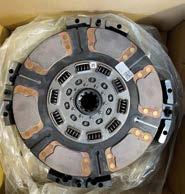












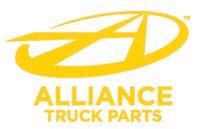

Story by Will Shiers
It is often said that where America leads, Europe follows. And if that’s going to be the case with electric trucks, we can learn some lessons from recent developments in California.
Formed in 1967, the California Air Resources Board (CARB) is an agency in the state government that aims to reduce air pollution. While it does concern itself with CO2 emissions and global warming, its main emphasis is on air quality.
It has recently turned its
attention to trucks, introducing some of the most stringent regulations yet. In 2020, CARB introduced the Advanced Clean Trucks (ACT) regulation, which requires OEMs to sell an increasing percentage of zerotailpipe-emissions trucks as the years progress. Then, in 2023, it switched its attention from supply to demand, announcing details of its Advanced Clean Fleets programme. This was a series of phased regulations culminating in all trucks operating in the state having zero tailpipe emissions by 2045.
The first stage, which was set to be implemented on 31 December 2023, would have seen a ban on new internal combustion-engine heavy trucks being added to the state’s drayage registry. In other words, operators purchasing
new trucks to transport containers and bulk loads to and from California’s seaports, and intermodal railyards would have to invest in zero-tailpipeemissions trucks. The problem with that plan, however, was the limited choice of electric or fuel-cell heavy-duty trucks on sale. What’s more, the vehicles are eye-wateringly expensive, as is the provision of charging. While there are healthy grants available in California for purchasing both the vehicles and chargers, the processes of applying are complicated and time-consuming.
Not surprisingly, the California Trucking Association wasn’t happy with the situation. It filed a federal lawsuit seeking to block the imminent regulations, declaring that CARB had a “make-believe view” of what
could be achieved with the current technology and infrastructure.
The backlash had the desired effect, and in the 11th hour, CARB withdrew the ruling – for now. But the reprieve is only temporary, and some forwardthinking Californian operators are already future-proofing their fleets.
With nearly 5000 tractor units, 14,000 trailers, and 6,500,000m2 of warehousing, NFI is one of North America’s largest thirdparty logistics providers. And, since acquiring California Cartage (Cal Cartage) in 2017, it has also become one of the nation’s biggest drayage providers.
“Our purchase of Cal Cartage first started the discussion

around electric trucks,” explains Brian Webb, NFI’s president of port services. “The incentives California provides to reduce your carbon output, and the services Cal Cartage was providing, meant it was clear that we needed to invest in electric truck technology.”
NFI uses three truck suppliers, Volvo being one of the more prominent. By coincidence, in 2019, the truck-maker was about to embark on the Volvo LIGHTS project, which would see it putting its first battery-powered trucks into real fleets. Under the scheme, NFI took delivery of a pair of VNR Electric tractors.
Jim O’Leary, NFI’s vice president of assets, explains that there were initially one or two teething problems – the 176km range from the fourbattery trucks in particular. “We said, ‘That won’t work’, so they immediately designed a sixbattery truck to meet that need.”
The scheme was a resounding success, giving NFI the confidence to invest further. When we visited earlier this year, it had 40 electric tractors on its Californian drayage fleet, a mix of Volvo VNRs and Freightliner eCascadias. By the end of 2024,
this will have risen to 90, twothirds being Volvos, giving it one of the largest zero-tailpipeemission fleets in the United States.
NFI has gone down three separate funding routes to acquire these trucks. While the incentives reduce the purchase cost, there is still a significant difference between the price of electric- and diesel-powered vehicles.
According to O’Leary, purchasing the trucks was the easy part. “When we first started, I thought, ‘Just give me a truck and we’ll plug it in and go!’ But we soon realised it’s all about the infrastructure. That’s where the rubber meets the road.”
NFI’s electric truck investment coincided with a decision to move its drayage team from Chino to Ontario, several kilometres north. It owns a warehouse in the area, and a 1.6ha site next door was purchased and earmarked for electric truck charging.
“We are installing 38 350kW dispensers with 19 power cabinets, and each one can support two chargers. These are capable of charging two trucks each, so the power will
O’Leary explains that while the financial incentives have certainly helped and made the project viable, there is still a significant gap between the actual cost of operating electric trucks and the incentives provided.
“Our customers are demanding that we do these things, but they aren’t necessarily willing to pay for them. Customers have zeroemission targets, but due to the cost, they are looking at other parts of their supply chain to reduce emissions ahead of transportation. If regulators heard this, perhaps they would apply the brake pedal a little,” he says.
be split,” O’Leary tells us. NFI will have the ability to bring in 7MW of power which, to put it into perspective, is roughly the same amount of electricity that’s needed to power the Empire State Building.
The clever bit: NFI has also installed a pair of batteries, giving it 7.7MWh of storage. This means it can draw from the grid off-peak and avoid the expensive 4pm to 9pm peakload period. It has also installed 1MWh of solar panels on the building’s roof next door.
O’Leary explains that the whole process was fraught with obstacles, and while it was initially supposed to have been completed by the end of 2022, it won’t be fully up and running until this August.
While this represents a significant six-figure investment, NFI’s cost has largely been limited to buying the trucks, the land, and preparing the facilities. The chargers, batteries and solar panels have been the subject of multiple external funding programmes. The entire project, including the real estate acquisition, has cost in the region of US$45 million ($72.5 million).
“Customers have been willing to try it, but without any additional fees,” adds Jessica Cordero, NFI’s VP of drayage operations. But she says this is starting to change, thanks to South Coast Warehouse Actions and Investments to Reduce Emissions scheme. This complicated legislation financially penalises companies for the number of diesel truck visits to their warehouses.
“Now customers are realising that if they pay a little over here, they won’t pay as much over there,” she tells us.
The whole project has certainly represented a steep learning curve for the entire NFI management team. “You have to hold the hand of the project all the way, whether you’re deploying two trucks or 50 trucks,” says O’Leary.
“Lawyers, real estate, financing, fleet, operations … Everybody needs to be all-in. It’s not for the faint of heart!”
That said, all involved are convinced that it’s been worth the effort and are confident of reaping the rewards in the future.
“Having had conversations with customers, we are in an absolutely great position to continue to grow our business,” says Webb.
“The work the team has

done at the ground level is paying dividends for us. We have absolutely made the right choice.”
Located next to Los Angeles’ LAX Airport, Griley Air Freight is a fourth-generation, family-run trucking company specialising in air freight, working for some of the big worldwide freightforwarding companies.
Assignments are collected from and delivered to LAX. Most product is stored in its secure 2973m2 warehouse, before distribution to customers in the Los Angeles region. Other loads are shipped directly to customers’ warehouses.
Although airports aren’t considered drayage, CEO Katie Griley knows that it’s only a matter of time before regulations relating to the use of electric trucks at LAX will be introduced. With this in mind, two years ago, she decided to get some valuable experience with the vehicles and added a Volvo VNR Electric to the company’s 90-strong, mainly Freightliner fleet. The truck has been leased from Zeem Solutions, which also takes care of the charging.
“We run a lot of Freightliners, but the eCascadia didn’t come out until after we had acquired the Volvo. Anyway, we are very happy with Volvo,” explains Katie.
So happy, in fact, that

last year, the company took delivery of another VNR Electric. Unlike the first truck, which only had four batteries and a 240km range, this one had two additional batteries on the external cab wall, increasing the range considerably.
While this second truck was purchased outright, Griley Air Freight still chose to partner with Zeem Solutions for charging. “They offer parking and charging at their location just down the street,” Katie tells us.
“It’s been seamless. The drivers drop them off, and go home in their personal cars, which have been left there during the day. Zeem then charges the trucks overnight and takes care of everything.”
While one is leased and the other purchased outright, both trucks have been part-funded by grants. Katy describes the process of applying for funding as “tough”, but believes it needs to be that way to ensure that the money goes to deserving companies.
“If those grants weren’t in place, this would never have happened,” admits dad Tom Griley, who is shocked to learn how small some European grants are in comparison.
The trucks are coupled to tandem-axle semi-trailers and do between two and four runs to the airport per day. Loaded to 18 tonnes the older truck does about 160km per day, whereas
the six-battery VNR Electric can manage 320km or more at full payload, allowing it to be double-shifted.
“We intentionally chose drivers that might be more receptive to them,” explains Katie. “For instance, one of them drives a Tesla.”
Drivers Sam Mauro and Mario Benavides admit to having had some reservations to start with. “I didn’t know if it would have the power,” admits Sam, “but it does, and I love it. I wouldn’t go back to diesel now, as they’re too shaky. When I have a full load on it feels good – nice and smooth.”
These are sentiments echoed by Mario, who reckons some of the other drivers are jealous. “On the hill to Ontario, I was loaded with 19 pallets, and thought I’d be stuck in the inside lane with my flashers on. But instead, I was passing diesels.”
The electric trucks have been well received by the public, and the company has received letters of support. Katie explains that as part of the infrastructure grant subsidy requirements, Griley Air Freight was required to seek support from the local community.
The trucks have received full support from customers, too. Consequently, Griley Air Freight has been able to pass on the increased costs associated with running electric trucks by charging customers a higher freight rate.
“Of course, we might not be lucky enough to be able to do that in the future,” admits Katie, referring to a time when rivals also operate electric trucks. “But for now, we have something to offer that our competitors don’t, and we have even gained two new clients as a result.”
When we visited Griley Air Freight earlier this year, news had just reached the team that Korean Airlines is to start giving loading/unloading priority to zero-tailpipe-emission trucks. With waits of two to four hours commonplace at LAX, this was welcome news indeed. “This is something we weren’t expecting, and it could save us US$100 (about $160) per trip to the airport,” reckons Tom. “And if more airlines follow suit, then this will be a big cost-saving for us,” adds Katie.
Griley Air Freight will ramp up its electric fleet in the coming years in line with the legislation. According to the ACT rule, 10% of its fleet will need to be electric by 2027. With this in mind, a third battery-powered truck will be added to the fleet later this year, with more to follow.
“We have had to learn a lot very quickly, but we are eager to be a part of the sustainability movement,” concludes Katie. “And we plan to keep on trucking.”



VARTA ProMotive AGM is designed to optimally support drivers and their trucks during their time on the road. Since the demand for nonstop transportation services requires trucks to be on the road every day, drivers spend more time in the cabin than ever before. The Varta A1 AGM truck battery leads with high vibration resistance, excellent charge acceptance, extended cycle life and increased depth of charge, allowing fleets to equip drivers’ cabins with hoteling functions without draining the battery, avoid downtime and maximise productivity.

It all starts with
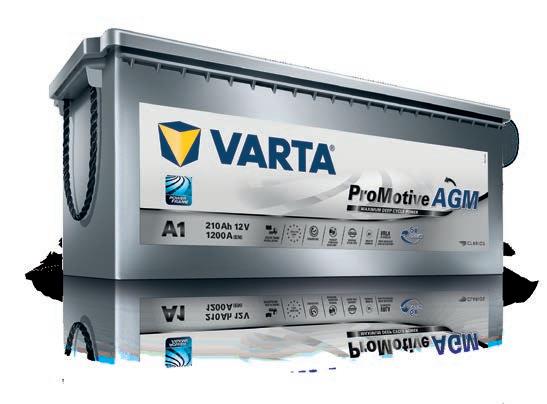



Visit our portal to find your local supplier. www.varta-automotive.com/en-nz



By Carl Kirkbeck

With the freshly assembled and stretched chassis, it is time to get some suspension and diffs in place at the rear, and implement a right-hand drive conversion at the front.
The chassis for Torquing Bulldog is well set, and now ready for the fitting of the rear end suspension and differentials. However before we rush in, there are a few steps to take to ensure that all six wheels end up sitting on the ground. First things first, jump back to steps 6 and 7 and complete the construction of the wheels. As
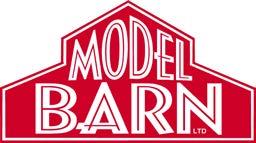

you assemble the wheels, apply paint as you go, before the tyres are fitted to the rims; this will ensure a clean crisp finish.
Now move on to step 8, and fit the trunnion towers and trunnion (parts 46 to 51). Take care to get this as straight, square and as solid as possible; this is a critical step. Jumping to steps 12 and 13, we now assemble the two differentials in readiness for installation. Next is step 14 where we assemble the spring packs (parts 81 to 84).
Once the glue is dry, slide the spring packs on to the trunnion as shown, but do not glue in place yet. We first want to glue the two differentials to the spring packs, again keeping an eye on alignment and accuracy.
Once the glue is well set holding the diffs to the spring packs, we now want to gently set the wheels on the respective
stub axles, on both the diffs and the front axle. We are only sitting the wheels gently on the stub axles; do not send them 100% home yet, this is just a gentle test fit.
With the wheels just sitting on the stub axles, we can now gently rotate the spring packs on the trunnion slightly to ensure that all six wheels are resting on the ground. Once you are happy with the position of the spring packs and have all six wheels on the ground, go ahead and apply glue to the points where the spring packs attach to the trunnion. Leave the chassis in this state of assembly until the glue has fully set before moving; this will ensure nothing is accidentally bumped and moved. Once fully dry, take the wheels off again and proceed with the fitting of the shock absorbers (parts 85 and 86) as
well the torsion bars (parts 88 and 89).
The conversion from lefthand drive to right-hand drive is extremely straightforward. Looking at steps 9 and 10, we utilise parts 56, 57, 60 and 61. Start by first drilling a 1.5mm hole through the right-hand side of the chassis, location as already provided on the left side, simply transfer. This allows us to place part 57 through the chassis in readiness for parts 56 and 61. Part 60 now needs to be rotated over on itself 180 degrees; this will convert it from its left side orientation and allow it to fit the right side.
With these tasks out of the way, we can now test fit the engine (do not glue in place yet), and continue and complete the installation of the chassis accessories, as well as the likes of air tanks and fittings.





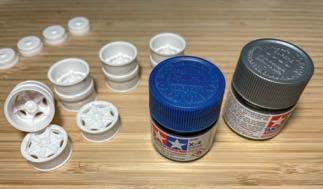




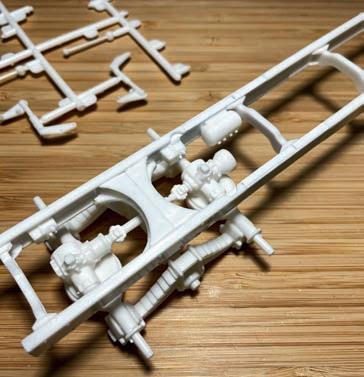
1-3) Assemble the wheels first in readiness for a gentle test fit once the rear diffs and suspension are in place. 4-5) Fully assemble the diffs ready to glue in place once the spring packs are resting on the trunnion. 6) When fitting the trunnion and trunnion towers, take your time to ensure solid and accurate placement. 7) With the spring packs resting on the trunnion ‘NOT GLUED’, fit the two diffs to the spring packs and glue them in place. By not gluing the spring packs to the trunnion at this stage, will allow us to rotate them slightly and ensure that all six wheels sit firmly on the ground first. 8) Once you have test fitted the wheels and adjusted the spring packs on the trunnion, and made sure that all six wheels are sitting on the ground, you can move forward and apply glue to the trunnion, this locking the spring packs in place.
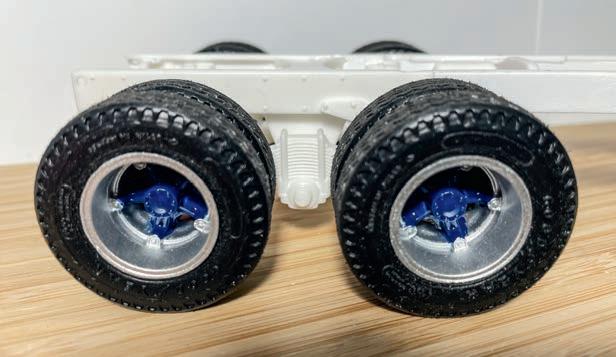



Looking at a reference photo, we can see the location of the steering box is a mirror image in a RHD setup of how it is placed in the LHD variants.
Hi, Little Truckers. It’s school holiday time again and a great opportunity to get out and about trucking and send in your photos to show us what you have been up to. Below is a couple of mine. I took the kids to Staglands Wildlife Reserve and here I am feeding the highlander cattle; the other is a bird I found and saved. I nursed it until it was strong enough to
fly away. Send in your pics and we’ll feature them right here on the pages of Little Truckers’ Club! Unfortunately, we had no correct entries for the logo-find competition for the second month in a row. Remember, there’s a little prize up for grabs each month – so flick through this issue with a sharp eye and find the Little Truckers’ Club logo
How many truck names do you know? We thought of 30! Fill in the grid using the code below to see what they are. BUT, some letters are missing from the code, so you will need to figure out what they are first. Once you have cracked the code, send in your answers to rochelle@ nztrucking.co.nz and you may win a cool prize.
hidden somewhere in its pages. Don’t forget, if you would like to see yourself here in Little Truckers’ Club, all you need to do is email your stories, jokes, photos, and/or drawings to me at rochelle@nztrucking.co.nz with a short paragraph telling us about them along with your name and age. We love seeing them all.
The Little Truckers’ Club logo is hidden somewhere in this issue. Find it, and you may win a prize. Email rochelle@nztrucking.co.nz with your name, age and where you found the logo.
S W 18A6 25 C 169DFO5D 25 25 T 254 S 25EC 4 KE68O5T22 E5F K 13 131319 E S N 25 4 5E6252319T T S O 6 D 25 12265 61813TS231613S2213 A 19 F5E13G22T19136E5 134ECO 23 S 25 513G16Y 23 5 D D Z 22 F121E6 S F23S12 W 5 C T 13 W 252525 O 24E11E516I19T 1D2Z3K4 5 6 7C8W9E10 11T12O 13 14F15 16 17 18 19 20 21 22 23 24 25 26S

We enjoyed seeing all your creative entries so much, we decided to have another colouring comp. Go grab your felts and pencils and colour in the Mack opposite… Once completed, scan your work or take a photo and send it to me at rochelle@nztrucking. co.nz. Entries must be in by 10 August and winners will be announced in September. I look forward to seeing them all. HAVE FUN!


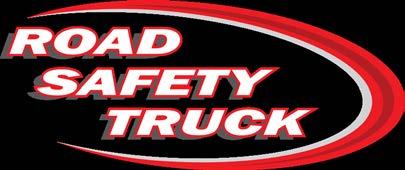














Thank you to the Australian National Heavy Vehicle Regulator (NHVR) for sharing their fantastic resources with us to use as part of our Educational Engagement Programmes run from the Road Safety Truck. The ‘Dont Muck With a Truck’ campaign was created to improve young drivers’ awareness and education of how to drive safely around trucks. Dont Muck With a Truck is funded by the NHVR’s Heavy Vehicle Safety Initiative supported by the Australian Federal Government. Check out some of the resources and videos at www.nztruckingassn.co.nz/dont-muck-witha-truck, classroom packs will be available soon!
















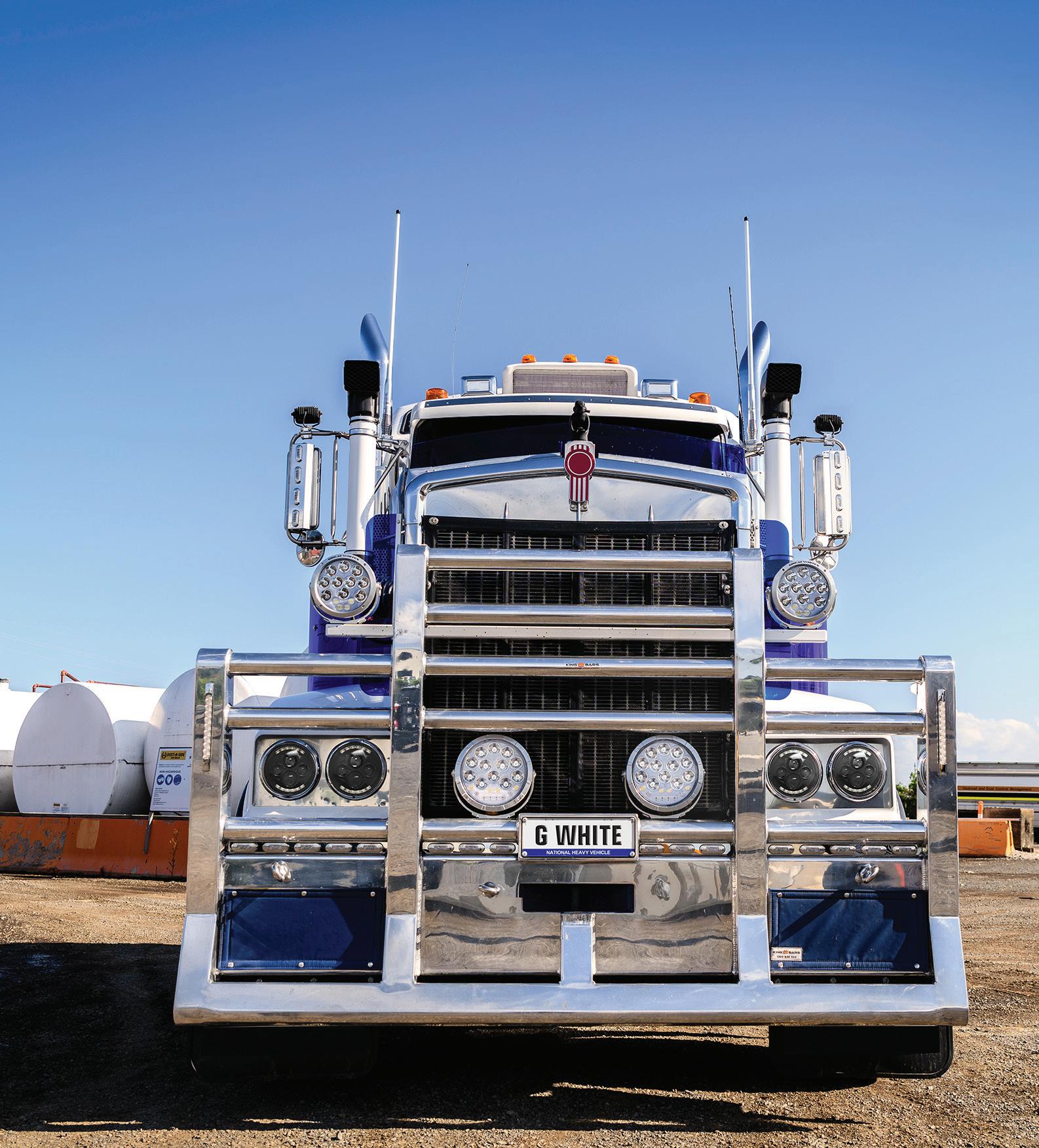



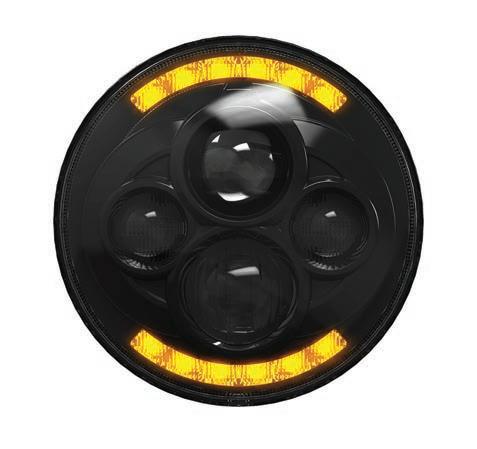


Show organisers
Please send your event details, at least eight weeks in advance, to: editor@nztrucking.co.nz for a free listing on this page.
Southland Hug a Rig
10 August 2024
Southern Field Days site, Waimumu
Contact: hugarigsouthland@gmail.com, Facebook – Hugarig
Special Rigs for Special Kids
25 August 2024
Edgar Centre, Portsmouth Drive, Dunedin
Contact: specialrigs.org.nz, Facebook – Special Rigs for Special Kids
All scheduled events may be subject to change, depending on weather conditions, etc. Please check websites for updates before setting out.
Alexandra Blossom Festival 42nd Annual Truck Parade
28 September 2024
Centennial Avenue, Alexandra
Contact: info@blossom.nz, blossom.co.nz/events/boothslogistics-parade-trucks
2024 South Island Long Lap
14-26 October 2024
Redwood Hotel, Christchurch
Contact: Donna Hardie, 0274518585 siclassictrucks@gmail.com



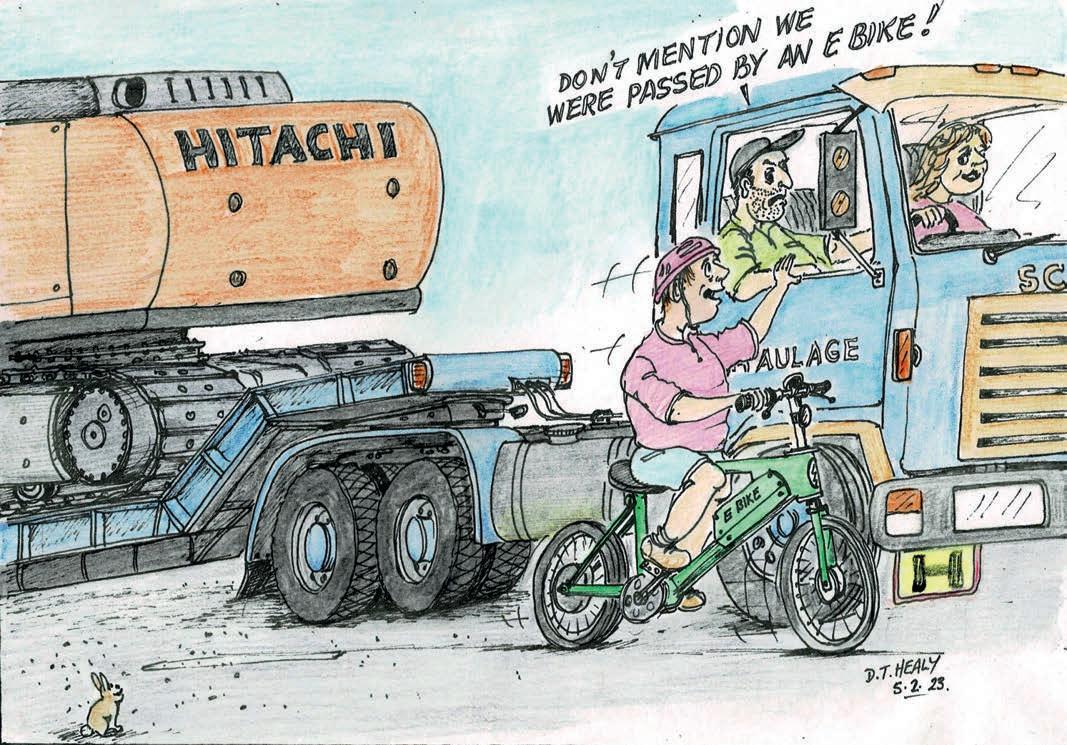

620hp 18 speed manual
Available Now
Complete with 2016 12.1 metre Fruehauf 5 axle curtainsider –38 pallet unit BPW axles, disc brakes, 19.5 DuraBright alloys right throughout. 50 tonne rated and 23 metre permitted, 930,000kms.


Our digital fleet management solutions are designed to ease the administrative burden on your team, while improving your driver’s workflow. From digital documents right through to electronic forms, TN360’s suite of apps can help you and your business transform the way it works.







New Zealand Trucking reveals how the economy is travelling via key metrics from the road transport industry.
This information is compiled by Russell Walsh from information provided by the NZ Transport Agency statistical analysis team and through the Open Data Portal.
The data used in this information reflects any amendments to the data previously reported.
This summary includes data from two heavy-truck classes and one heavy-trailer class.
A goods vehicle is a motor vehicle that:
(a) is constructed primarily for the carriage of goods; and (b) either:
(i) has at least four wheels; or (ii) has three wheels and a gross vehicle mass exceeding one tonne.
Note: Vehicle classes are not the same as RUC vehicle types or driver licence classes.

Vehicle class Description
NB
(medium- goods vehicle)
NC (heavy-goods vehicle)
TD (heavy trailer)
A goods vehicle that has a gross vehicle mass exceeding 3.5 tonnes but not exceeding 12 tonnes.
A goods vehicle that has a gross vehicle mass exceeding 12 tonnes.
A trailer that has a gross vehicle mass exceeding 10 tonnes.

First registration of NB, NC and TD class vehicles year on year, to date
A table of all vehicle classes is in Table A of the Land Transport Rule Vehicle Dimensions and Mass 2016 Rule 41001/2016 https://www.nzta.govt.nz/assets/ resources/rules/docs/vehicledimensions-and-mass-2016-asat-1-October-2019.pdf
First registration of TD class heavy trailers for May, year on year by major manufacturer
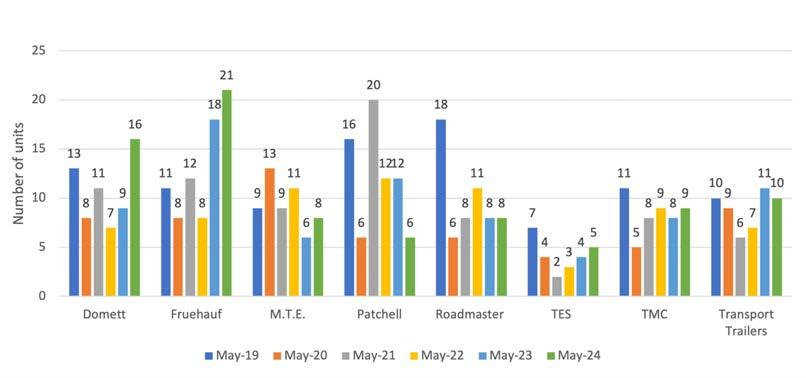
First registration of NB and NC class vehicles for May, by major manufacturer
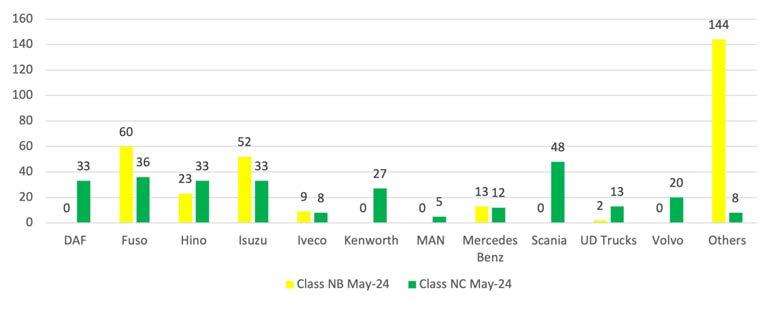
First registration of NB, NC and TD class vehicles for May, year on year

First registration of NC class vehicles year to date 2019 –2024, by major manufacturer

First registration of TD class heavy trailers year to date 2019 –2024, by major manufacturer

Due to a change in process, the presentation of RUC data will now lag by two months. It is put together from information provided by the NZ Transport Agency via an Official Information Request.
New Zealand Trucking magazine acknowledges the assistance of the media team at NZTA for providing this information to us.

Total value and distance of road user charges purchased per year and year to date
Summary of RUC transactions for April 2024
Number of individual RUC licences issued for month 335,861
Total kilometre RUC distance purchased (All types) 1,524,347,596
Total value of all RUC purchases (All types) $200,993,321
1 Jan 2019 – 31 Dec 201916,166,434,103 $2,041,939,272
1 Jan 2020 – 31 Dec 202015,421,400,378 $2,069,615,049
1 Jan 2021 – 31 Dec 202116,204,803,262 $2,249,341,814 1 Jan 2022 – 31 Dec 202217,683,361,155 $1,710,831,998 1 Jan 2023 – 31 Dec 202316,687,053,002 $1,655,078,736
$721,480,046
1
1 Jan 2022 – 31 Dec 2022 13,375,038,937 1,114,586,578
1 Jan 2023 – 31 Dec 2023 12,029,164,087
1 Jan
two axles (except type 2 or type 299 vehicles. Type 299 are mobile cranes). Cars, vans and light trucks that use fuel not taxed at source (i.e. diesel fuel) are generally in this RUC type. A description of RUC vehicle types is available at https://www.nzta.govt.nz/vehicles/licensing-rego/road-user-charges/ruc-rates-and-transaction-fees/
RUC type Description
2Powered vehicles with one single-tyred spaced axle and one twin-tyred spaced axle
6Powered vehicles with three axles, (except type 308, 309, 311, 399 or 413 vehicles)
43Unpowered vehicles with four axles
14Powered vehicles with four axles (except type 408, 414 or type 499 vehicles)
33Unpowered vehicles with three twin-tyred, or single largetyred, close axles (except vehicle type 939)
408Towing vehicles with four axles that are part of a combination vehicle with a total of at least 8 axles
951Unpowered vehicles with five or more axles
H94Towing vehicle that is part of an overweight combination vehicle consisting of a type 14 RUC vehicle towing a type 951 RUC vehicle with a permit weight of not more than 50,000kg.
H95Towing vehicle that is part of an overweight combination vehicle consisting of a type 14 RUC vehicle towing a type 951 RUC vehicle with a permit weight of 50,001kg - 54,000kg
RUC distance purchased year-to-date April for selected RUC types

RUC purchases (All RUC types)


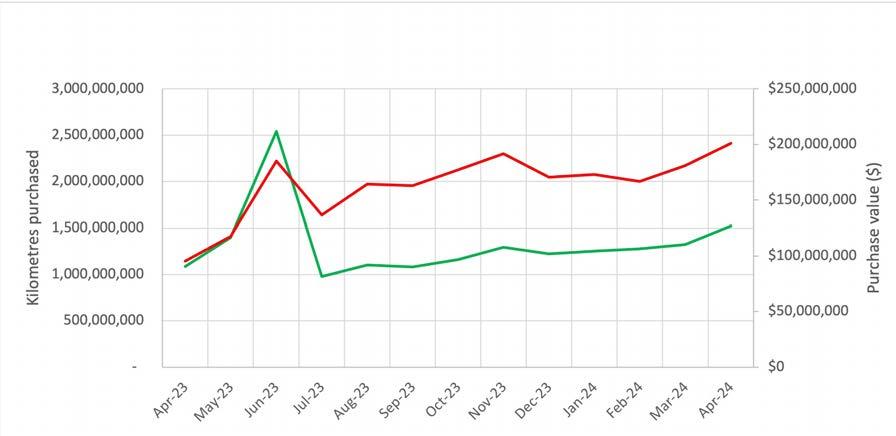
Average monthly RUC purchases by year (All RUC types)

RUC purchases during April for selected types



Total number RUC licences issued for month (All RUC types)

The Wood Transport and Logistics 2024 conference took place over two days in May at the Distinction Hotel in Rotorua with key industry stakeholders discussing the transition of heavy vehicle fleets towards a low-emissions economy.
Collaboration across the industry was a key theme in the opening sessions of the conference.
Dom Kalasih, interim chief executive officer at Transporting New Zealand, said cross-sector collaboration was the solution to the challenges posed by new technology entering the industry.
“New technology does present a lot of risk for the transport sector,” Kalasih said.
“Where will all this new tech go? There is investment risk, increased upfront capital, uncertainty over powertrain choice, and uncertainty on overpower source supply.
“On top of that, there are the legislative barriers that are stopping this new tech coming in, including driver licensing, vehicle axle limits, vehicle definitions.
“There are other countries beginning to make concessions, such as the UK. Other countries are quickly making legislative changes and we need to be doing the same,” Kalasih said.
“Transporting New Zealand tries to share information as best we can. But to see a reduction from an entire fleet is going to take time.
“We are strongly advocating for RoNS and RoRS and support other ways revenues can be generated to get decent roads built.
“I believe the only way these problems can be
fixed is increased acrosssector collaboration, shared responsibility and risk from everyone across the supply chain. Transport operators are trying, but without the support of everyone across the supply chain, it just won’t work.
“The logging sector is in pretty good shape. It works well as a sector. Livestock, for example, doesn’t have this level of collaboration. As long as the whole industry agrees to share this problem, you’ll make good progress.”
Romesh Rodrigo, head of vehicle homologation, regulatory affairs and future mobility at Daimler Truck Australia Pacific, said the future of commercial transport required a wellfounded national strategy to ensure continuity.
“We are not reluctant to embrace this technology, but a holistic approach to zeroemission vehicle transition is key,” he said.
“We are an essential industry. Covid proved that. Discussions with regulators and manufacturers and infrastructure providers is key. That is going to dictate the rollout of how things will move ahead for this transition of the industry.”
Rodrigo said industry collaboration would build outcomes.
“We are collaborating with our biggest competitors to deliver
these products, including a highperformance charging network in Europe with Traton and Volvo, and pairing up with Volvo to develop fuel cells, and our joint venture with Paccar around battery supply.”
Rodrigo said the sequence of investment across the industry was vital for a successful transition
“At the end of the day, we are an incomplete product. Information to support the rollout is key for the industry. Strategic investment now in people and infrastructure is
critical to support a seamless ZEV transition,” he said.
“For the first time in this industry, we can create our own power for our vehicles. If we can get the costs down, that will have a real impact on operating costs. We need a policy framework to come together so we can support the transition and meet climate targets.
“OEMs will continue to develop products. We do not want to be left behind because our infrastructure cannot keep up with the progression of these developments.”


Warwick Wilshier, chairperson for the Log Transport Safety Council, gave an update on industry-led initiatives for log transport operators, trailer manufacturers and forest companies.
The LTSC was established in 1996 to coordinate different sector group views and address issues in a structured and unified manner. Its main areas of industry development include education, vehicle dimensions, logistics and operations. To date, the group has a membership base of nearly 450 operators.
A big focus for the LTSC has been sound driver wellbeing, with Sleep Apnoea, Get Real Behind the Wheel and #BELTUP examples of initiatives the council has put its weight behind.
Following an unfortunate incident several years ago when a log truck driver ended up in a school playground, the LTSC looked into how it could help drivers with sleeping challenges. LTSC now provides members subsidised access to sleep apnoea testing and ongoing help from sleep experts if required.
“It’s been life-changing. Drivers are staunch, you know. They think that they
“we are all staunch truck drivers, so this campaign helped us break that barrier and we are getting some great results.”
don’t have problems with sleep. You’d be amazed at how many people go on these sleep apnoea machines and it’s lifechanging for them,” said Wilshier.
“The inspiring thing for me is seeing an old guy stand up in the room and say, ‘I’ve been on one of those for 20 years,’ and, all of a sudden, they feel that it’s okay to speak out and talk about it. So, we are continually working on that, and it’s really rewarding.”
The Get Real Behind the Wheel campaign was run to encourage drivers to speak up and normalise talking about personal issues. LTSC developed a toolbox of videos around sleep, nutrition and exercise.
“Mental health is a real issue. We’ve been through a lot of stress the last four years with Covid and all sorts of other things, and again, we need to look after our people,” said Wilshier.
“The Get Real Behind the Wheel campaign is a collaboration right across the industry and we got behind it.
“We ran these in-cab confessionals and learned about the truck driver’s life, got them to speak out. We produced a

whole series of videos, and it was a lot of fun. But it was about getting people to speak out – if you speak out and share a problem, it tends to go away.
“Again, we are all staunch truck drivers, so this campaign helped us break that barrier and we are getting some great results.”
The #BELTUP campaign was a big promotional push for drivers to wear their seatbelts, using seat belt covers, rego holders and stickers.
“We all think we’re pretty good, that we have a good level of compliance. We agreed to run a trial, and using an AutoSense camera already in a truck, we were able to see if the driver had his seatbelt on whenever something triggered the camera,” Wilshier said.
“We found that across the board, we had probably about an average of 30% noncompliance. We were able to use one piece of technology that we generally used for other things, like managing driver fatigue, to give us the ability to monitor and actually fix another problem.”



Campbell Gilmour, general manager, Pacific Haulage, discussed the lessons learned in running a fleet of 10 8x6 Scania trucks to assist in harvest planning, roading and log transport in challenging environments – directly to port.
The Gisborne region has a strong export-oriented forestry industry, which contributes significantly to employment and infrastructure in the area. A key economic asset for the region is the port – one of the three largest log-exporting ports in New Zealand. About 2.5 million tonnes a year are currently being exported through the port.
Pacific Haulage typically moves about 72,000 tonnes of logs a month with its Kenworth-dominated fleet, mostly for export.
The East Coast saw a large planting boom in the 1990s. Plantations were on steep, highly erodible areas. Harvest commenced from 2016 onwards.
“There was little roading infrastructure, and roading operations became year-round,” said Gilmour.
“The East Coast consists of a steep forest road network, with high-cost earthworks through steep and erodible terrain. There was limited supply of quality aggregate, and high metal haulage and supply rates. Lower quality aggregate was used for forest roading networks,” he said.
In 2019, Pacific Haulage looked at cartage alternatives.
“We looked at what we could do to assist customers while also assisting ourselves,” Gilmour said.
“The Scania 8x6s enabled us to have a specialised unit, but still operate within the fleet undertaking
cartage duties as normal. The idea was promoted to customers via site visits. Scania engineers visited regions to conduct field testing to confirm the correct specifications prior to ordering, and customers were involved in the planning of the project.”
The first truck entered the fleet in 2022. The 8x6 front steer axle can be engaged as a drive axle. Gilmour said the truck was on the verge of an off-highway truck with on-highway characters.
The tasks for the 8x6s included being used on green roads and some steeper roads that were limited to small volumes. They would be used for the initial load from some sites to gauge cartage limitations moving forward.
“If the site presents challenges, we would put this truck there,” Gilmour said.
According to Gilmore, the benefits of the Scania 8x6s included:
• reduced start-up roading costs
• lessened the need for continuous maintenance and metaling
• roading maintenance costs are limited when harvest is near completion
• roads built to suit 8x6s in some cases
• improved machine productivity time –less time assisting trucks; and
• steady trucking, which allows for better distribution flows.
In summary, Gilmore said that while he wouldn’t convert the entire fleet, a percentage was a good fit for Pacific Haulage.
“They’re a good tool to help with a difficult operating environment,” he said. “They enable forest companies to plan ahead for difficult blocks.”


Gareth Wishart, GM technology and innovation at HW Richardson Group, said a dual-fuel approach would allow the entire heavy transport industry to transition to hydrogen as an alternative fuel in a way that is accessible, fair and equitable.
Last year, HW Richardson Group launched Australasia’s first dual-fuel truck, powered by hydrogen gas and diesel. Wishart said the trial had shown a statistical significance with fuel usage, and the team was very pleased with how well the technology has performed.
The company’s 1400 trucks emitted a lot of emissions and the dual-fuel trucks were a step in reducing that.
When in dual-fuel mode, about 40% of the truck’s energy is generated by hydrogen gas in five tanks behind the cab, and 60% from diesel. It can also run on diesel only.
The company’s total programme costs were $15 million to put the initial 10 dual-fuel trucks on the road and install a hydrogen fuel station.
From on-road trials with dual fuel, Wishart said 1kg of hydrogen replaced 3.32L of diesel. When loaded, the new hydrogen-diesel trucks covered 678km with dual-fuel driving.


“We have five further conversions currently in process. We are looking at putting a smaller tank pack together, and over the next month, we will put that on a Mack with a 9.7L Cummins,” Wishart said.
“We’ve got the commitment from our group to move ahead with these conversions, so you will see a significant number of these trucks coming onto the road,” he said.
Wishart said the trucks could be ready to go before fuel stations are ready.
“They can still do their jobs; they are not impacted at all, and then when the fuel is there, we’ll use it. We are so confident in this that we have started a new business to convert these trucks for industry, so we are not just going ahead and doing it for ourselves, we can do this for others.”
New Zealand’s first hydrogen-powered truck
Grant Doull, national manager hydrogen and eco commercial vehicles, Hyundai Motors New Zealand, gave an update on Hyundai’s zero emissions fuel-cell XcientTruck since starting its onroad trials with NZ Post.
New Zealand was just the second country

“I
noticed no decrease
in the performance. There were no
negatives when I compared it with the Volvo. In 12 months and 85,000km later, it’s not spent one minute in the workshop. We are really impressed with it.”
in the world to adopt this technology commercially, he said. Since it was launched in July last year, it has completed an initial evaluation period before moving into full commercial operations with parcel freight between Auckland and Hamilton to assess its performance on New Zealand roads and conditions.
Doull said Hyundai was thrilled with the truck’s performance in open road and urban routes and hopes it will pave the way for uptake of this new technology in the sector.
“We’ve got this wonderful network emerging in New Zealand. There’s a number of scenarios where we want to deploy electric vehicles, and we’ve now got some projects where we are working on hydrogen power generation for recharging electric vehicles.”
He said a hydrogen roadmap was overdue and was needed for a solid future direction.
“I think we’re getting quite close to the stage now where we’ve got fast followers who can start to jump on board shortly, and the national network will start to expand.”
Neil Dennett, contracted to NZ Post, and the driver for the trial, talked about how the truck won him over.
“I’ve been in the transport industry most
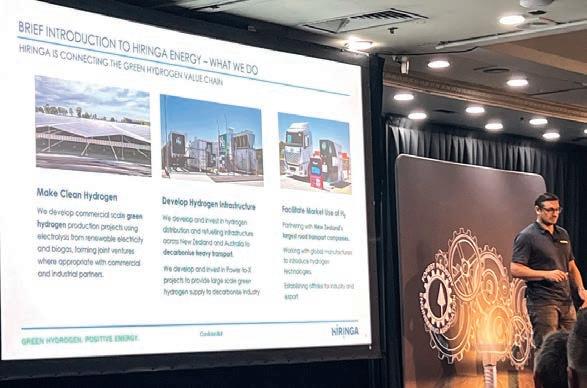
of my life. I started off as an apprentice mechanic and the day I finished, I went out and bought a truck,” he said.
“In those days, it was the D Series Ford. Through the decades, we’ve obviously progressed with technology. We’ve got lane departure, adaptive cruise control, scales on board, bunks, freezers. It’s a long way from our D Series Ford.
“But the one thing that hasn’t really changed is the engine inside the truck. So, taking this hydrogen truck on board was a huge step,” Dennett said.
“I didn’t take it lightly. For the first couple of weeks, I drove it myself because I wanted to evaluate it and see what it was like, how it reacted, how you had to drive it, how you shouldn’t drive it.”
The truck replaced a Volvo truck and trailer and Dennett said it ran like the Volvo.
“I noticed no decrease in the performance. There were no negatives when I compared it with the Volvo. In 12 months and 85,000km later, it’s not spent one minute in the workshop. We are really impressed with it.”
Hiringa is building green hydrogen production and refuelling infrastructure


across New Zealand and Australia. The refuelling stations provide coverage for the key heavy freight routes and are powered by renewable electricity.
The hydrogen is made onsite by using electricity to split water into hydrogen and oxygen through electrolysis. The hydrogen is then compressed and stored onsite before being dispensed into heavy vehicles.
Ryan McDonald, head of new business, Hiringa Energy, said there were many options in Aotearoa in decarbonisation.
“We don’t pretend to think that hydrogen’s going to solve all of them, but we know it’s got a really important part to play here in New Zealand to decarbonise road freight,” he said.
Hiringa has four hydrogen refuelling stations operational in the North Island, covering 95% of North Island freight routes. Over the next four years, the plan is to provide full national network coverage with 24 hydrogen refuelling stations across the North and South Islands with a capacity to provide hydrogen fuel to 2000-plus heavy and medium commercial vehicles.
McDonald said Hiringa had completely mapped out the network across New Zealand.
“New Zealand is unique compared with, say, the United States, where the road transport network is very distributed. In the US, trying to figure out where you put your
stations is a little more tricky,” he said.
“You’ve just got a whole matrix of different hubs, whereas in New Zealand, it’s kind of long and skinny. So, whilst it is not simple, it is a great place to start to decarbonise the country’s freight.
“And because of this network, New Zealand is actually one of the first places in the world to really be able to do this, to get these products into the country. So, we are really privileged in that way.”
Hiringa also displayed a relocatable hydrogen dispensing unit that can now be transported on swing lift trailers. This reduces the barrier to fleet trials and both leverages and supports Hiringa network growth.
Deon Stephens, sales director, Scania New Zealand, provided an update on Scania’s vision to revolutionise transport operations through connectivity advances.
Stephens said Scania was focused on renewable fuels and electrification.
He said the Scania brand would release a new electrification product every 12 months from now and into the future.
“And as we get on with the technology, the batteries are getting better, getting longer and smaller,” he said.
“Our fast, continuous
evolution and ongoing progress means we can offer more variations and configurations, more cab options, multiple machine choices, new batteries and updated management systems and software.
“The end goal that we see from our brand is around electrification of vehicles, but also more importantly for us, it is around maintenance, smart and safe transport.
“When you drive the shift to sustainable solutions, it’s all about partnerships. We need to make sure that we are close to government, close to our customers, but also our customers’ customers.
“We need to make sure that the vehicle is fit for purpose, and we’ll do the job for you as you intend. But a key element is making sure that we’re all like-minded and that we’re all focused on the same outcomes,” he said.
While electrification was the main focus for Scania, Stephens said autonomous vehicles were definitely part of the scene, especially in Europe, and Scania was also testing vehicles in Australian mines.
“It’s very much in its infancy and it won’t be coming to market for quite some time,” Stephens says. “At least 2030, if not 2035.
“It’s coming, but there’s a lot of complexities around private roads and how the vehicles are driven, and the public probably aren’t ready to see trucks driving down the road with no drivers.
As part of its commitment to the NetZero initiative, Fennell Forestry commissioned Australia’s first electric log truck in 2023.
The transport industry is Australia’s second highest contributor to carbon emissions, with a single diesel-powered log truck producing more than 500 tonnes of carbon a year.
Wendy Fennell, managing director, says the trial aimed to provide a smarter, safer, zero-emissions solution to road transport, along with potentially reducing operating costs and offering an alternative to fluctuating diesel prices.
In an update, Fennell said early signs were promising, with the new electricpowered test model saving 100 tonnes of carbon from entering the atmosphere while on the road in the Green Triangle.
“The battery-powered electric heavy vehicle delivers logs from the forest to the sawmill and is suitable for our forest haulage application. The truck delivers on average four B-double loads of logs to local sawmills per shift,” she said.
“Performance off-road is comparable, if not superior, to conventional diesel trucks.”
Fennell said the distance achieved per battery was marginally less than what was expected with the average distance achieved per battery at 250km to 300km.


“Battery range has been a large part of the trial and is closely monitored. Multiple battery changes (back to base) per shift impacts productivity and increase operating costs.
“Upgrades to battery technology are continuous, and we have had six different sets of batteries in operation; there have been no incidents with any of the batteries, nor have we had any heat or temperature concerns while in operations.”
For the first year of the trial, the truck operated at reduced weights and reduced payload.
After lengthy consultation with regulators and government departments, a PBS assessment was conducted and a permit was eventually issued for an increased total mass weight of 70.5 tonnes in February this year.
“The truck hauls the extra weight without difficulty and, to date, has had limited effect on battery range,” Fennell said.
Fennell said driver acceptance had been varied due to the skills required and also the stigma of driving an electric truck among other all diesel fleets.
“To date, we have observed drivers with an interest in electronics and who are also mechanically minded have been best suited to driving this truck,” she said.
“In-depth drive training is required, with both theory and practical components.
Drivers must be multiskilled – battery changing requires forklift training, and drivers must also have good communication skills for regular liaison with the Janus Electric technical support team while in operation.”
Fennell said the company would be looking to collaborate more with industry and government.
“We’ll use our evidencebased data to further understand the benefits of green energy technology and to demonstrate the need for electric heavy vehicles in Australia,” she said.
Other focuses for the next phase include:
• develop economic viability and cost structures to provide customers and government with information on how to reach environment targets while maintaining financial sustainability
• fur ther analysis of operating costs and reductions
• negotiate with customers on how electric heavy vehicles will be remunerated through the supply chain
• battery technology upgrades and potential increase in battery range; and
• continued driver training and support.


Keith Raymond, harvesting and logistics team leader, Forest Growers Research, gave an update on the progress and plans with FGR’s automation and robotics programme.
Raymond said the programme, and developing and deploying automation, would make jobs easier and safer.
“And the potential is in the data – these systems can provide management information to improve supplychain efficiency and that’s dependent on data connectivity and the integration of these systems together,” he said.
“And the other factor is around the human factors. We want to be able to make sure that the work is easier and better for the operators.
“And the only way to do that really is to measure these performance improvements for our workforce so that’s gonna be a big focus of the work for the next couple of years as these

automated systems are coming in.”
Human factor in automation
Raymond said automation wasn’t about replacing people. Rather, it was about:
• Augmenting human capabilities and performance while reducing workload and minimising fatigue.
• Using state-of-the-art technologies and innovation training approaches.
• Suppor ting worker health and wellbeing through smart system design.
“When we talk about automation, it can be a bit scary to a lot of people,” he says.
“They think we are actually taking jobs away but, obviously, in this industry, we haven’t got enough people. We want to do more, and we want to make jobs easier with the people that we’ve got.”


Transcon’s Blake Noble talks about what the industry can do to change its outlook in tough times.
American motivational speaker Zig Ziglar coined the phrase, “It’s your attitude, not your aptitude, that determines your altitude.” It’s a mindset our country could greatly benefit from adopting … right about yesterday.
I wouldn’t for a second claim there’s no real economic pain and challenge going on out there right now; every economic indicator suggests that significant change has occurred (and very quickly), as economic cycles and their history show that it often does.
However, we seem to have gotten our collective selves into a bit of a funk. Let’s call it the South Pacific Pessimistic Plague, which I’d liken to a permanently murky post-Covid hangover, where the chips are so far down and seem to have been for so long that it has become our modus operandi (and a somewhat self-fulfilling one at that) to become increasingly prone to negativity.
I’m the first to admit that I’ve been drawn into this, with the barometer of one’s own situation gauged, not in relation to conventional measures or parameters, but rather against the flow of negative news. It is certainly not healthy, nor conducive to driving the levels of success and aspiration (big or small) we strive for.
The media certainly don’t help, and I’ve all but stopped consuming local print or TV news – there’s simply too much negativity and scaremongering.
I’ve always wondered what our world would look like if the media could only publish successes and project-positive stories. How could that be anything but
hugely motivating and inspiring and flip the negative barometer into a vastly more aspirational iteration?
Without question, the two-or-so year span that kicked off in March 2020, when we first became accustomed to Covid-19 dominating our decisions, created some crazy anomalies that we’d have been nutcases to have thought they would ever become the norm; home lending rates at sub-2%, asset finances rates not
The media certainly don’t help, and I’ve all but stopped consuming local print or TV news – there’s simply too much negativity and scaremongering.
far behind that and freight volumes that seemed magically to grow before our eyes. The expression “what goes up, must come down”, or indeed, “what goes down, must come up”, surely comes to mind.
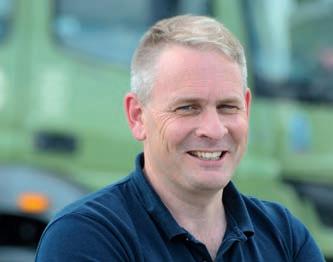
Whether weight, debt, fleet or clutter, there’s no denying that it’s generally much easier to gain than lose these things, particularly when they’ve ballooned in a relatively short time.
With so many operators needing to find a way to shed the gain they’ve made during that crazy heyday, it’s understandable to feel challenged. Yet we need to accept that it’s unlikely to happen by itself without a plan of attack … and the right attitude.
While it appears likely that interest rates will, given time, decline, the reality is that they’ll never (in the foreseeable future) shrink back to the wild lows we saw in 2021/22.
It’s up to us all to work with the numbers and formulate a plan to operate within the bounds in place – more than merely operate, but thrive.
As the saying goes, “Necessity is the mother of invention,” and what a time to pounce on that innovation and creativity and do things like you’ve never done before in a time that’s unlike ever before.
Look offshore; economies aren’t perfect, but a whole lot of green shoots are growing off the back of some serious aspiration. How do we refine our attitude and outlook so that our altitude becomes the positive barometer the country’s crying out for?


We’re incredibly proud to be voted #1 in safety in NZ Trucking magazine 2023 national trucking survey.
From stronger cabs, to smart emergency brakes, to side-detection alerts, our focus is always on the best possible protection for our drivers and fellow road users.



guru Laura Hulley has some no-fuss ways to implement healthier dietary habits.
In an ideal world, all of our meals would be prepared at home – fresh, healthy, delicious and wrapped in a bow. But this is not an ideal world, and it is unrealistic to think that every meal we consume will be nutritious and homemade. So, let’s talk about a realistic way to eat healthily. By taking a straightforward approach, I will share some easy, no-fuss ways to implement better habits into your diet. When I use the word “diet”, I simply mean the foods that you currently eat. We are not referring to a fad or crazy eating regime.
If you haven’t prepared a meal before heading out for the day, google available eating options along your path that day. Plan slightly ahead. Calling into whatever bakery or fast-food restaurant you stumble across is the easier option, but we can do better than that. Nutritious eateries are dotted all over the country. Make an effort to source them out.
A lot of eating regimes involve removing foods or complete food groups from your diet, which typically ends up resulting in binge eating and going wild on the foods you’ve been depriving yourself of. An alternative option is something called “crowding out”. Instead of removing and feeling deprived, you are actually adding foods. I know this sounds counterintuitive, but what you’re trying to do is add more nutritious foods to your diet so you feel less hungry for less nutritious foods. Adding more fruit and vegetables to each
meal, should make you feel fuller and less inclined to snack on that chocolate bar. You haven’t told yourself, “I can’t have that chocolate bar.” You have simply said, “I will eat more fruit and vegetables.” This simple mind-frame adjustment can hopefully help prevent the feeling of deprivation and binge eating.
People bang on about portion sizes, and we are all a bit sick of hearing about it. Unfortunately, it significantly affects our health and weight goals. Being mindful of portions allows us to enjoy all the foods we would like without having to remove treats. There are plenty of guidelines regarding recommended serving sizes – they’re often written on food packaging. For example, a row of chocolate is considered a healthy serving size. If we are looking at a dinner plate, your meat portion should be roughly the size of your palm or a quarter of your plate; your vegetables should make up half the plate, and carbohydrates the final quarter. The variant here is obviously the size of your plate. Dinner plates tend to be huge by today’s standards, so be mindful of how large your plate is.
They say, ’Fail to prepare, prepare to fail’ –this also applies to eating. Meal prepping has become a massive part of the health and fitness industry, with global companies selling premade, microwaveable meals. But we can replicate this ourselves at home. It may seem daunting or like you don’t have enough time to spend hours meal prepping each week, but we can keep this low-key and simple.
For example, you are cooking dinner anyway, so there’s no harm in making enough for three or four dinners/portions. You could always take leftovers for your lunch the next day. This can apply to breakfast and lunches – you’re making that meal anyway, so you may as well make it
in bulk and save yourself time in the long run. You don’t need to make complex meals with 50 ingredients and fill 40 containers with different options. Just ensure you have meals ready or at least organised in your head for the next day.
Alcohol is a part of most people’s lives, whether it be a few cheeky beers on the weekend or a drink or two after work/with dinner. I understand that telling people not to consume alcohol is often unrealistic or unnecessary in the scheme of things. But it is something to be mindful of. You may think that a couple of beers every night after work is harmless, but if you have three beers a night for five nights, that’s 15 beers a week. It is best to be mindful of our drinking – when related to health and fitness goals, alcohol adds extra calories and may result in us feeling unmotivated to exercise the next day.
Instead of overwhelming yourself with complex eating regimes, look at what you’re currently doing and implement small and simple strategies to make positive changes. You will be amazed at how big a difference small steps make to overall health and wellbeing.

Laura Hulley Personal trainer




Over the past couple of decades, technology has dramatically changed how people work.
Work-life balance and a positive workplace culture should be top priorities. People collaborate more in open-plan offices or work remotely instead of occupying desks in cubicles in big office blocks. Business is changing, and staff development is more important than ever because of how quickly things are changing.
People have told me that they would stay long-term with an organisation that invested more in employee education and development. This can improve company culture, increase productivity, and support workplace safety.
Any instructions or activity that gives workers new skills or enhances their existing abilities is considered employee training. This can be from teaching the “new kid on the block” the ins and outs of a specific job to providing safety training for the entire staff.
Providing employees access to high-quality training/development gives them more job
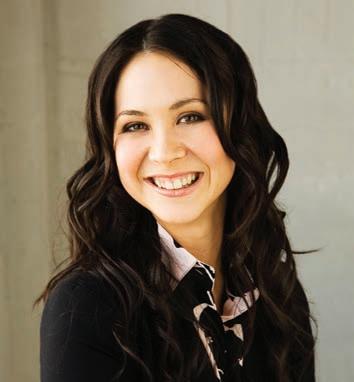
confidence and increases satisfaction. Other reasons employees appreciate good training include:
• increased autonomy in the workplace
• a safer work environment
• the feeling of support and encouragement from their employer
• acquiring skills and knowledge that may lead to career advancements; and
• developing a great understanding of their roles and the roles of others.
It goes without saying that contented and trained workers are advantageous to any organisation. When employees are happy, they are less likely to look for opportunities elsewhere, which lowers your turnover rate. Other reasons employee training is beneficial to the organisation include:
• safer workplace
• increased profits due to better performance and higher productivity
• enhanced organisation recognition as workers rave about how much they love their jobs at the company
• increased worker participation and enthusiasm
• improved company culture
• a morale boost for all; and
• the ability to implement new processes with greater ease.
It is important that employees receive adequate training. Giving them the skills
they need to perform their jobs well starts with training. By training staff, you can raise the calibre of their work and increase productivity throughout the whole organisation. Staff development is an ongoing process of investing in your employees’ skills and knowledge as well acquiring new essential qualities.

Kaye Byrne is a health and safety consultant who works for Safewise, a health and safety consultancy organisation. Kaye has been in the health and safety field in one way or another for the past 10 years, most recently as a consultant. Kaye has experience working with many different industries and people. She holds a New Zealand Diploma in Workplace Health and Safety Management (level 6) and is a member of the New Zealand Institute of Safety Management.

New Zealand Certificate in Commercial Road Transport (Heavy Vehicle Operator) (Level 3)
This programme will provide you with the skills and knowledge to safely and competently operate heavy rigid vehicles or heavy combination vehicles. This programme goes beyond vehicle licence requirements to enable improved job performance and enhanced employment opportunities – whether you’re new to the commercial road transport industry or an existing heavy vehicle driver.
Enrol at mito.nz/hvo
New Zealand Certificate in Commercial Road Transport (Specialist Driver) – Transportation of Logs (Level 4)
This programme provides heavy vehicle drivers with the skills and knowledge required to safely and competently operate heavy combination vehicles, to ensure the efficient transportation of logs.
Enrol at mito.nz/logtransport

MITO is a business division of Te Pūkenga – New Zealand Institute of Skills and Technology. We support on-job learning and career development for the automotive, transport, logistics and extractive industries.
Last month, I summarised some of the legal rights and protections enshrined in the New Zealand Bill of Rights Act 1990. These primarily related to the early stages of an encounter with the police before being charged. Of course, you also have rights once you have been charged, and they continue as you prepare your defence. If your rights are breached, there are remedies you can pursue, but these are dependent on the nature of the breach.
Everyone arrested for an offence has the right to be charged promptly or released. If there is a question about the validity of the arrest or detention, everyone has the right to have this determined without delay by bringing a writ of habeas corpus to the court and to be released if the arrest or detention is not lawful. If you have been charged, the police must promptly inform you in detail of the nature and cause of the charge.
If you do not have a lawyer at your first appearance, you can speak to one of the duty lawyers at court for some free preliminary advice. Duty lawyers are generally not available for a defended hearing or sentencing, so unless you want to represent yourself, it is a good idea to apply to have a legal aid lawyer assigned to you before your next appearance if you can’t afford to instruct private counsel.
Once you have been brought to court, you have the right to be bailed on reasonable terms and conditions unless there is just cause for continued detention until your next court date. You may be required to sign a bail bond with conditions, and if you breach the terms of your bail, you can be arrested without a warrant and brought before the court to determine whether you should be re-admitted to bail.
When considering whether a bail condition should be imposed, the starting point is section 8(1) of the Bail Act 2000, which requires that the condition must be reasonably necessary to ensure that the defendant appears in court, does not interfere with any witness or evidence and does not commit any offences while on bail. There must be a rational link between the condition and the reason for its imposition. For example, a bail condition “not to consume alcohol” would not be appropriate if there was no evidence alcohol was being consumed by the alleged offender at the time of the incident.
A person who has been charged has the right to adequate time and facilities to prepare a defence. This includes the right to see all the evidence the police have against you. It is a good idea to formally request full disclosure because if you don’t, it may be assumed that you only want to see the summary of facts and your list of previous convictions (if any), which is called initial disclosure.
Equally, you have the right to be tried without undue delay, be present at your trial and offer a defence. That means that you have the right to examine witnesses for the prosecution and to obtain the attendance and examination of witnesses for the defence under the same conditions as the prosecution. You also have the right to a fair and public hearing by an independent and impartial court, and you are presumed to be innocent until proven guilty. These rights are fundamental to criminal procedure because they recognise the equal dignity and worth of all persons.
Every person charged has the right to have the free assistance of an interpreter if he or she cannot understand or speak the language used in court, and you do not have

to give evidence at your own hearing. If the penalty for the offence changes between the time you committed the offence and the time at which you are sentenced, you have the right to the benefit of a lesser penalty. You cannot be convicted of an offence if the act in question was not a criminal offence at the time it took place, and you cannot be tried or punished for an offence if you have already been acquitted or convicted of the offence or if you have been pardoned for it.
If you are convicted of an offence, you have the right to appeal to a higher court against the conviction, the sentence or against both. Before doing so, it would be wise to obtain documents relevant to the appeal, such as the judge’s notes of evidence, to seek advice from a lawyer about whether there are legitimate grounds for an appeal. While an oral hearing of an appeal is the norm, the Court of Appeal can dispense with such a hearing and decide a case on the papers alone. However, in making such a decision, the court must conclude that the appeal “can be fairly dealt with on the papers” and “either has no realistic possibility of success or clearly should be allowed”.
If the police breach any of the rights contained in the act, there are several potential consequences. One is that any evidence obtained can be excluded. Another consequence is that they may be ordered to pay money to you to compensate you for the breach of your rights. It is important that you obtain the advice of a lawyer to see if these options may apply in your case.
Next month, I will be changing direction to focus on police powers that can be exercised in relation to heavy-transport drivers and operators.
Please note that this article is not a substitute for legal advice, and if you have a particular matter to be addressed, you should consult with a lawyer. Danielle Beston is a barrister who specialises in transport law, and she can be contacted on (09) 985 5609 or 021 326 642.


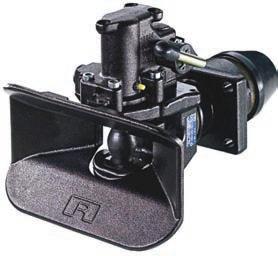











In today’s rapidly changing and uncertain landscape, understanding your business’ vital signs is more crucial than ever. These essential metrics are the lifeblood of an enterprise, ensuring that it operates smoothly and can withstand any turbulence that comes its way.
Businesses often struggle because they fail to keep track of critical numbers. Without knowing where your leads originate, how effectively you convert them into customers, or the overall value these customers bring, your business could face chaos and an uncertain future.
Conversely, those who stay on top of their metrics can anticipate trends and pivot effectively, transforming challenges into opportunities. These businesses are not merely surviving; they are thriving. Monitoring key metrics is incredibly important.
Balance sheet ratios
One of the most important aspects to monitor is your balance sheet ratios, particularly the equity you hold in the business. In challenging times, like those we face today, it’s essential to maintain more equity than during prosperous periods. Consider a property investor who benefits from rising property values in good times; a 20% equity might suffice. However, during downturns, higher equity is necessary to avoid excessive debt and interest burdens.
Keeping a close eye on your key performance indicators (KPIs) is critical
for sustained success. Some of the most important KPIs include:
• Revenue growth: This measures the increase in revenue over a specific period and indicates the overall financial health of your business. Continuous revenue growth signals a thriving business.
• Profit margin: This KPI shows the percentage of revenue remaining after all expenses are deducted, reflecting the efficiency of your operations. A healthy profit margin is crucial for long-term sustainability.
• Customer acquisition cost (CAC): Understanding the cost of acquiring new customers provides insight into the effectiveness of your marketing and sales strategies. Lowering CAC while maintaining or increasing customer quality is a key objective.
• Customer lifetime value (CLV): This estimates the total revenue you can expect from a single customer over their lifetime. Knowing your CLV helps guide decisions on customer retention and loyalty programmes, ensuring you maximise the value of each customer.
Staying agile and informed is the best way to navigate uncertainty. By closely monitoring these vital signs, you can make informed decisions that keep your business resilient and poised for growth. The ability to quickly adapt to changing conditions allows you to not only weather the storm but emerge stronger.
Keeping a watchful eye on your business’ essential metrics is paramount, especially in times of change and uncertainty. You can ensure your business remains robust and successful by maintaining a strong balance sheet, understanding key performance indicators and staying agile.
With the right insights, your business can not only survive turbulent times but thrive and grow, emerging even stronger on the other side.

Roylance Watson is a chartered accountant and associate at Vazey Child Chartered Accountants in Hamilton.
Email: roylancew@vazeychild.co.nz
Phone: (07) 838 5988 Website: vazeychild.co.nz






























VALID 1ST JUNE - 31ST JULY 2024












SPEND $100* ON PARTICIPATING BRANDS TO GAIN ONE ENTRY INTO THE DRAW.







WIN A DOUBLE PASS TO THE ULTIMATE SEMA 2025 EXPERIENCE.

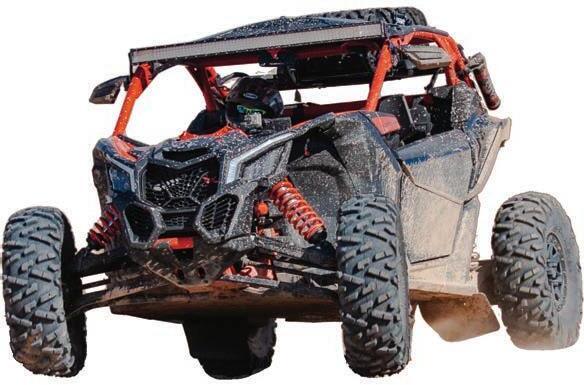
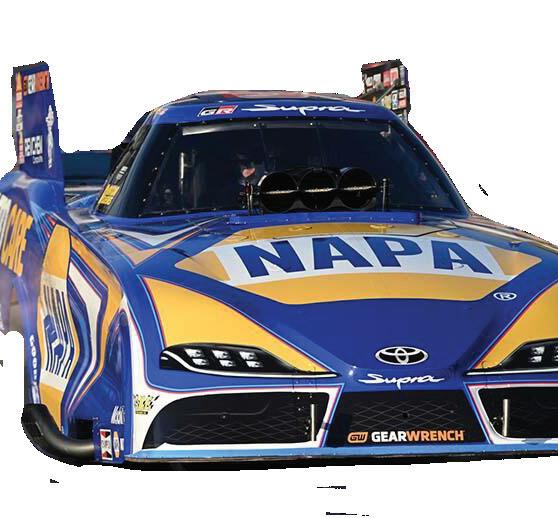

I love innovation, love technology, and love efforts to decarbonise transport, so what’s not to love about hydrogen? The simplest atom is about to show it’s far from simple when powering transport.
We all know why we’re on the alternative fuel journey: diesel and petrol are brilliant fuels except for those damned emissions putting everything we value under threat. And the $10 billion health costs they land on New Zealand every year. And the environmental devastation their extraction causes. Oh yes, and those oil wars …
There are lots of compelling reasons to quit fossil fuels, but the heavy transport sector knows that’s easier said than done, so where might hydrogen fit in?
Hiringa Energy is behind an embryonic “green hydrogen” (hydrogen extracted by electrolysis using renewable electricity) refuelling network in the upper North Island, and Transport Minister Simeon Brown has been on RNZ, extolling the potential of “white hydrogen”. But most of the world uses grey, brown or black hydrogen made – with massive emissions – from fossil fuels.
Obviously, there’s hydrogen and hydrogen and, even though it’s a clear gas, its kaleidoscopic names reveal how it’s made.
Notwithstanding Brown’s enthusiasm for white hydrogen, it’s unlikely to boost New Zealand’s energy prospects: the world’s biggest known deposit, under France, would only keep the US going for six weeks. Which makes green hydrogen of particular interest. So, what’s to love about green hydrogen?
There is heaps around (think “water”); it can be low emissions (but not zero, as a GNS scientist claimed on The Detail podcast); it’s portable, with high energy density (but occupies many times the volume of equivalent diesel); and hydrogen trucks fill quicker than batteries, albeit slower than diesel.
Plus, transitioning off diesel can be easier with hydrogen than with battery trucks.
And what’s not to love? Well, spectacular energy inefficiency is centre stage: a battery truck returns say 80% of the energy the grid generated, while hydrogen struggles to reach 30%. “The rate at which battery electric vehicles outstrip both hydrogen fuel cell electric vehicles and hydrogen combustion engines on efficiency is astronomical,” Cummins’ GM for hydrogen, Jim Nebergall, wrote in Hydrogen Insight. (Nebergall, instead, pitches that hydrogen makes it easier to transition off diesel.)
But Hiringa’s CEO Andrew Clennett considers hydrogen’s feeble energy efficiency has been overplayed and “is only telling part of the story”. He highlights hydrogen’s potential benefit to “enable system efficiency for the electricity and heavy vehicle sector,” partly by levelling out electricity peaks by generating hydrogen when the grid has surplus, and shutting down their electrolysers during times of high demand.
“The rate at which BEVs outstrip both H2-FCEVs and hydrogen combustion engines on efficiency is astronomical…”
Retired professor of power engineering
Pat Bodger isn’t convinced. He notes that the existing grid is already “highly efficient” at over 90% and that, with increasing electrification of society, “the troughs and peaks of generation have evened out”.
Maybe storing energy as green hydrogen can help ease challenges for a decarbonised grid, but it’s a big “maybe”. The claims seem short on facts to back them, and the best report I found concluded, “There is a paucity of studies that integrate hydrogen supply chains with the functioning of electrical power grids.”
So, the jury is still a long way out on how much sense hydrogen makes for transport. Next time, I’ll unpick what this means for reducing emissions. It’s no surprise that that’s what I’m really chasing.

Lindsay Wood, MNZM, runs climate strategy company Resilienz Ltd. He is active in policy, and on IT tools for decarbonisation, and speaks, writes and broadcasts widely on climate issues. In 2024 he was made a Member of the New Zealand Order of Merit for services to climate awareness and environmental sustainability.



11.5M GLIDEMSTER TRAILER , 7.5m GLIDEMASTER TRUCK BODY, WITH TAIL LIFT

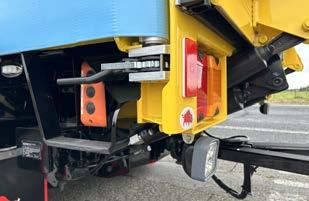
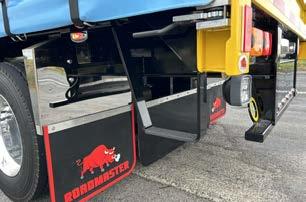

Customised FOr:
P & S Hornell limited

FEATURES:
• Custom Cart Dock infill
• 22 mm duopan rear wall
• Stainless steel lightbars
• Hella LED lighting package
• Intergrated curtain tensioner with stop tail light mounting, remote controller mount and metro step
• Stainless steel guards
• Roadmaster mudflaps
• Metro step
• Curtain tensioner
• Alloy tool box with shelf,
• Stainless steel doors
• Over size alloy dunnage box

NZ Trucking Association can be contacted on 0800 338 338 or info@nztruckingassn.co.nz
Carol McGeady general manager

Employment New Zealand is intensifying its scrutiny of the road freight sector, dedicating significant resources to investigating potential migrant exploitation under the Worker Protection (Migrant and Other Employees) Act 2023. This increased focus means that transport operators must be vigilant and proactive in ensuring compliance with all relevant laws and regulations. Understanding your responsibilities and obligations is crucial to maintaining a fair and lawful workplace.
“Doing the right thing by your employees is not just about compliance; it’s about understanding your obligations and creating a fair and safe working environment,” says David Boyce, CEO, NZ Trucking Association.
“Ensuring that every worker, regardless of their background, is treated with respect and given their due rights is fundamental to the integrity of our industry.”
To help you navigate these changes, here are the key provisions of the act you need to be aware of:
• Immigration officers now have the authority to request employment documents to verify compliance with visa conditions and employment laws. Employers are required to provide these documents immediately or within 10 working days if immediate compliance is impractical. These documents include wage and time records, leave records and employment agreements. Ensuring these records are accurate and readily available is essential.
• The act facilitates information sharing between immigration officers and other regulatory agencies, such as the Inland Revenue Department and WorkSafe. This provision ensures comprehensive oversight and compliance across various legal frameworks, highlighting the importance
of maintaining consistent and lawful employment practices.
• Employers can face substantial penalties for non-compliance. Infringement offences include allowing someone to work without the right to do so, employing individuals contrary to visa conditions, and failing to provide required documents. Penalties range from fines of $1000 to $3000 per infringement, with maximum fines doubling in court proceedings. Understanding and adhering to these requirements can help avoid costly penalties.
• To promote compliance and transparency, the names and details of employers convicted of offences or issued infringement notices can be published. This includes the nature of the offence and any restrictions imposed. This public disclosure serves as a strong deterrent against non-compliance and emphasises the importance of lawful practices.
As an employer, it’s essential to ensure that you provide written employment agreements. These are mandatory for all employees and should be comprehensive and clear. Similar to tax records, employment records must be kept for a minimum of six years. This includes detailed records of wages, hours worked and leave taken. Additionally, you must comply with minimum employment standards. This includes paying at least the minimum wage, providing rest and meal breaks, and ensuring entitlements to leave (sick leave, bereavement leave, parental leave, and public holidays) are honoured.
Recognising the signs of exploitation is crucial for ensuring the wellbeing and fair treatment of migrant workers. Exploitation
can manifest in various ways, often starting with the absence of written employment agreements. Workers may also be required to pay fees to secure their jobs, which is another red flag. In some cases, migrant employees are forced to return part or all of their wages to their employer, receive too little or no pay for their work, or are not compensated for all hours worked. Additionally, some employers may ask workers to falsify their working hours, impose excessive working hours without appropriate breaks, or deny them time off altogether. Lack of payment for public holidays or annual leave is another common issue. In severe cases, workers may be unable to leave their workplace because doors and windows are locked, or they may need permission to eat, sleep, or use the toilet. Exploitation can also occur when an employer forces an employee to perform unrelated tasks, such as cleaning their home, or threatens to report them to Immigration New Zealand. Other indicators include making employees work more hours than their visa allows, providing accommodation as part of wages but charging more than legally allowed, and threatening the employee or their family with harm. Employers keeping employees’ passports is a further serious sign of exploitation.
Understanding these signs and taking action to prevent and address exploitation is vital for maintaining ethical standards and ensuring the rights of all workers are upheld. With Employment New Zealand ramping up its oversight, it is more important than ever for transport operators to adhere to these regulations. Compliance not only helps avoid penalties but also maintains the trust and integrity of our industry.
For more information and guidance on how to meet these obligations, please call our team on 0800 338 338 or visit the Employment New Zealand website, employment.govt.nz.
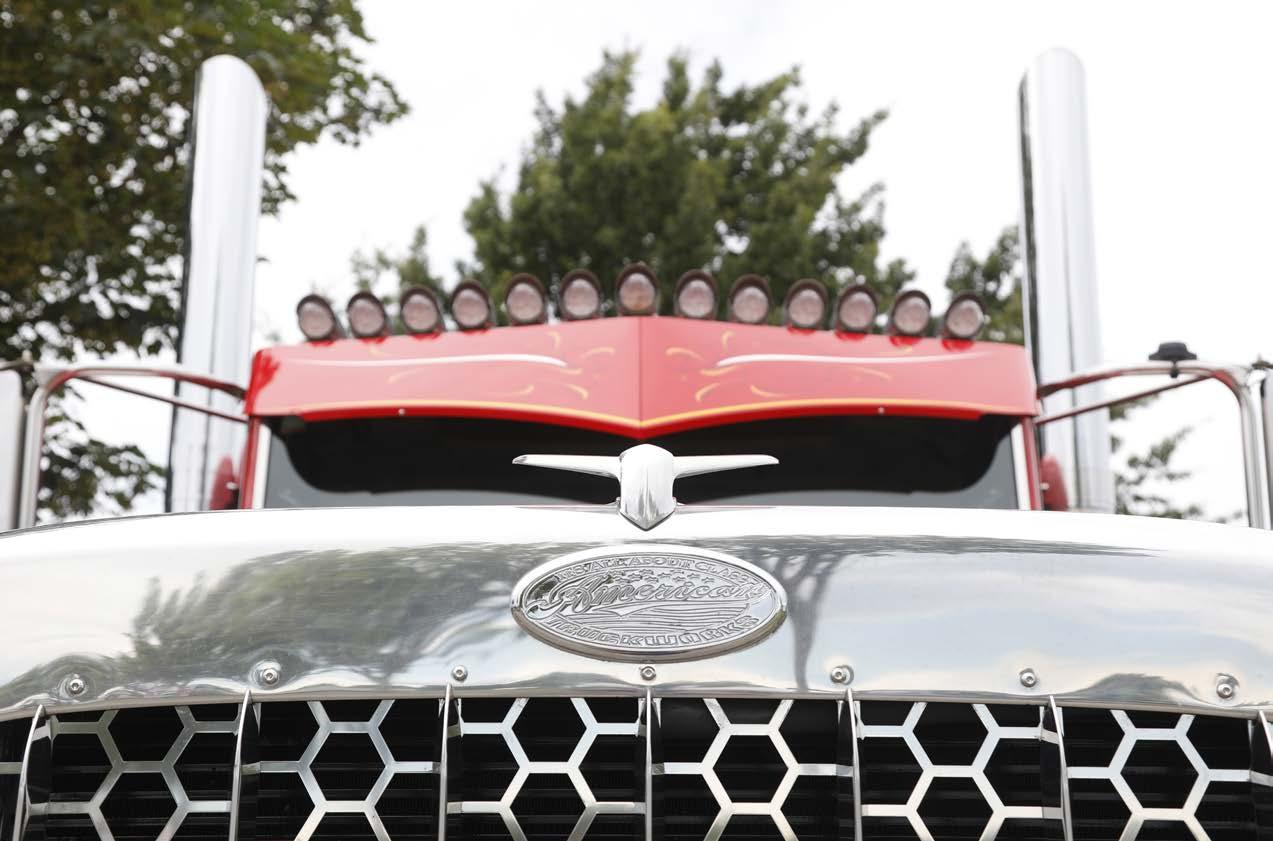
















National Road Carriers Association can be contacted on 0800 686 777 or enquiries@natroad.co.nz

James Smith GM policy and advocacy
On 30 May, Finance Minister Nicola Willis delivered the Government’s 2024 Budget. The Budget contained several measures that will significantly impact the freight industry, including substantial investments in infrastructure. These will begin to address the deficit in investment in New Zealand’s transport networks, hopefully returning them to a state that supports the sector’s growth.
The Budget allocates more than $68 billion to infrastructure projects over the next five years, focusing heavily on transport. This includes $2.68 billion dedicated to roads, rail and public transport, with specific funds for constructing 17 new Roads of National Significance and the Rail Network Investment Programme. These enhancements aim to improve the efficiency and reliability of freight transportation.
A new $1.2 billion Regional Infrastructure Fund is designed to bolster regional economies through new and existing infrastructure projects. This fund is expected to improve regional freight routes and reduce logistical bottlenecks.
More than $1 billion is allocated for cyclone relief, resilience and emergency preparedness, including nearly $939 million
for the New Zealand Transport Agency and local councils to repair and upgrade local roads and state highways. This is crucial for maintaining and improving the resilience of freight routes affected by natural disasters.
These measures demonstrate the Government’s commitment to supporting the freight industry through improved infrastructure, enhanced regional
National Road Carriers’ focus now shifts to ensuring as much of the allocated money gets spent where our members need it…
connectivity, and increased resilience to environmental challenges. These investments should support freight operations and reduce total cost of ownership, ultimately benefiting the broader economy.
National Road Carriers’ focus now shifts to ensuring as much of the allocated money gets spent where our members need it and that every dollar is used to deliver quality infrastructure that will stand up to the demands of a soon-to-be-growing-again economy.
The bigger picture is how New Zealand fixes the growing deficit between the
revenue it collects from transport users and the cost of building and maintaining networks.
The Government is exploring alternative funding and delivery models for major transport investments, including Public Private Partnerships (PPPs) and value capture mechanisms. These approaches are intended to generate additional revenue and deliver infrastructure projects more efficiently, which could lead to faster completion and better-maintained transport networks. None of these are revolutionary ideas and there are plenty of examples globally where they have been used. National Road Carriers will keep an eye on proposals to use any of these alternatives to ensure they stack up and deliver value.
The most important message that came through on 30 May was that this is a government planted in reality that understands the importance of GDP growth and that every dollar of government money is generated by someone else who produces something and, therefore, needs to be spent wisely.
For that, we are grateful and we look forward to ensuring members see tangible results as their tax money is spent.
As always, please contact any member of our team on 0800 686 777 with any ideas, queries or feedback.






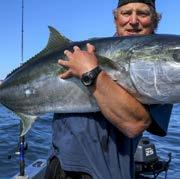
NZ’s first transport-dedicated radio with music, roading information transport news, interviews and more.
Everything you need to keep you going on the road. Trucking industry news and interviews | Roading Reports with Kiwi Truck Tyres | UDC Business of Trucking with Cameron Bagrie | Sport with Clint Brown | The Brolube and AC Filter Fishing Report with Mark Kitteridge | Clean Co Truck Wash Weather Report | News on the hour | And the best classic rock and country music!






With you on the road 24/7

Transporting New Zealand can be contacted on (04) 472 3877 or info@transporting.nz
Dom Kalasih interim chief executive

It’s a hard slog for road transport operators, as tough economic conditions continue to bite. Rising costs, high interest rates and public sector job cuts have all taken their toll.
So, it was heartening when the government confirmed in Budget 2024 that it would plough more money into big roading and infrastructure projects. The long-term benefits will far outweigh the costs – and we have all seen the rising costs of not investing in these critical areas.
New Zealand roads have been underfunded for decades, and it is holding back economic growth, vital for the community and businesses.
To sum up the main points, the Budget announced the government will spend $1 billion to accelerate land transport projects, including Roads of National Significance. This is on top of $3.1 billion already signalled in the Government Policy Statement.
Other transport investments include $939 million to repair roads damaged by last year’s severe weather events in the North Island and $200 million for maintenance and renewals on the national rail network.
Another $1.2 billion will go to the new Regional Infrastructure Fund, and the government will also establish a National Infrastructure Agency.
So, the increased investment is long overdue, and we welcome the support and commitment by Transport Minister Simeon Brown. However, while this investment will make a difference, it won’t happen overnight. Right now, road transport operators are doing it tough.
Transporting New Zealand is hearing from
many members who have seen revenue drop significantly over the past few months. Many trucking firms haven’t seen the traditional post-Christmas uptick in business. Bulk and aggregate and logging operators were some of the worst affected.
Transporting New Zealand account manager Lindsay Calvi-Freeman has been speaking with members across the lower North Island. He says some have reported their revenue is down 40% on last year, while others have been forced to lay off staff.
Fellow account manager Odette Geyer says the pain is being felt across the supply chain. She says liquidations have increased, driven by the lending costs and reduced business confidence. In May, three transport liquidations were announced in three days. The road freight industry also supports a whole range of suppliers, so tough conditions for our members have a significant flow-on effect.
Vicki Harris, who manages Transporting New Zealand’s member benefits and commercial partners, says she has noticed an increase in members looking for savings across fuel, insurance and supplier services. She says members are looking to cut expenditure and maximise their “bang for buck”. We’re seeing many referrals through to Transporting New Zealand’s supplier discount schemes, including fuel and tyre retailers.
The latest economic data support the tough operating conditions reported by trucking operators. The Reserve Bank noted in its May 2024 Monetary Policy Statement that economic indicators have been weak, as growth remains subdued. The Reserve Bank
isn’t forecasting an official cash rate cut and associated interest rate relief until mid-2025.
The April 2024 ANZ New Zealand Business Outlook survey reported business confidence fell across every sector from March to April 2024. The March 2024 NZIER Quarterly Survey of Business Opinion showed net 23% of firms reported a decline in activity over the March quarter. This is in line with the feedback Transporting New Zealand receives from members.
There was more welcome news in the May 2024 ANZ Truckometer, showing the heavy traffic index up 3.3% higher than 12 months ago (using a three-month average), and rising 0.3% month to month. The heavy traffic index tracks the flows of vehicles weighing more than 3.5 tonnes on 11 key roads and has a strong contemporaneous relationship to GDP. However, the Truckometer doesn’t reflect factors like reduced loads, or vehicle movements outside of those identified routes, which will impact Transporting New Zealand’s membership and the wider road freight industry.
We’re still confident that the road freight industry will navigate the difficult economic conditions as it has with previous challenges.
Over the past few years, we’ve seen road freight operators successfully deal with the Covid-19 pandemic and severe pressures on the supply chain, acute driver shortages and cost pressures, and now the dual challenges of an economic recession and continued inflationary pressure.
Things are tough, but road freight firms are very resilient.


NZ Trucking is New Zealand’s leading magazine for both the industry and the enthusiast, featuring the latest heavy truck and light commercial road tests, product news, and trucking personalities.
Subscribers will also get access to the digital magazine, meaning you can read it anywhere, at any time!
NZ Trucking is New Zealand’s leading magazine for both the industry and the enthusiast, featuring the latest heavy truck and light commercial road tests, product news, and trucking personalities.
Pricing for subscriptions include postage and GST. Postage included.
You will also get access to NZ Trucking Magazine on ISSUU. You will be emailed a login when the next issue is available.
Pricing for subscriptions include postage and GST. Postage included. ph 0800 878 256 or visit NZtrucking.co.nz/subscriptions
Phone: 0800 878 256 or visit: NZTrucking.co.nz/Shop


Those who are interested hopefully will have by now diagnosed the Budget and worked out how it affects them. Of course, pre-Budget, many groups called on the government to do more in their specific areas of interest. I had not heard of some of these until they popped their heads up.
As expected, post-Budget, there were just as many, if not more, getting vocal that the government did not do enough in such-andsuch an area. For just a moment, these people need to stick their heads above the grey cloud over us and see that there is no money. The country is almost broke, so it will take time to satisfy everybody’s wishes and, even then, some will still not be happy.
There may be a bit of comfort for us all when, in her speech on 9 May, the Minister of Finance, Nicola Willis, said, “It is darkest before the dawn.” Only time will tell. Given the issue the country is having with electricity supply, her reference to “dark” may prove to be quite prophetic.
It is annoying to listen to the blame game about whose fault it is that our power supply is in such the precarious state it is now.
The problem has been looming for years; it certainly is not new. I can remember that as a youngster, we often faced rolling power outages. But we managed. Like many things in New Zealand, we have been living beyond our means when it comes to power use, and we are now going to have to pay the price. So much of the recent discussion focuses on what we can achieve in five or 10 years.

Information provided by Stats NZ shows that during 2023, there was an average of 153 company liquidations and nine receiverships each month. For the first three months of 2024, there were 163 and 12, respectively.
This is fine, but the problem exists right now, today. There is cold comfort in knowing that in five years’ time, I should be able to turn the heat pump on when I want but, at the moment, it’s a treat.
A couple of simple things could be done immediately to help us get through the problem. Many organisations have emergencygenerating plants, usually run on diesel. Why couldn’t these organisations use them to keep their businesses working during peak load times, thus taking some pressure off the national grid?
The second suggestion, and this has happened before, is to get one or two ships laid up overseas with a high power-generating capacity and park them up in a port – Auckland, for instance – and feed their power into the grid to offset peak loading. Yes, they would have to be compensated for the cost, but the electricity suppliers have been making plenty of money, so they can do it.
You don’t have to look far to see just how bad the economy is. Daily, there are notices about businesses going into liquidation. No industry is immune from this, including road transport. Information provided by Stats NZ shows that during 2023, there was an average of 153 company liquidations and nine receiverships each month. For the first three months of 2024, there were 163 and 12, respectively. For every one of these businesses, people are affected and in the vast majority of cases. It is not their fault. They are victims, victims of circumstances they had no control over. We should be empathetic towards them.
The number of job positions in the public service to be dispensed with continues to increase. I found it more than ironic, then, to read on 30 April that the chief executive of NZTA told staff, “It could be a lot worse.” Worse than what? Who has overseen this organisation’s staff growth over recent years? What responsibility is born by the executive team of NZTA?
It reminds me a bit of the 1959 movie I’m All Right Jack. Something I have experienced recently – and is most likely a side effect of the uncertainty pervading the public service – is the change in attitude to providing help and assistance to the public. It appears that the days of being helpful are gone, and it is now about building even higher walls that we, their salary and wage payers, have to jump over. I guess, though, it is making work for block layers.
The Accidental Trucker


















SERIOUSLY BADASS.




scania.co.nz







